
 Fondazione Edmund Mach
IASMA Research Centre
Fondazione Edmund Mach
IASMA Research Centre


FRONT COVER
The sequencing of the grapevine (cv Pinot Noir) genome was completed in 2007 by an international consortium led by IASMA scientists. This represents a historical achievement for the Institute, an important milestone for viticulture research.

FONDAZIONE EDMUND MACH
President
Giovanni Gius
Managing director
Alessandro Carlo Dini
RESEARCH CENTRE
Director
Roberto Viola
Scientific relations
Floriana Marin Administration
Roberto Maffei, Luigi Conter
Secretary
Mirtis Conci
Phone: +39 0461 615145 - Fax: +39 0461 650956
Web: http://research.iasma.it
e-mail: research@iasma.it
Annual Report IASMA Research Centre 2007
© 2008 Fondazione Edmund Mach, Via E. Mach 1 – 38010 San Michele all’Adige (TN), Italia
Reproduction in any form is prohibited
Managing editor
Roberto Viola
Editorial committee
Claudio Ioriatti, Fulvio Mattivi, Ilaria Pertot, Nico Salmaso, Marco Stefanini, Claudio Varotto, Riccardo Velasco
Editorial staff
Floriana Marin, Lucia Martinelli
Photography
Gianni Zotta; Palma & Associati still life; IASMA archive; SafeCrop archive; CSBT archive; AB Applied Biosystems
Concept and layout
Palma & Associati
Printing
Litotipografia Alcione
ISSN 1972-6082
5 Annual Report IASMA Research Centre 2007 TABLE OF CONTENTS PART 1 | PREFACE pag. IASMA President 7 Research Centre Director 9 The Institute 10 About the Research Centre 14 PART 2 | DEPARTMENTS AgriFood Quality Department 19 Chemical analytical strategies to protect and promote organic commodities 21 Improved immobilisation technology for wine micro-organisms 23 Factors affecting the mineral composition of grapes and wine 25 Characterisation of ellagitannins and their importance for the promotion of the healthy properties of soft fruits 27 In brief 29 Facilities and Equipment 31 Agricultural Resources Department 32 Agronomic evaluation of three AP resistant rootstocks in Trentino 34 Assessingthe suitability of alpine pasturesfor sheep and goats 37 Parameteri-sation of an empirical ripening model for eleven grape varieties 39 In brief 41 Facilities and Equipment 43 Genetics and Molecular Biology Department 44 Grapevine resistance to pathogens: a genomic overview 46 Towards a ‘marker free’ transgenic grapevine: comparison of different strategies 48 QTL mapping of volatile compounds in apples detected by PTR-MS 50 In brief 52 Facilities and Equipment 56 Natural Resources Department 57 Allergenic pollens: new techniques for identification and quantification 59 Ecological assessment and sustainable management of cypress in the landscape 61 Use of respirometric tests to assess the biological stability of biomass 63 The ecology and experimental restoration of Lake Canzolino 65 In brief 67 Facilities and Equipment 69 Plant Protection Department 70 Communication mediated by Semiovibratio-nals and Semiochemicals 72 in Scaphoideus titanus,
dorée Trichoderma atroviride SC1:
of
diseases 74 In brief 76 Facilities and Equipment 78 PART 2 | SPECIALTY CENTRES Centre for the Study of Biodiversity in Trentino 79 Phenotypic variation in reproductive traits in natural plant populations 81 Facilities and Equipment 83 SafeCrop 84 A glimpse of the future of sustainable plant protection 86 PART 2 | ANALYTIC SERVICES Services and Support to Stakeholders 88 PART 3 | OVERVIEW Research Projects 91 Affiliations 96 Editorial Board Participation 97 Recognition 97 Academic Theses at IASMA in 2007 98 Publications 2007 99 Staff 109 GETTING TO SAN MICHELE ALL’ADIGE 119 ACKNOWLEDGEMENTS 121
vector of grapevine Flavescence
a new, patented fungal strain for biocontrol
plant

It is my pleasure to present the second edition of the Annual Report of the IASMA Research Centre which describes the scientific activities carried out in 2007. It was a very important year for our institution, during which the preliminary steps were taken on a course which has led to a change in the legal status of IASMA, from a functional public body of the autonomous Province of Trento to a private company but with public investment: the Edmund Mach Foundation. This has not been a superficial reorganisation: we are convinced that the new arrangement will be more in keeping with the demands of an institution whose staff, activities and structures are continually growing.
A challenge lies ahead of us. A challenge like many others that this institution has faced in the almost 135 years of its history, but this time requiring particular attention to be paid so that we never forget our origins, that is, where we came from and why we exist. The strength to confront this challenge will come from a balance between the three pillars of education, research and technical consultation and from co-operation between the people who work in those fields.
The Research Centre in particular, the object of this publication, has invested its human and structural resources in areas of research where intuition, collaboration and ideas are especially fertile, while keeping constantly apace with scientific progress and strategic development.


We want the new Mach Foundation to have the flexibility necessary to work within a framework where cultural relations and interactions are an important part of the way the new Europe - and the global world in its broadest sense - is gradually remodelling the approach to research. For this reason, the Foundation will, as far as is possible, maintain the traditional title of Agrarian Institute, keeping alive, on the one hand, its links with the territory, while, on the other hand, further strengthening and raising the excellent standards which already distinguish the Research Centre’s activities. For the second year running, this Annual Report presents a selection of work in progress at the Research Centre and describes the activities carried out there in 2007. Although by no means exhaustive, given the numerous topics dealt with by our researchers, its aim is to show what is being done at IASMA to improve the strategies and instruments used for improving the balance between food and the environment.
Above all, though, the Annual Report acknowledges the scientific curiosity and the commitment and enthusiasm of all those who, through their work, have dedicated themselves to turning their ideas into outstanding practical solutions in support of the local and international community. The entire administrative board and I offer our personal thanks to them.
Dr. Giovanni Gius IASMA President

7 Annual Report IASMA Research Centre 2007 PART 1 | PREFACE
Giovanni Gius
 Roberto Viola
Roberto Viola
Theyear 2007 has been very fruitful and eventful for our Institute and in particular for its Research Centre. A number of additional research projects and related activities have been added to the Centre’s already consistent portfolio, resulting in an increase in the total number of staff to over 300. It has also been a very productive year with over 400 papers published, 62 of which in internationally refereed Journals. This constitutes an increase of over 90% compared with the previous year. IASMA research scientists have presented their work to numerous international conferences and workshop whilst the Research Centre has organized over 150 scientific events ranging from international conferences to refresher courses and technology transfer initiatives for the benefit of the local community.
Collaborations and exchanges were undertaken with institutions in 5 continents and the contribution of IASMA scientists to the advancement of their field of research has been recognized by important national and international societies. Amongst these important achievements, it gives me particular pleasure to mention the completion of the decoding of the grapevine genome (cv Pinot Noir) carried out by an international consortium led by IASMA scientists. This historic accomplishment represents the perfect culmination of a 133 year long journey in viticulture research and experimentation which began at San Michele all’Adige in 1874. The new competences and technology platforms acquired during the course of this project will now allow us to take on another ambitious scientific challenge: sequencing of the apple genome (cv Golden Delicious). Detailed knowledge of grapevine and apple DNA will form the basis for initiating highly innovative programmes of assisted genetic improvement in Trentino’s two major agricultural crops.
As President Gius has stated, this is to be the Research Centre’s last year of activity in its capacity as an organ of IASMA. The newly founded Edmund Mach Foundation will inherit all of IASMA’s structures and will be charged with the important task of not only perpetuating but also further expanding the already ample spectrum of activities carried out by the Institute. We will contribute to the development of the new Foundation conscious and proud of the more than a century old tradition which we have inherited. At the same time, we are aware that at the dawn of this new millennium our research structures need greater flexibility in order for us to make a significant contribution to the development of a modern knowledge-based economy. We are ready to meet the challenges ahead!
Heartfelt thanks go to all those whose inexhaustible enthusiasm has made the progress of our Research Centre possible. Thanks are also due to the Autonomous Province of Trento whose constant support has enabled us to carry out many of the research activities described here.
 Dr. Roberto Viola Research Centre Director
Dr. Roberto Viola Research Centre Director

9 PART 1 | PREFACE
Annual Report IASMA Research Centre 2007
Background

The history of the institute began on January 12, 1874, when the regional Tyrolean Diet of Innsbruck set up an agricultural school in the Augustinian monastery of San Michele all’Adige with the aim of revitalizing regional agriculture.
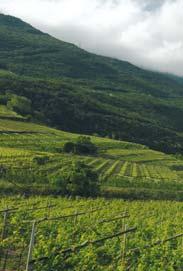
The first director, Edmund Mach, was an expert in the field of agricultural chemistry and oenology, and above all an excellent organiser and innovator. He established a structure where teaching and research could improve agricultural development in the surrounding territory. This fertile bond continues to distinguish the institute.
When Trentino became part of Italy after the First World War, the Istituto Agrario di San Michele all’Adige (IASMA) went to the Province of Trento in 1919, and, in 1926, it was made a part of a consortium of the Italian state.
In 1990, IASMA became a special institution of the Autonomous Province of Trento and its present form is the result of further reorganisation including integration of the extension service into its core activities.
Over the years, the institute has grown significantly, employing nearly 700 staff in 2007. Today, with a school that trains experts in agriculture and oenology, a research centre that carries out studies at an international level, and an extension service that assists local farmers and stakeholders, the institution is well positioned to study solutions, give answers and support improvements in agriculture. Currently governed by a board of directors appointed by the province, the institute is once more poised for change. In 2008, the institution will become the Edmund Mach Foundation. Although funding will remain predominantly public, the private aspects of foundation management will allow the institute to react faster and more efficiently to changing needs.

10 Annual Report IASMA Research Centre 2007
PART 1 | PREFACE The Institute
Organisation
IASMA is a multifaceted organisation. While its main focuses are the school, research centre, and extension service, it also includes a number of important internal and external functions. Internally, the institute relies on its administrative, financial, information technology, legal, and public relations groups. Another function is the IASMA library, with 25,000 volumes and 1,000 periodicals.
Significant external functions include Europe Direct Carrefour Alpi office and the Agency for
Quality Assurance in Agriculture (AQA).
The Carrefour office we host is one of 350 centres set up by the European Commission to provide community information to rural society through individuals, farmers, associations, and public and private institutions. AQA is an independent entity which provides certified quality assessments that help companies meet legal requirements, qualify products, satisfy customers, and match the competition on price.
Another very public part of the
institute is its farming business. IASMA cultivates more than 100 hectares of land, growing apples, grapes and other fruits, and producing wine and distilled spirits. The farming business also functions as an advisory organisation for the research centre and the extension service, and as a teaching and training unit for the school.
The farm is committed to the concept of sustainable agriculture, adopting production principles that work from an agronomic point of view and that lessen environmental impacts.

11 Annual Report IASMA Research Centre 2007 PART 1 | PREFACE
Thehistory of San Michele dates to around the year 1000 when many monasteries were set up or enlarged throughout Europe. In 1143, the Counts of Appiano donated the castle of San Michele all’Adige to the Prince Bishop of Trento and the Augustinian monks turned it into a monastery. Today, the castle’s wine cellars, refectory and cloister convey the ancient roots of the institute.
The grounds of the ancient Augustinian monastery include two historical wine cellars from the 12th and 16th centuries. They are exquisite examples of architectural beauty and historical tradition, and proof of the ancient tradition of wine making in the area. The modern cellar produces a range of wines, as well as spumanti, grappa, and spirits typical to Trentino.
Average annual production is around 200,000 bottles of wine, 100,000 bottles of sparkling wine, and 10,000 bottles of distilled spirits.








IASMA Centres School






IASMA has the only school in Italy that provides training and teaching at different levels in all the sectors of agriculture, the environment and forestry. The range of courses offered varies from those specially designed for farmers to highly specialised ones at university level. The school currently has four separate sections, each with its own distinct area of operation.
The technical secondary education unit manages technical secondary education schools for agricultural, environmental and forestry disciplines, including post-diploma courses where applicable. The vocational secondary education unit manages vocational secondary education schools for agricultural, environmental and forestry disciplines, including first and second level post-qualification courses. The vocational agricultural training unit organises and implements, both directly and in collaboration with other authorities and organisations, training, qualification and specialisation courses for the development and diffusion of expertise in the fields of agriculture, forestry and the environment.
The post-secondary and university education unit provides top-level, specialised training. Its main function is to train oenologists in first-level university degree courses in viticulture and oenology in accordance with the inter-university consortium. It also covers second-level degree and masters courses as well training and higher education, including higher technical training and education.
12 Annual Report IASMA Research Centre 2007 PART 1 | PREFACE
Extension Service
The Extension Service provides technical and economic consultation and advisory services to farms and co-operatives in all sectors of agriculture in Trentino. In particular, the centre gives advice to many economic sectors, such as fruit, viticulture-oenology, strawberry and small fruits, horticulture, floriculture, diary production and
aquaculture, and also provides socio-economic consultation services.

Its objective is to assist the farming sector over the course of all production stages in order to satisfy consumer demand for high-quality, healthy products which have been produced in accordance with “best farming practices” and with absolute respect for the environment.
Consultation is carried out by 54 permanent technicians and 25 contract and support staff working in 10 units strategically located to cover the whole of our region.
The centre provides information to the farming community in Trentino through direct contact with its technicians, as well as through a range of print and electronic media.
Research centre
The rest of this annual report describes the Research centre and focuses on the status of its activities, we therefore only deal with some general aspects of its mission and functions in this section.
The Research centre offers its expertise to the Trentino land-based economy through research, studies and innovations that improve agricultural and forestry products and enhance the quality and nutritional value of food products. Its research programmes and advanced platform technologies are developed in order to deliver innovative solutions and competitive products for stakeholders and enduser communities.
The Research centre also directly manages several farms for carrying out its studies. Intense research programmes, top-flight facilities and important collaborations are the means with which the Research centre carries out its activities and produces results at an international level. Research addresses prominent issues and is carried out by five departments: Agricultural Resources, Agrifood Quality, Genetics and Molecular Biology, Natural Resources and Plant Protection. In addition, the centre hosts two externally-funded research
groups, SafeCrop and CSBT. The former is a network of international research institutions aimed at developing crop protection with low environmental and consumer health impact. The latter (Centre for the Study of Biodiversity, CSBT) is a joint venture with the Max-Planck Institut für Züchstungsforschung, Cologne, for the molecular characterisation of floral biodiversity in Trentino.
The rest of this annual report describes the research centre and focuses on the status of its activities.
13 Annual Report IASMA Research Centre 2007 PART 1 | PREFACE
About the Research Centre
Mission and impact
At a local level, the research centre’s mission is to promote Trentino’s land-based economy through research and innovation.

Research activities improve agricultural and forestry production and enhance the quality and nutritional value of food products.
In addition, research protects the province’s environmental resources by developing and promoting low-impact agricultural practices, studying and preserving biodiversity, and characterising alpine and sub-alpine ecosystems.
Over time, the centre’s activities have evolved beyond its local functions. We also conduct research at an international level in collaboration with institutes and universities around the world. Our results impact the wider scientific community and the world at large.
14 Annual Report IASMA Research Centre 2007 PART 1 | PREFACE
Organisation
Here is a brief description of the centre’s five departments.
▪ Agrifood Quality: Research areas include nutritional quality, sensory quality, guarantee of origin and authenticity, quality improvement in oenology, and process improvement. The department also provides analytical services.
▪ Agricultural Resources: Research areas include fruit and grape breeding, clonal selection and genetic improvement, agricultural resources management, and mountain farming systems.
▪ Genetics and Molecular Biology: Research areas include genome analysis, genetics and genomics of quality traits, plant-pathogen interaction, biodiversity of crop plants, gene transfer and functional analyses, traceability of genetically modified organisms in food and feed.
▪ Natural Resources: Research areas include ecology of the principal Trentino lakes and rivers, ecology, synecology and autoecology, genetics and biodiversity conservation, forest ecology, root rots and urban forestry, forest biodiversity, climatology, microclimatology, phenology, sustainable production and resources economy, air quality, sustainable use of natural resources.
▪ Plant Protection: Research areas include entomology, phytopathology, organic agriculture, and integrated pest management. The department also has a diagnostics and testing facility.
Human Resources
Approximately 92 percent of Research Centre staff are of Italian origin. Of the remainder, about 5% come from the European Union, and the rest are from Asia, Africa, and Central America.
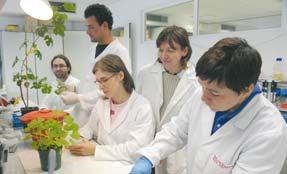
15 Annual Report IASMA Research Centre 2007 PART 1 | PREFACE
ROLE FEMALE MALE TOTAL Researchers, permanent 17 32 49 Researchers, contract 17 31 48 Research fellows, post-doc 15 8 23 Research fellows, undergraduate and graduate 23 19 42 Technical staff 36 47 83 Support staff 10 38 48 Direction and administrative staff of the Research Centre 9 6 15 TOTAL* 127 181 308
* In addition, the centre also offers internships, which are not included in these figures.
Active international collaborations
PROJECT
NATION
Greece, Germany, Czech Republic, Romania, Slovenia How to reduce human effects and threats
ACCRET-E - Agriculture and climate changes:
ALPINET GHEEP – ALPINET network for sheep and
Germany, Austria, Slovenia goat promotion for a sustainable territory development
CSBT – Molecular study of biodiversity in Trentino province. Germany From model species to applications in ecology and agriculture
Apple Genome
United Stated of America
Genomic Research - Assisted breeding for sustainable France production of quality grapes and wine
HIDRAS - Sustainable agriculture, fisheries and forestry, and
Belgium, Germany, United Kingdom, Poland, France, integrated development of rural areas including mountain areas
The Netherlands, Swiss
Romania, Poland for qualitative improvement of soft fruits and study of new transformed products with high added value
INTERBERRY – Integrated interdisciplinary project
REPCO - Replacement of Copper Fungicides in
The Netherlands, Germany, Swiss, France, Denmark Organic Production of Grapevine and Apple in Europe
SAFECROP - Centre for research and development
Israel, France, Sweden, Swiss, Germany of crop protection with low environmental and consumer health impact
SMAP II - Program of future research activities
Germany on apple proliferation disease at IASMA
TRACE - Tracing the origin of food
United Kingdom, France, Belgium, Germany, Austria, Greece, Czech Republic, Slovenia, Ireland, Norway, Poland, Iceland, Spain, China, Switzerland
16 Annual Report IASMA Research Centre 2007 PART 1 | PREFACE
Plant Protection
Research Centre
Natural Resources
Diagnostics & Testing
Entomology & Testing Facility
Organic Agriculture & Integrated Pest Managment
Agrometeorolgy, Climatology & Aerobiology
Biomasses & Renewable Energy
Forest Ecology & Physiology
Limnology & Fish
Genetics & Molecular Biology
Cellular & Molecular Biology
Genomics & Bioinformatics
SafeCrop Centre
Agricultural Resources
Molecular Genetic
Fruit Production
Mountain Farming Systems
Viticulture
Agrifood Quality
Centre for the Study of Biodiversity of Trentino
Analytical Laboratories
Enology & Traceability
Microbiology & Food Technology
Quality & Nutrition
17 Annual Report IASMA Research Centre 2007 PART 1 | PREFACE
Specialty CentreResearch DepartmentResearch Units

Themission of the department is to improve the sensory aspects, nutritional value and health qualities of food products derived from plants grown in Trentino. We carry out basic and applied food research, aimed at improving the entire food production chain. The department develops methodologies to test and guar-
antee the typicality and origin of foodstuffs; it also develops innovative wine processing protocols and technologies, contributes to the genetic improvement of the principal crops grown in Trentino, and provides high quality analytical support and consultation to producers through the institute’s Technical Advisory Centre.
Mattivi
Nutritional quality
Research conducted by the nutritional quality team is aimed at characterising bioactive substances present in raw food (apple, grape, strawberry and other soft fruits) and processed agrifood (wine, juices, etc.). In collaboration with major Italian universities and research institutions we investigate the absorption, metabolism and action mechanisms of natural antioxidants (anthocyanins, cinnamic acids and resveratrols).
A further aim of our studies is to develop new products and applications (nutraceutics, cosmeceutics, pharmaceutics) of bioactive natural products, such as resveratrols. These natural hydroxystilbenes, present in grape and wine, have important anti-cancer and immunomodulating properties, which have been successfully investigated, resulting in Italian and European patents.
Sensory quality
Sensory quality is one of the department’s major research topics. Our aim is to characterise agrifoods using new instrumental and sensory approaches in order to identify markers of perceived quality and to provide analytical assistance and consultation to both producers and plant breeders. We support the development of innovative agrifoods through new

technologies for production and stabilisation based on sensory data in order to promote more conscious consumption, that is, consumption that is more sensitive to overall quality.
The quality of typical agrifoods is developed through sensory characterisation and monitoring of consumer knowledge, opinion and expectation. This task is also supported by investigation of the factors which govern sensory experience and consumer appreciation, and of their correlation with biochemical and physiological parameters.
Authenticity of origin
The department has internationally recognised experience in guaranteeing the origin and authenticity of agrifoods. We pursue this activity in the context of national and European projects, and in close cooperation with the Italian Ministry of Agriculture. We investigate new protocols and markers for the geographical, botanical and technological origin of agrifood (e.g. stable isotopes and microelements).
Application of this research is supported by the creation of databases and robust, validated methods for the traceability of agrifoods, as well as by the development of new instrumental methods (ICP-MS, SIRMS, etc.)
19 Annual Report IASMA Research Centre 2007 AGRIFOOD QUALITY DEPARTMENT
PART 2 | DEPARTMENTS | AGRIFOOD QUALITY DEPARTMENT
Fulvio
Oenology

Quality improvement in oenology covers a variety of activities, ranging from optimisation of the use of techniques, technologies and fining agents to development of rapid methods for quality control. Research is mainly focussed on nitrogen-containing compounds,

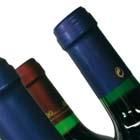

Analytical services
One of the department’s major activities is to provide analytical services in a unique environment based on a robust analytical platform and on state of the art expertise thanks to close connections with research activities. Our modern, well equipped and efficient analytical laboratory provides high quality support and consultation to producers. The laboratory operates under the UNI CEI EN ISO/IEC 17025 with 38 SINAL-accredited methods (http://www.sinal.it/eng/), and is authorised by the Italian Ministry of Agriculture to provide analytical certificates (22 different methods) for vitienological products, which have official validity both at the national level and for export. We provide analytical services to about 300 private clients. In addition to working with the majority of regional companies and consortia and with many leading Italian wineries, we receive frequent requests from important international clients, especially from Germany and South Africa.
Facts of the year
2007 was a very intense year for both research and service in the department. Thirty externally funded projects were carried out during the year. The growth of research activities led to a significant improvement in scientific production with the publication of 18 scientific papers in major ISI journals. The department’s researchers were also involved in teaching ten university courses. We hosted 21 laboratory stages and provided support for six dissertation theses. We also performed well in the annual audit for renewal of our SINAL accreditation. The laboratory handled more than 22,000 samples for chemical or microbiological analysis, which allowed us to provide - in addition to analytical support within the research centre - analytical services to more than 300 clients, as well to the Technical Advisory Centre, the latter with over 4,000 samples.
volatile compounds (terpenols, sulphur containing compounds, volatile phenols, etc.) and contaminants in grape and wines, as well as analysis of the phenolic potential of grape for the optimisation of red wine production. In collaboration with the University of Trento, the microbiology team is studying new matrices for the production of immobilised lactic bacteria. Another area of applied research in oenology is the development of methods for reducing exogenous antioxidants (sulphur dioxide) and for improving natural antioxidants in white wines. In the field of distilled beverages, the department is engaged in the improvement of distillation
processes for the production of grappa and in providing scientific support to this traditional spirit in order that the producers from Trentino may maintain the highest quality standards.
Industrial processes
The department’s research team is also involved in improving industrial processes and, in particular, developing new techniques for the stabilisation of juices, exploiting microbial biodiversity and joint use of integration cultures for the production of typical cheeses, and the pilot scale optimisation of processes for fermented fruit drink production.

20 Annual Report IASMA Research Centre 2007 PART 2 | DEPARTMENTS | AGRIFOOD QUALITY DEPARTMENT
Federica Camin Luana Bontempo Matteo Perini
Organic farming has received considerable attention in recent years, but, despite the high value of the organic market, traceability of organic products is based solely on adherence to specific guidelines (for the EU, Regulation 834/2007). Certification bodies are expected to regularly control only product chains, and since prices for organic products are attractive (up to 400% of conventional counterparts), the likelihood of misconduct is significant. Identification of parameters to distinguish organic from conventional products is thus extremely desirable, although it is a daunting task as both regimes encompass a myriad of heterogeneous practices.
Organic potatoes
As part of a study carried out in collaboration with CRA-CIN (Centro di Ricerca per le Colture Industriali) of Bologna, organic and conventional potatoes, one of the world’s most widely cultivated crops, were examined (Camin et al., 2007, J. Sci. Food Agric., 87, 1330–1336).
Ascorbic acid, protein and dry matter were selected as candidate parameters for analysis, as the literature indicates that ascorbic acid, dry matter, polyphenols and other antioxidants tend to be higher in organic products, whereas in conventional counterparts total protein and nitrates tend to be higher. In fact, the low bio-availability of N in organic regimes, due to the higher prices of organic fertilisers and slow N mineralisation, gives rise to an enhanced synthesis of N-poor molecules (e.g. ascorbic acid, polyphenols, cellulose, starch) in the plant, according to the C/N balance theory. The higher levels of antioxidants, such
as ascorbic acid, in organic samples can also be due to increased pathogen pressure leading to a build-up of endogenous plant defence compounds. Our data on potatoes indicate that dry matter is influenced more by genotype and site than by the type of cultivation regime and none of the field trials showed significantly higher levels of raw protein in conventional samples. With regard to ascorbic acid, its levels are extremely variable and the cultivation site appears to exert a greater influence. In only one field trial were ascorbic acid levels slightly higher in organic tubers.
Due to the poor discriminative capacity of the preceding markers, we considered other less commonly adopted parameters. Since organic regimes rely on biological sources for N (crop rotation, green and animal manure, compost, fish-meal, rape-meal, etc.) and synthetic fertilisers cannot be used, analysis of the stable isotope ratio of nitrogen
(15N/14N, expressed as δ15N) was carried out. The δ15N values of synthetic fertilisers, industrially manufactured using different processes in which atmospheric N2 (δ15N ‰ = 0) is directly fixed, fall within a narrow range close to 0‰. Organic fertilisers tend to be richer in 15N (a higher δ15N mean value of 8.5‰ and a broader range of δ15N values between around +1‰ and +37‰) because they are produced through multistep metabolic paths and composting processes. Irrespective of the year, site and cultivar, organic tubers showed higher δ15N values when compared with conventional counterparts, as shown in Fig. 1. Although this trend was especially evident when comparing organic and conventional tubers within the same site, the sum of all samples from all four sites (organic vs conventional) still showed organic samples to have significantly higher δ15N‰ values (7.17 ± 48% vs. 3.36 ± 38%; means ± CV%; n = 39; P < 0.001, Fig 1a). Furthermore,

21 Annual Report IASMA Research Centre 2007
Chemical analytical strategies to protect and promote organic commodities
PART 2 | DEPARTMENTS | AGRIFOOD QUALITY DEPARTMENT
only 15% of conventional tubers were misclassified when a threshold for assignment to the organic group was set at the lowest δ15N observed for organic samples (+4.3‰).
Biomarker project
Since 2006 we have been involved in a three-year research project entitled BIOMARKERS “New markers for organic products”, funded by the Italian Ministry of Agricul-
tural, Food and Forestry Policy. The objective of the project is to define a traceability system for organic fruit (oranges, peaches and strawberries) in order to detect fraud and avoid unfair practices by farmers. In addition, physico-chemical, nutritional and sensory characterisation of organic fruits is being carried out in order to promote these products on the market. The project’s prelimi-
nary results show that production methods do not lead to relevant differences in quality standard parameters, with the exception of vitamin C content which was frequently higher in organic fruit. However, the stable isotope ratio of nitrogen (15N/14N) measured in the pulp of fruits was shown to be a promising marker for differentiating organically from conventionally grown fruits: organic peaches and oranges had signifi-
Organic milk
cantly higher δ15N values compared with conventionally grown fruit, and those organic oranges treated with animal manure showed an even higher 15N content.
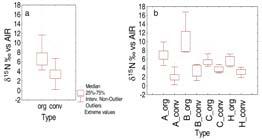
No difference was observed between the δ15N values of organic and conventional strawberry pulp, due to the fact that organic fertilisers were also employed in the conventional in-field production of these fruit.
There are no clear rules governing the production of milk, although it is likely that organic milk is produced by grazing cows rather than by animals fed with commercial feeds which are normally enriched with maize or based on maize silage. The δ13C values of milk are influenced by the maize content in the diet, as forage is made up of plants with the C3 photosynthetic cycle (δ13C between -30 and -22‰), whereas maize has the C4 photosynthetic cycle (δ13C between -14 and -9‰). In collaboration with ERSAF (Ente Regionale per i Servizi all’Agricoltura e alle Foreste) we carried out a study (Camin et al., 2008, Rapid Commun. Mass Spectrom., DOI: 10.1002/rcm.3506) to evaluate the mathematical relationship between the % of maize in the animal diet and the δ13C of milk. We found that each 10% increase in the maize content of the diet results in a 0.7‰ to 1.0‰ shift in the δ13C of casein (Figure 2), similar to findings for the δ13C of lipid-free muscle. A threshold value of –23.5‰ for the δ13C of casein was found to be the limit above which it is not possible to exclude the presence of maize in the animal diet.
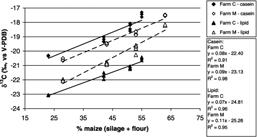
a) Means of all
from all sites (organic vs conventional); n= 39.
b) A: season 2002, cv Vivaldi, site Imola (Bo); n=9. B: season 2003, cv Vivaldi, site Alfonsine (Ra); n=10. C: season 2004, cv Vivaldi, site Conselice (Ra); n=10. H: season 2004, cv Hermes, site Guidizzolo (Mn); n=10
22 Annual Report IASMA Research Centre 2007 PART 2 | DEPARTMENTS | AGRIFOOD QUALITY DEPARTMENT
Figure 1 a, b - Box-whisker diagrams of δ15N
collected tubers
Figure 2 - Relationship between the δ13C values of milk casein (♦) and lipid ( ) and percentage of maize in the diet, for 2 farms (C and M)
Figure 1
Figure 2
Optical microscope observation of the prepared specimens shows entrapped Saccharomyces cerevisiae and Oenococcus oeni cells (figure 1). Yeast cell budding and the preferential chain-line structure of bacteria suggests that the maintenance of cell viability after inclusion in Ca-alginate beads is not affected.
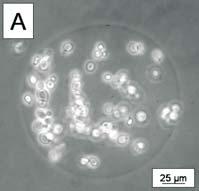
To guarantee better cell retention and sufficient mechanical stiffness of the immobilisation matrix, the microbeads were first
Theimmobilisation of biological agents, such as macro-molecules and micro-organisms, is a response to the increasing demands of bioefficiency over extended operation times, and of manageable operation and function maintenance, in comparison to free biological load.
These are particularly important in wine-making because of the presence of several factors limiting the performance of micro-organisms which can lead to alcoholic or malolactic stuck fermentations.
An innovative approach for the immobilisation of cells, encapsulated in Ca-alginate beads coated with a silica layer, was set up in a research project conducted by the IASMA Research Centre and the University of Trento (Department of Material Engineering and Industrial Technology). The alginate ionotropic hydrogel is commonly used for easy and safe encapsulation of cells in beads with predictable geometry. It also provides a protective environment that allows further coating with silica without damaging the cells remaining in a heterogonous phase. The method described was tested for the immobilisation of different cells. In this study, it was applied to Saccharomyces cerevisiae and Oenococcus oeni cells, to be used in ordinary wine fermentation. The micro-organisms were dispersed in Na-alginate solution and dipped in a Ca2+ solution using a special apparatus, to obtain Ca-alginate microbeads. Attention was paid to the viscosity of the suspension and the operative conditions in order to reliably control the microsphere diameter to keep it within the 400-600 μm range.
Improved immobilisation technology for wine microorganisms

 Agostino Cavazza Raffaele Guzzon
Agostino Cavazza Raffaele Guzzon
coated in a silica sol, prepared from tetraethoxysilane (TEOS) solution with 100 g/l of SiO2. The 29Si NMR characterisation of the microsphere samples indicates that silica is engaged in a network of Si(OSi)4 and HO-Si(OSi)3. There was extensive condensation among Si-OH, as evidenced by the absence of un-polymerised silica units. The change in morphology of the bead surface after silica sol coating is ascertained by Environmental Scanning Elec- Figure 1
23 Annual Report IASMA Research Centre 2007
tron Microscopy (ESEM) (fig. 2); the silica layer clearly reduces the surface roughness and is homogenously distributed on the alginate surface. The second coating was applied by means of direct reaction between methylethoxysilane (MTES) in gas phase and Ca-alginate beads already coated by TEOS. We explored the possibility of stabilising the sol-particle layer, by exploiting the high reactivity of MTES vs. surface exposed Si-OH thereby also effectuating production of cross-link between particles and siliceous membranes with narrow porosity and plastic-like behaviour. ESEM observations showed that double coated microspheres have a very smooth surface and
29Si NMR spectra provided information concerning the chemical nature of the silica deposit. CH3Si(OSi)2OH and CH3Si(OSi)3 are shown, so MTES reaction with silica-sol coated Ca-alginate beads lead to the formation of a well connected siliceous network, as supported by the absence of nonpolymerised monomers and of bonded silica units.
The mortality of cells during the treatments is negligible: the yeast cell density in post-treatment samples is similar to that in Na-alginate suspension before silica deposition. Cells leaking after coating were below 1%. In fact, the physical and chemical nature of the gel prepared from double silica coating shows very low and

narrow porosity.
The efficiency of immobilised cells, in comparison with free ones, was checked in a series of fermentation tests. Glucose degradation by Saccharomyces cerevisiae was used to study the alcoholic fermentation activity of free yeast.
The substrate concentrations were chosen from within the range of those found in wines, and the Lineweaver-Burk plots for experiments carried out with free or immobilised cells allowed V max and K m values to be calculated. The same approach was used for malolactic bacteria, and the L-malic fermentation kinetics of immobilised and free cells were compared.
The results indicate that the coating treatment has a limited effect on cell activity: Vmax was similar to that of the free cells, but the Km was lower. The presence of CH3-Si groups generated by MTES on the bead surfaces changes their wettability, their acid and basic character and the hydrophilic behaviour of the siliceous layer and may also affect substrate and product transport. These results were confirmed by a series of malolactic fermentations performed in real wine-cellar conditions. An initial series of experiments were performed to test the behaviour of immobilised cells in the presence of wine limiting factors: pH, SO2 and L-malic acid concentration. In a second series, the effect of different wine-making conditions on immobilised bacteria activity was verified: a series of malolactic fermentations were
performed using free or tea-bag included microspheres, low temperature, fermentation in wine or simultaneous alcoholic and malolactic fermentation in must. The evidence confirms the immobilised bacteria to be comparable to the free cells in terms of fermentation rate, resistance to limiting factors and adaptability to co-fermentation conditions. The immobilised biomass also guarantees a lower cell release in wine, the cell activity showing no decrease during 40 days of continuous fermentation. The use of silica-alginate immobilised culture could be an interesting alternative to free cells. Highly manageable malolactic fermentation can be achieved, in terms of kinetic, precise biomass management and low cell dispersion, offering the possibility of increasing wine quality and safety.
This work was carried out in collaboration with Prof. Giovanni Carturan (University of Trento).
24 Annual Report IASMA Research Centre 2007
PART 2 | DEPARTMENTS | AGRIFOOD QUALITY DEPARTMENT
Figure 2
Elements in wine have been mainly studied in relation to toxicity and wine stability. For several elements, contamination during the entire grape and wine production cycle leads to significant increases in natural concentrations in wine, which depend largely on the soil. In recent years, analysis of micro-elements and trace elements has extended beyond traditional practices and become a useful means of identifying the geographic origin of must and wines.
This article summarises studies carried out at IASMA in the framework of ICP-OES and ICP-MS analysis of mineral elements applied to oenology, aimed at understanding the extent to which technological choices in winemaking may affect the mineral composition of wines. Details are to be found in the literature [J. Agric. Food Chem., 2003, 51: 5956-5961; Ital. J. Food Sci., 2001, 13: 237-245; Riv. Vitic. Enol., 2003, 56(4): 29-44 and 45-48; Vitis, 2004, 43: 41-45; J. Commodity Sci., 2004, 43: 21-29; Mitt. Klosterneuburg, 2004, 54: 25-32; Hyphenated Techniques in Grape and Wine Chemistry, Ch. 8, Wiley & Sons].
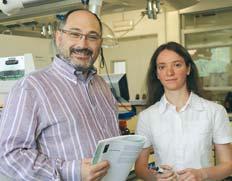
Factors affecting the mineral composition of grapes and wine
 Giorgio Nicolini
Giorgio Nicolini
 Daniela Bertoldi Roberto Larcher
Daniela Bertoldi Roberto Larcher
Mineral Composition of Grapes
Mineral composition was analysed in dozens of grape samples from 10 varieties picked at technological maturity. The presence of some elements appeared to be linked to more or less marked exogenous contributions due to phytosanitary treatments or dust and earth deposits. This was highlighted by comparing natural grape data with data from grapes washed in a diluted acid solution. This treatment lowered the maximum content of various elements, in particular Cu and Al and to a lesser extent K, Mg, Pb and Sn. Cu in grapes has shown a constant tendency to diminish in the last decade and sulphur residues, measured by HPLC using a new analytical method, were over 2 mg/Kg in 10% of the approximately 160 samples analysed, always remaining, however, well below the legal limit.
Mineral Composition of Wines
An extensive selection of commercial wines was evaluated. The elements measured were essentially in agreement with the typical contents given by Eschnauer [Naturwissenschaften, 1986, 73: 281-290], and were often close to (Ba, Ca, Pb, Sn, Sr, Zn) or below (Ag, Cr, Li, Mn, Ni, V) the lower
limits. For Ag, Cd, Co and Sn only a few samples exceeded quantification limits, with a maximum of 7.6 μg/L for Ag, 5.9 μg/L for Cd, 8.1 μg/L for Co, and 75 μg/L for Sn. Mineral content in red wine was significantly higher than in still white wine, around 20-30% for Ba, Mg and Ni, c. 40-70 % for B, Fe, K, Li, Pb and Sr, and c. 100 % for Rb. The only element usually present in significantly lower quantities in red wine was Ca (c. -13 %), due to easier precipitation of its salts at the higher pH typical of red wine.
25 Annual Report IASMA Research Centre 2007
The elemental content in Spumante wine was usually lower than in still white wine, around 10-30% for Ba, B, Ca, Cr, K and Sr, and c. 60 % for Cu. Studies carried out at the Institute from the 1960s onwards have shown a gradual reduction in the content of Ca, Mg, Fe, Pb and Zn in wines as a result of technological improvements. In contrast to this, wines produced in the last few years have shown significant increases of K.
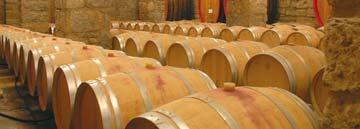
The ordinary choice of the yeast strain to be inoculated to carry out fermentation, without multiplication phases, can significantly affect the final content of some metals in wine. As observed when fermenting 11 white musts with 4 commercial strains (20 g/ hL), it is possible to trace back to the strains statistically significant differences in Co, Cu, Mg, Na, Pb, Sr and Zn, together with technologically relevant differences in Cu, Zn and Pb. These may be linked to the different capacities of the yeasts to produce H2S which can precipitate metals, but also to bioabsorption mechanisms on the cell wall or the different metabolic needs of the yeasts.
Effects of Oenological Techniques
The effects of technological interventions, not specifically designed to affect mineral content but which may nevertheless modify it, were investigated.
The treatments with different bentonites significantly modified the content of 40 out of the 44 elements studied. Modifications of B, Cr, Sn and Pb were not statistically significant, although there were differences between the various bentonites. K, Rb and Zn diminished significantly, but in technologically negligible quantities, whereas the decrease in Cu (-43%) was considerable. Statistically significant increases were noted for all the other elements, particularly marked for Ce, Gd, La, Nd, Pr and Y (c. 10 times the control) and Be, Tl and U (4-6 times). No differences attributable to pH in the interval from 3.00 to 4.00 for technologically correct quantities of bentonite (max. 1 g/L) were observed.
The use of yeast hulls (180 mg/L and 360 mg/L) from 2 different suppliers led to statistically significant increases in levels of Ce, Cu, Fe, La, Sb, U, V and Y, the effect being in line with the dose used. The largest percentage reduction was for U (c. 24 % and 36 %). The reduction in Fe content was also shown to be substantial and technologically significant (c. 17 % and 25 %). The average reduction in Ce content was at most around 15%, whereas the reduction in Sb, V and Y did not exceed 10%. The reduction in Cu differed significantly for the 2 commercial products (2 and 10 %).
The use of tannin and gum arabic may also influence the mineral profile of wines. Analysis of the possible contribution made by 21 tannins distributed in Italy, assuming the addition of 200 mg/L, showed significant increases in Sn (c. 20 times greater), U (c. 10 times), Pd (c. 6 times), Pr and La (double). Regarding technologically or sensorially significant macroelements, increases of 7 mg/L in Na may result from the addition of some tannins. For all the other elements, variations were negligible, even in terms of health (e.g. for Pb and Cd). Gum arabic may also give rise to significant increases in La, Pr and Th (c. 4-6 times) in wines, and contribute to increases of up to 3 mg/L in Na.
In light of the technological effects on the mineral profiles of wines noted above, it is interesting and somewhat surprising that multi-element analysis – alone or jointly with other analytical approaches – may be a useful tool for the geographical traceability of enological products. Examples are the capacity to distinguish Spumante wines produced in Trentino, Oltrepò and Franciacorta, or Mueller-Thurgau still wines from different areas within a single region as well as wines from national macro-areas.
26 Annual Report IASMA Research Centre 2007
PART 2 | DEPARTMENTS | AGRIFOOD QUALITY DEPARTMENT
There is consistent epidemiological evidence linking consumption of a diet rich in fruit and vegetables with a reduced incidence of cancer, coronary disease and neurological disorders. The protective effects of dietary fruit and vegetables are attributed to their relatively high content of antioxidants, of which polyphenols are quantitatively the most significant. Berries are amongst the richest sources of phenolic compounds in the human diet. Some of the phenolic compounds found in berries are present in
many other fruits and vegetables while others are specific to berries. Although anthocyanins are abundant in red raspberries and blackberries, ellagitannins are the main class of phenolic compounds found in these berries. The occurrence of ellagitannins in common foodstuffs is limited to a few fruits e.g. strawberries (Fragaria x ananassa D.), blackberries (Rubus sp.), raspberries (Rubus idaeus L.) and muscadine grapes (Vitis rotundifolia). The Rubus ellagitannins are largely responsible for the astringent and anti-
oxidant properties of raspberries and blackberries. Raspberry and blackberry ellagitannins constitute a complex mixture of monomeric and oligomeric tannins which contain, beside the wellknown ellagic acid and gallic acid moieties, the sanguisorboyl linking ester group. Ellagic acid has received much attention for its nutritional and pharmacological potential as an antioxidant and antiviral agent. Moreover, it acts protectively against different types of cancer, such as colon, lung and esophagus cancers.
In raspberry fruits free ellagic acid constitutes only a minor part of the total ellagic acid pool, whilst the ellagic acid released after acid hydrolysis from ellagitannins can constitute up to 88% of the total phenolic content. Ellagic acid, a dimeric derivative of gallic acid, exists in higher plants - including fruits - in free form, glycosylated with various sugars or as simple or complex ellagitannins, which are esters of hexahydroxydiphenic acid (HHDP) and a polyol, usually glucose or quinic acid. When exposed to acids or bases, ester bonds become hydrolysed and the hexahydroxydiphenic acid spontaneously cyclises into the water-insoluble ellagic acid. This reaction forms the basis of an assay commonly used for their detection and quantification.
A new, rapid procedure for the acid hydrolysis of Rubus ellagitannins in methanol, which results in maximal yield and enables quantification of all the major reaction products, was developed in our laboratory. The method also provides the means for estimating the mean degree of polymerisa-

tion (mDP) of Rubus ellagitannins. A new method was employed in order to obtain a first insight into the variability of the ellagitannins in 37 important Rubus genotypes - 21 raspberry and 15 blackberry

27 Annual Report IASMA Research Centre 2007 PART 2 | DEPARTMENTS | AGRIFOOD QUALITY DEPARTMENT
Characterisation of ellagitannins and their importance for the promotion of the healthy properties of soft fruits
Urska Vrhovsek
Figure 1 - Ellagitannin content in different raspberry varieties
cultivars - grown in Trentino. Acid hydrolysis of the ellagitannins in methanol was carried out in order to quantify all the major reaction products (ellagic acid, methyl-sanguisorboate, methyl-gallate and an unknown ellagic acid derivative) and estimate their mean degree of polymerisation (mDP).
The concentrations of ellagic acid released during acid hydrolysis ranged from 612 to 1174 mg/kg fresh
weight in raspberries and from 576 to 2399 mg/kg fresh weight in blackberries.
Values for the second quantitatively most important compound (methyl-sanguisorboate) were between 262 and 487 mg/kg fresh weight for raspberries and between 261 and 1180 mg/kg fresh weight for blackberries. The values for other minor compounds released during hydrolysis (methyl gallate and an unknown ellagic acid derivative), were up to 101 mg/kg in raspberries and up to 182.5 mg/kg fresh weight in blackberries.
The ratio between maximal and minimal ellagitannin concentrations recorded among red raspberry cultivars did not exceed 1.7, indicating relatively limited variability among the cultivars investigated. This variability was much higher in blackberries, reaching a ratio of 4.4 between the cultivars (Adrienne and Apache).
A relatively high ellagitannin content was observed in the blackberry cultivars Adrienne, Helen and Silvan. Considering that Adrienne is a seedling of Silvan, and that Helen is derived from the cross (Silvan x unnamed selection), possible inheritance of this trait into new progenies in breeding programmes is postulated.
In view of increasing consumer attention to the nutritional value of their diets, the antioxidant content of berries, and in particular their phenolic profile, ought to be considered an important trait in breeding programmes.
Ellagitannin content and that of other major antioxidants should be considered together with traditional selection criteria,
focussed on yield, pest resistance and shelf life, in screening programmes aimed at improving the healthy properties of berries. The wide variation in the composition of ellagitannins and organic acids could possibly affect the taste of the blackberry genotypes, in light of the reported interaction between acidity and the perceived astringency and bitterness of the tannins.

28 Annual Report IASMA Research Centre 2007
PART 2 | DEPARTMENTS | AGRIFOOD QUALITY DEPARTMENT
Figure 2 - Ellagitannin content different blackberry varieties
Characterising natural tomato passata by means of the isotopic ratio of oxygen
Luana
Bontempo, Federica Camin, Matteo Perini
By Italian law, tomato passata can only be made from fresh tomatoes, and not by adding water to tomato paste. Analysis of the isotopic ratio of oxygen (18O/16O, expressed as δ18O) has been in use for years in wine and juice control and was a natural candidate for combating fraudulent addition of water in tomato passata. It is an effective measure as the δ18O of vegetal water presents higher values than those of tap water due to isotopic fractionation during evaporation processes in plants and fruits.
In collaboration with the Italian Ministry of Agricultural, Food and Forestry Policy, SSICA (Stazione Sperimentale per l’Industria delle Conserve Alimentari) and AIIPA (Associazione Italiana Industrie Prodotti Alimentari), we collected samples from the major Italian production regions over several years.
Our results indicate that natural tomato passata has significantly higher δ18O values than products made of diluted tomato pastes.

Molecular techniques applied to sterility testing of bottled wine
It is important in oenology to test the microbial stability of bottled wine. Moreover, it is important to know how many and which micro-organisms are in the end product before it is released onto the market. The microbiological methods used nowadays in this field do not provide this information in real time. The project begun at the end of 2007 will apply the PCR technique to provide a new system for testing the microbial stability of bottled wine in real time. Initially, a rapid protocol to analyse bottled wine, aimed at quantifying several species of yeast and bacteria, will be developed. The search for a suitable method of quantifying viable cells will follow. In the final part of the project, the application of validated sterility tests to bottled wine will be carried out.

29 Annual Report IASMA Research Centre 2007 PART 2 | DEPARTMENTS | AGRIFOOD QUALITY DEPARTMENT In brief
Lorenza Conterno, Elisa Poznanski, Claudio Moser, Riccardo Velasco, Agostino Cavazza
Effects of supercritical CO2 and N2O pasteurisation on sensory quality
 Flavia Gasperi
Flavia Gasperi
Treatment with supercritical gas is an innovative technology for non-thermal pasteurisation, but its effect on perceptible quality has not until now been sufficiently explored. We investigated this issue by subjecting fresh apple juice treated with supercritical CO2 and N2O to discriminative sensory analysis performed by a trained panel and to instrumental determination of quality parameters related to consumer perception (taste and odour). Sensory analysis and basic chemical char-
acterisation could were not able to clearly identify any modification to the treated juice, while headspace analysis performed by gas chromatographic (SPME -HRGC-MS) and mass spectrometric (PTR-MS) techniques indicated a general depletion of the volatile compounds. These findings must be taken into account in the future development of this technology.
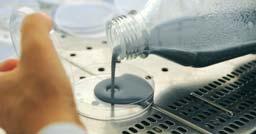
This work was supported by project INTERBERRY (Autonomous Province of Trento).
Quantification and sensorial significance of a little-known volatile phenol
Larcher Roberto, Giorgio Nicolini, Daniela Bertoldi
Following recent research on volatile phenols, in 2007 we established a new HPLC method using a coulometric electrode array detector to analyse 4-ethylcatechol (4-EC) in wine. The procedure does not require any sample preparation nor analyte derivatisation and performs chromatographic sepa-
ration rapidly. The method is linear up to 1520 μg/L and precise (R.S.D. < 3%), with a quantification limit (LOQ = 2.2 μg/L) adequate for oenological needs and far below the sensory threshold. As expected, given the genesis of the compound, the contents in red wines were significantly higher than in white and raisin wines. Red wines had a median value of 37 μg/L, 75◦ percentile of 89 μg/L and a maximum value of 1610 μg/L. The sensory thresholds in wines ranged from 100 to 600 μg/L, according to their aroma complexity. A cheaper, but less sensitive (LOQ = 185 μg/L) fluorimetric HPLC method of 4-EC quantification was also established. 4-EC does not seem to be as damaging to wine quality as the better known 4-ethylphenol and 4-ethylguaiacol, and contributes to overall wine aroma complexity at low concentration.
30 Annual Report IASMA Research Centre 2007
PART 2 | DEPARTMENTS | AGRIFOOD QUALITY DEPARTMENT
TheAgrifood Quality Department has extensive experience in research and development projects using state-of-the-art technologies to deliver innovative solutions in co-operation with industry. The department’s instrumentation is primarily aimed at two research pillars of the “Food for Life” platform: “Food and Health” and “Food Quality and Manufacturing”. Alongside the equipment, a panel of experts trained to conduct sensory analyses provides the department with essential expertise.
Our primary equipment and facilities are:
▪ 2,000 square metres of fully equipped analytical and microbiological laboratories with SINAL certification.

▪ Spectrometers: GC-MS (4),
HPLC-MS, PTR-MS, ICP-MS, NMR, IR-MS (3).
▪ Analytical techniques include: GC (15), HPLC (4), CI, FT-IR, ICP-OES, preparative HPLC, NIR spectrometer, UV-VIS spectrophotometers (2), and differential pH-meter.
▪ Microbiological tools include: autoclaves, fermenters, thermocyclers, refrigerated incubators, microscopes and stereomicroscopes, electrophoresis cells (4), laminar hoods, and microcentrifuges.
▪ Experimental winery with the capacity for 400 test vintages per year.
▪ A sensory laboratory with a product preparation area, ten testing booths with serving windows, controlled light and software for data acquisition.
Equipment
31 Annual Report IASMA Research Centre 2007 PART 2 | DEPARTMENTS | AGRIFOOD QUALITY DEPARTMENT
Facilities and
AGRICULTURAL RESOURCES DEPARTMENT
Marco Stefanini*
PART 2 | DEPARTMENTS | AGRICULTURAL RESOURCES DEPARTMENT
TheAgricultural Resources Department conducts basic research and also provides laboratory services. Its principle areas of interest are:
▪ Characterisation of the key physiological, biochemical and nutritional factors influencing productivity and quality in Trentino’s major crops: grapevine, apple and soft fruit.
▪ Genetic improvement (breeding and clonal selection) of cultivated varieties and rootstocks, as well as continuous development of agronomic techniques and conservation methods in order to sustain the competitiveness of the local agronomic sector.
▪ Development of “precision farming” approaches using GIS and remote sensing technologies to enhance management of agricultural resources.
▪ Sustainable development and diversification of mountain agricultural systems through improved animal husbandry and grassland use practices.
▪ Services and innovations that guarantee quality products through close interaction with IASMA’s technical support centre and agronomy school.
The department has three research units: viticulture, fruit production and mountain farming systems. Our main areas of research are presented in the following sections.
Breeding and genetic improvement of apple and grape
The focus is on developing new cultivars capable of meeting market needs in terms of consumer quality and economic viability. Although distinct in their final application, the viticulture and fruit production units both take a multi-disciplinary approach to agronomical and phenotypical characterisation, and to genomic research. Research issues include the agronomical and biological aspects of breeding and the evaluation of new cultivars. While we continue to use conventional breeding techniques to create new cultivars, we make increasing use of genomic resources. In particular, we have recently begun to develop expertise in marker assisted selection, a method that greatly improves efficiency.
Our activities cover the following fields:
▪ Maintenance and evaluation of germoplasma (grape and apple).
▪ Conventional breeding techniques, including inter-specific crossing, development of breeding lines and progeny trials.
▪ Vegetative propagation and nursery techniques.
▪ Breeding strategies for disease resistance.
▪ Selection for resistance to phytopathology and for fruit quality.

▪ Agronomical and physiological evaluation of new genotypes.
We have an important clonal selection and genetic improvement programme for the traditional grape

32 Annual Report IASMA Research Centre 2007
* Massimo Bertamini (until December 2007)
Marco Stefanini (from December 2007)
Optimising production in grape and fruits

Our fruit and crop growth research programme capitalises on extensive experience in crops and in environmental physiology for viticulture and pomology. Regarding apple, we focus on enhancing the quality of fresh fruit to support regional fruit production and marketing. As for grape, our objective is to optimise fruit quality in order to raise the standards of regional vine production.
cultivars of the Trentino region. Clonal selection is carried out in 20 hectares of vineyards, the selection criteria being phenologic characteristics, morphological differences of leaves and grapes, productivity, vigour and cluster characteristics. Particular emphasis is placed on grape composition and its technological potential for wine. Phytosanitary development (virus detection and eradication) is performed in laboratories and greenhouses, while quality studies are carried out in field clone trials. Clonal selection is carried out according to procedures specified by the national committee for the homologation of grapevine material, and is officially registered and certified. Our clones are marketed under the trademark ®ISMA.
Compared with annual crops, perennial fruit crops offer wide flexibility in the physical arrangement of their fruiting canopies. Not only can the size and shape of the canopy be dramatically altered by tree spacing, pruning and training, but the canopy can also be physically constrained by a support structure of posts and wires.
Various tree shapes and forms can be found in orchards. In our research, we are interested in the interactions between canopy architecture and flowering, fruit development and quality. Our aim is to manage plant canopies in order to optimise the way trees intercept light and convert this energy into high yields of top quality fruit.
Apple quality benefits from regular production from year to year, which can only be achieved when trees do not overproduce. Several chemical thinning agents are currently available and we use our fields to compare their efficacy with the standard strategies for the main apple cultivars. After storage or transport comes the horticultural or harvestable maturity phase. In this developmental stage, the fruit is ready for market. To get fruit to the consumer in the best possible condition, we use several harvest indices, including SSC (Brix), acidity, dry matter, skin and flesh colour.

We have produced modelling approaches for use in estimating the maturity of grapes from various vineyards and from different cultivars. These computer models help to indicate the optimum harvest time which will consistently produce top quality grapes. We are also developing precision farming tools based on GIS and remote sensing for better management of agricultural resources.
Sustainable land use
Trentino’s productive lands and natural areas are vitally dependent on the quality of soils, mountains, water and biodiversity.
The goal of our research is to implement and assess collective action aimed at promoting sustainable agriculture and rural development in the Alps.
Trentino’s agricultural systems are designed to yield premium fruit and animal products through sustainable management that exploits the natural capital of environmental resources.
Low-impact management of alpine pastures and mountain landscape protection are particularly important aspects of maintaining the natural environment of the Alps.
The aim of our activities is:
▪ To design and implement local action plans for sustainable agriculture and which contribute to rural development in the alpine region.
▪ To assess the efficacy of action plans already implemented and to disseminate methods and tools that promote sustainable agriculture.
▪ To provide political recommendations concerning rural development.
33 Annual Report IASMA Research Centre 2007 PART 2 | DEPARTMENTS | AGRICULTURAL RESOURCES DEPARTMENT
Agronomic evaluation of three AP resistant rootstocks in Trentino
Alberto
Nicola
Dorigoni
Dallabetta
Ivan Piffer
Franco Micheli
Paolo Lezzer
Introduction
Apomitic rootstocks (ARs) were obtained from breeding programmes in Sweden in the 1950s (1st generation) and in Germany in the 1970s (1st and 2nd generations). In one crossing, made in Germany, M9 had already been used as a parental to produce a 2nd generation progeny (e.g. H0909).
In one-year field trials at BBA Dossenheim, these rootstocks proved to be field resistant. They can be experimentally infected by graftinoculation but the phytoplasma titre in these plants is decreasing
over the years. The resistance strategy is based on resistance in the rootstock and on the yearly elimination of phytoplasmas in the aerial part of the plant during new phloem formation in early spring. Since none of these genotypes had previously been tested in Trentino, and the choice of rootstock is well known to significantly affect tree performance as a whole, from vigour to yield efficiency and even crop quality, in 2005 three ARs with varying degrees of AP resistance were tested and compared with two well-known
commercial standard references, M9 and M26. The general purpose of the trial was to assess the agronomic value of these ARs and to verify their AP resistance in the field in two important growing areas of Trentino. More specific goals included:
▪ assessing the presumable economic loss due to the change of rootstock from a highly productive but susceptible one, such as M9;
▪ developing a suitable cultural technique for apomictic rootstocks, depending on their specific needs.
Methods
Locations: Maso delle Parti (Adige Valley, 210m a.s.l.); Maso Maiano (Non Valley, 650m a.s.l.)
Planting distance of the rootstocks tested in the two locations of the trial :
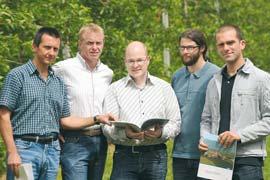
*Other genotypes were added in 2006 (4551, H0909)
Following advice given by Prof. Osler of the University of Udine, who has already had some experience with these 3 rootstocks in Friuli, plant distance was adapted to the specific needs of each rootstock.
A randomized block schema with four replicates and 5-7 trees per replicate was used.
Agronomic value was assessed by measuring each test tree for:

▪ biometrical data: trunk sectional area, height and width, presence of burr knots;
▪ yield, expressed as number of fruits per tree and tons/ha;
▪ yield efficiency, expressed as the ratio between productivity and vigour.
34 Annual Report IASMA Research Centre 2007
Crop quality was ascertained on the basis of the whole crop of the trees tested, all fruits being measured for:
▪ size;
▪ weight;
▪ shape;
▪ presence of russeting;
▪ ground colour;
▪ overcolour.
Results
At planting all trees were well feathered and fully formed, so that a good structure was present in both commercial and apomictic rootstocks. While similar above the ground, the trees on apomictic rootstocks could be easily distinguished by their massive root systems and long, smooth rootstocks.
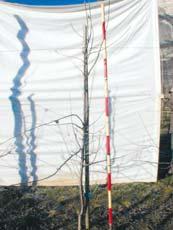

Unlike M9 and M26, the trees grafted onto the apomictic rootstock C1828 showed some difficulty in overcoming transplantation stress in the first year, particularly in the heavy soils of Maso Maiano in the Non Valley, while D2212 did not appear to suffer from the massive reduction of the roots required by its large root system. All trees were left virtually unpruned at planting, while bending of the limbs was performed during summer to enhance precocity and productivity. Again, in winter 2006 the trees underwent little or no pruning, while in 2007 all trees were subjected to modern long pruning techniques (Fig.1).
Given the short duration of the study, three years so far, it is, of course, not possible to draw any conclusions regarding the suitability of ARs as replacements for M9 or M26. Nevertheless, preliminary observation may be reported. CO725 and C1828 induced low vigour, but also low productivity (Tab. 1-3) and were prone to becoming chlorotic and even sick.
Parallel SMAP studies also raise questions regarding their AP tolerance and it is possible that these nonspecific symptoms are a consequence of AP infec-
tion or susceptibility to latent viruses. In similar parallel SMAP studies, D2212 was found to be the most AP resistant AR and quickly developed a robust structure, a potential for high yields. The cumulative yield per tree of D2212 at the third year of planting was often higher than M9. In terms of yield efficiency (crop/vegetation), all of the ARs were well below the commercial standards, M9 and M26 (Tab. 1-3).
The low precocity of D2212 was more pronounced in the case of a difficult cultivar such as Renetta. Despite high vigour and low precocity compared with M9, D2212 showed good flower bud production for 2008 in all three cultivars. D2212 greatly benefits from the hilly environment of the Non Valley, which gives rise to a more gentle behaviour. In these conditions, a relatively strong rootstock may even be preferred to M9. The skin finish of D2212 (russeting or red overcolour) was comparable to or better than M9. The wide tree spacing chosen for D2212 was adequate, but spindle training produces big shady trees in the long run. A palmetta-like training system with different shapes (double/tri axis) will be tested in the future with the aim of controlling some of the excessive vigour and improving fruit exposure to sunlight.
35 Annual Report IASMA Research Centre 2007 PART 2 | DEPARTMENTS | AGRICULTURAL RESOURCES DEPARTMENT
M9 D2212
Fig. 1 - Different tree sizes of Red Chief (Val d’Adige, 2007)
Apomictic rootstock resistance to AP in the field



In a parallel trial the same trees grafted onto AR and onto M9 rootstocks were planted in 2005, close to a plot highly infected with AP and not treated against psyllids, the main vector of AP.
A considerable percentage of M9 trees showed marked AP symptoms and leaf reddening in 2006 and 2007 while so far all the trees grafted onto ARs seem to be free of AP (Tab. 4).

36 Annual Report IASMA Research Centre 2007 PART 2 | DEPARTMENTS | AGRICULTURAL RESOURCES DEPARTMENT
Tab. 1 - Vegetative and productive data of Golden Delicious in the Non Valley
Tab. 2 - Vegetative and productive data of Red Delicious in the Non Valley
Tab. 3 - Vegetative and productive data of Renetta Canada in the Non Valley
Tab. 4 - Visual presence of AP and related symptoms (reddening) in several cultivars grafted onto apomictic and commercial rootstocks in the Non Valley (2007)
While cattle farming is declining in almost all areas of the Alps, sheep and goat breeding has shown a steady or even upward trend in recent years. The development of objective methods for evaluating the suitability and estimating the potential of mountain pastures for sheep and goats was the objective of a specific workpackage in the Alpinet Gheep project co-ordinated
by the Autonomous Province of Trento as Lead Partner and supported by the European Union in the Interreg. IIIb Alpine Space Programme.
Two methodological approaches were developed within an interdisciplinary approach: a quantitative one, utilising remote image-sensing data, and a qualitative one, based on expert assessments. The present report
Definition of the study area, suitability criteria and scores
Study areas were defined on the basis of land legally classified as pasture. In the province of Trento, the survey areas were defined by reference to both the cadastre and the forest utilisation plan which form part of the contract for the lease of the pasture. The qualitative model takes into account three basic criteria: land cover, water availability and slope. Land cover is classified in categories (or structural types) based on vegetation structures that are easily recognisable and identifiable in the field. For every study area, these types have been identified and mapped through orthophoto interpretation and field observations. For every structural type, three phyto-sociological relives were carried out on every pasture. The map of land cover was then classified according to suitability scores ascribed to the different structural types.
The watering points were localised on the technical maps available for every region from the local authorities. The distance maps from both flowing (creeks, sources, sinks, tubs) and standing water (swamps, lakes, ponds) were then calculated and reclassified according to the suitability scores.
Daniela Turri Giorgio De Ros
briefly outlines the results of the implementation of the qualitative model in four areas of Trentino (Malga Agnelezza, Malga Sadole and Malga Juribello in Val di Fiemme and Malga Covel in Val di Pejo).
A more detailed analysis is presented in the report published by the Austrian Federal Research and Education Centre, RaumbergGumpenstein.
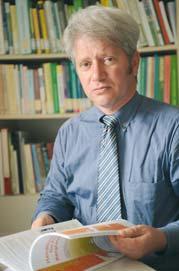
Assessing the suitability of alpine pastures for sheep and goats
The map of slope inclination has been drawn up on the basis of the digital terrain model (DTM), with a square cell matrix structure and a sampling distance of 10 metres. The map obtained was reclassified according to the suitability values.
For every selected criterion, a suitability score was attributed using a scale from 1 to 5 proposed by an FAO document on Land Suitability Classes (1 = permanently not suitable, 2 = currently not suitable, 3 = marginally suitable, 4 = moderately suitable, 5 = highly suitable). Given the lack of experimental data on sheep and goat behaviour in Alpine environments, the scores were assigned mainly on the basis of expert assessment.
The model may be integrated with additional criteria. In Trentino, for instance, since goats seem to prefer diversified environments and in order to take into account the heterogeneity of vegetation, the Interdispersion Juxtaposition Index (IJI) was calculated for each pasture. This index is an analysis of the spatial configuration of patches of landscape, in our case the different vegetation types, highlighting the dispersal and coverage of the different vegetation types in the total area. The wider the heterogeneity of the vegetation, the higher the index.
37 Annual Report IASMA Research Centre 2007 PART 2 | DEPARTMENTS | AGRICULTURAL RESOURCES DEPARTMENT
Results
In Malga Covel 87% of the total surface belongs to the higher suitability classes (4 and 5) for goats. This is due to the wide open, although rarely rich, pasture areas, together with the extensive areas covered by leaf bush (Table 1), while even the morphology seems to favour these animals which have a great ability to move about on hill flanks with a relatively steep (between 20° and 40°) slope. The suitabil-
ity scores for sheep give slightly different results: 60% of the surface belongs to the two higher suitability classes.
Concerning Malga Sadole, 74% of its surface falls into the two higher suitability classes for goats; the most suitable areas are located around the Malga’s buildings and outbuildings and the formations of leaf bushes (above all Alnus) on the idrographic right of pasture.
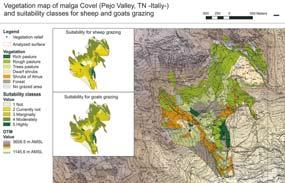
The surface with higher suitabil-
ity for sheep drops to 58% of the total area, mostly concentrated in the open flat surfaces at the valley bottom (Table 2).
In Malga Agnelezza 80% of the surface has good or very good suitability values for goats. Concerning the sheep, the model assigned scores of 3 and 4 to 80% of the pasture’s area. According to these results, therefore, this malga is more suitable for goats than for sheep.
In Malga Juribello the larger area falling within class 5 for sheep compared with goats indicates this pasture to be more suitable for sheep grazing. In any case, the areas with the highest suitability scores for sheep and for goats are quite different and, therefore, complementary.
To compare the suitability of the different pastures, weighted averages (using the area as weight)
of the scores for each criterion were calculated and summed up as a synthetic value of suitability. The Interdispersion Juxtaposition Index (IJI) of vegetation was also used just for the goats.
Although all the surveyed areas show good suitability values for sheep and goat grazing, Malga Covel, Malga Sadole and Malga Agnelezza are more suited to goat grazing, while Malga Juribello appears to be more suited to sheep grazing.
It is interesting that Malga Agnelezza is less suitable for goats than Malga Juribello if just the basic parameters are taken into account, yet turns out to be more suitable when the interdispersion index is included; the use of this additional criterion allows for a more realistic analysis of pasture suitability.

38 Annual Report IASMA Research Centre 2007
| DEPARTMENTS | AGRICULTURAL
DEPARTMENT
PART 2
RESOURCES
Vegetation 2.67 3.15 3.56 3.93 Slope 4.44 4.52 4.21 3.93 Water 4.69 4.74 4.98 4.81 AVG VALUE 3.94 4.14 4.25 4.23 IJI 0.81 0.85 0.67 0.83 TOTAL 3.19 3.51 2.85 3.51
MALGA MALGA MALGA MALGA AGNELEZZA COVEL JURIBELLO SADOLE
Table 1 - Synthetic suitability index (goats) calculated for the study areas
Vegetation 2.31 2.80 3.41 2.50 Slope 3.44 3.50 4.52 3.52 Water 4.69 4.74 4.98 4.81 AVG VALUE 3.48 3.68 4.30 3.61 IJI = = = = TOTAL 3.48 3.68 4.30 3.61
MALGA MALGA MALGA MALGA AGNELEZZA COVEL JURIBELLO SADOLE
Table 2 - Synthetic suitability index (sheep) calculated for the study areas
Wine grape ripening, and therefore quality, results from the interaction of various factors: grape and rootstock variety, climatic conditions, geomorphometric attributes of vineyards, soil type and properties and agricultural practices. Climatic conditions during the growing season are particularly influential during the ripening process and account for most of the annual differences in production and quality. Climatic data and indices have been often used to build regional thematic maps and to identify new areas suitable for viticulture.
Roberto Zorer
Mario Malacarne
Enzo
Mescalchin
Marco Stefanini
Bioclimatic model
Amerine and Winkler (1944, Hilgardia, 15: 493-673) developed a traditional method of classifying grape growing areas based on cumulative degree-days of heat, defined as the total summation of average degrees above 50º F (10° C) during the typical growing season from April to October in the Northern hemisphere (Eq. 1).

Eq. 1
In this study, ripening curve data and growing degree days (GDD) heat sum, calculated from 1st April to the cluster sampling date, was used to calculate regression lines of GDD versus total soluble solids (TSS) of 11 grape varieties in more than 100 vineyards over 7 years. Annual and mean accumulation rates of each variety, given by the slope of the regression lines and expressed as °Brix/°C, were calculated. The X-axis intercepts [GDD (°C)] were also registered as a precocity parameter.
Varieties, sampling and analysis
The study was conducted at 109 vineyards on 7 fieldgrown red (Cabernet Sauvignon, Lagrein, Marzemino, Merlot, Pinot noir, Schiava, Teroldego) and 4 white (Chardonnay, Mueller Thurgau, Nosiola, Pinot gris) varieties of Vitis vinifera (L.). Sampling was carried out over 7 years, from 2000 to 2006, usually 3-6 times per variety and vineyard with
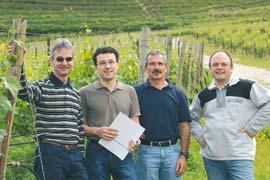
10 clusters per sample collected during the grape ripening period from the beginning of August to the end of September. The clusters were immediately pressed (2.5 bars) and the juice filtered through cotton wool before a total soluble solid analysis was performed.
Growing Degree Days calculation

Calculation of Growing Degree Days - GDD (base 10° C) - for each vineyard and sampling date were modelled using the data collected hourly by 63 weather stations throughout the province, whose altitudes range from 83 to 1035m a.s.l. Complete weather data records go back to 2000. We assumed a logistic growth model of degree-days (GDD) increasing initially at an exponential rate α until the approach of a limit or capacity k where the growth slows, producing the familiar symmetrical S-shaped curve. Finally, β is the location parameter which shifts the curve in time but does not affect its shape (Meyer P.S., Yung J.W., Ausubel J.H. 1999. Technological Forecasting and Social Change, 61, 3: 247-271). In addition, all GGD values from each meteorological station were normalised by the corresponding maximum (Eq. 2), calculated at the end of October of each year. In this way the normalised degree-day values (GDDN) varied from 0 to 1 and showed a typical annual trend with little variation between sites.
Eq. 2
39 Annual Report IASMA Research Centre 2007
Parameterisation of an empirical ripening model for eleven grape varieties
Model parameterisation for eleven varieties
Modelling of normalised growing degree days showed that the annual trend is almost independent of altitude and could be described by a logistic curve whose values range from 0 (1st April) to 1 (31st October).
The maximum value of GDD was linear, inversely proportional to the vineyard’s elevation, and the mean regression coefficient of 7 years of observations was 1.03 ± 0.01 GDD m-1 (Tab. 1; m values); the Y intercept values define the maximum GDD calculated at 0 m a.s.l. (Tab. 1; q). Correlations were always highly significant (r > 0.94; p < 0.05). Sugar accumulation can also be described by a logistic equation and is therefore linearly correlated with growing degree days. Fig. 1 shows the mean regression line coefficients (slope, X and Y intercepts) for the 11 varieties calculated over 7 years for the different vineyards. Pinot noir (Fig. 1B) showed the maximum rate of sugar accumulation per degree day (0.033 ± 0.02 °Brix °C-1) followed by three white varieties, Chardonnay, the local variety Nosiola and Müller Thurgau, three local

The altitude of the sites affects the annual maximum GDD value linearly (GDD31-Oct; Eq. 3).
Eq. 3
The best-fitting curves were obtained using a least squares method by changing interactively α, β and k. Finally, the growing degree days value for a specific vineyard and day was calculated as the product of the normalised value of GDD at the sampling date
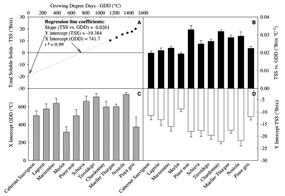
and the maximum value of GDD at the site altitude. For each variety, vineyard and year, linear regression analyses were performed between growing degree days and total soluble solids in order to calculate the regression coefficients, X and Y intercepts (Fig. 1A). The slope of the regression equation indicates the accumulation rate, expressed as TTS (°Brix) per unit of GDD (°C). The X intercept indicates the amount of GDD needed to start sugar accumulation from 1st April and could be interpreted as a precocity parameter.
red varieties, Teroldego, Schiava and Marzemino, and Pinot gris, Lagrein, Cabernet Sauvignon and finally Merlot (0.19 ± 0.01 °Brix °C-1). X intercepts of the regression lines indicate the GDD required to start sugar accumulation, calculated from 1st April, and represent a “precocity” parameter. Merlot and Pinot gris showed the lowest values (317 ± 60° C and 374 ± 111° C respectively). Many local varieties (Nosiola, Teroldego, Schiava, Marzemino) are characterised by a high GDD requirement (mean values from 640 to 734° C). The effects of limiting conditions, such as excessive temperature or low water availability, are not included in the model, neither is the role of management practices or soil properties, which are decisive for quality production (Jones G.V., Nelson P., Snead N. 2004. GeoScience Canada, 31(4): 167-178).
The linear relationships between vineyard altitude and growing degree day and between GDD and TSS accumulation are useful for building GIS-based regional thematic maps and for identifying new areas suitable for viticulture.
40 Annual Report IASMA Research Centre 2007
YEAR m q r r2 2000 -1.038 1898 -0.955 0.911 2001 -1.047 1875 -0.954 0.911 2002 -1.009 1815 -0.959 0.920 2003 -0.983 2126 -0.953 0.908 2004 -1.061 1932 -0.959 0.920 2005 -1.041 1907 -0.964 0.929 2006 -1.031 1957 -0.942 0.887
Fig. 1 - Results of the linear regression analyses between growing degree days and total soluble solids
Tab. 1 - Slope coefficients (m) and intercepts (q) of the regression line between altitude and maximum growth degree day values (GDD31-Oct). r = Pearson’s correlation coefficient between observed and predicted values
Apple storage using repeated and controlled gas stress
Livio Fadanelli
The Postharvest Unit’s first experiments were carried out in Trentino in 2000 as demo trials of ILOS (Initial Low Oxygen Stress) on commercial apples Red Delicious, Granny Smith and Golden Delicious. The results in terms of scald control and quality preservation (flesh firmness and acidity) were promising in AC ULO + ILOS up to 210 days storage and 10 days shelf life.
After several years, the ILOS technique was applied in 10 storerooms of 4 co-operatives in 2007 and 2008; in particular, multiple controlled gas stress was tested in 2-3 applications in storage. The latter technique is based on keeping O2 at 0.5-0.7% and CO2 below 1% for 8-15 days. The level of ethanol, measured weekly in the fruit flesh of 20 apple samples, determines when to turn back to ULO gas parameters (O2 1-1.3 % e CO2 1.1-1.5 %). The measurement method was set up with the help of the QAA Dept. of FEM-IASMA. This experiment showed that when the levels of ethanol fail to reach a given upper limit, turning back to normal O2 and CO2 levels decreases the amount of ethanol to almost zero without altering the apple taste. Results from 2007 (the 2008 experiment is in progress) showed it is possible to control scald in apples during up to 8 months of storage without any chemical treatment, to maintain quality during the trading and distribution period and to obtain a shelf life of 10-15 days.
Thanks to a grant from a local foundation (Fondazione della Cassa di Risparmio di Trento e Rovereto), IASMA began a major apple breeding programme in 1999. The main goal of this programme is to improve fruit quality (appearance, taste and shelf-life), vegetative habitus (compactness, spuring and columnar shape) and resistance/tolerance to major pathologies (fire blight, apple scab, and powdery mildew).


We have bred about 65,000 seed-
lings from 452 different crosses. Of these, 50,000 have now been planted on 10 hectares (Giaroni and Maso Zancanella farms) while 16,000 are still in the greenhouse in individual pots.
In 2005, we began the first pomological checks on crosses made in 1999. From analysis of the 20,000 seedlings now in production, we have identified 150 interesting new genotypes. We are evaluating three plants of each type as a second-level follow-up. At the present time, three breeds in particular show considerable promise in terms of high quality fruit.
41 Annual Report IASMA Research Centre 2007 PART 2 | DEPARTMENTS | AGRICULTURAL RESOURCES DEPARTMENT In brief
The apple breeding programme Pierluigi Magnago
Novel grapevine genotypes from crossing
Marco Stefanini, Alessandra Zatelli,
Dorigatti,
Through gamic grapevine breeding we have developed two collections of novel genotypes: a hybrid line of about 2,000 genotypes, selected for resist-
ance/tolerance to peronospora, and a line of Vitis vinifera crosses of around 6,000 genotypes. Our goal was to use the huge variation in the Vitis genera to create new varieties or hybrids which are able to adapt to a variety of real world micro-environmental contexts.
The most sought-after traits include resistance to abiotic and biotic stresses, composite berry quality (aromatic and poliphenolic content), and propogation/production characteristics related to vegetative habitus (phenology, bunch structure, botritys tolerance, berry size, and canopy vigour).
We are currently conducting propagation and evaluation of more than 100 genotypes, mostly for winemaking.
Evaluation of the agronomic characteristics of wine and table grapevine hybrids
Luca Zulini
All traditional European grapevine varieties (Vitis vinifera L.) are susceptible to the most destructive fungal diseases (downy and powdery mildew, grey mould), while most interspecific varieties are more or less resistant to them.
Resistant hybrid vines may considerably reduce the need to apply plant protection compounds, substantially and effectively contributing to the protection of the environment. Most countries involved in breeding new interspecific varieties over

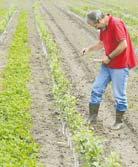
the last 20-30 years are located in northern grapevine production areas, so there is a lack of data on the use of new hybrids in warmer climates. We carried out a field trial with the aim of discovering the agronomical characteristics of about thirty hybrid vines bred in various countries.
Fungus-resistance, yield quantity and quality were evaluated and most varieties were found to be satisfactorily adaptable regarding yield and fruit quality. Studies on grape hybrids continue, with further evaluation of yield
quality and, in particular, the content and characteristics of wine flavour.
42 Annual Report IASMA Research Centre 2007
PART 2 | DEPARTMENTS | AGRICULTURAL RESOURCES DEPARTMENT
Cinzia
Monica Dallaserra, Silvano Clementi, Tiziano Tomasi
Ecophysiology and biochemistry laboratory
We use the following instruments for the descriptive study of plant response to ambient conditions and causal analysis of ecologically dependent physiological mechanisms:
Facilities and Equipment
Leaf gas exchange
Compact Minicuvette System Walz CMS 400
Portable Gas Exchange System Walz HCM 1000
Oxygen Electrode Chamber Hansatech LD3
Leaf chlorophyll fluorescence
Portable Chlorophyll Fluorometer Walz PAM-2000
Chlorophyll Fluorometer Walz PAM-210 (TEACHING-PAM)
Leaf optical property
Plant Chlorophyll Meters Minolta SPAD 502
Spectroradiometer UV/VIS StellarNet EPP2000
Proximal sensing instruments Skye Spectrosense 2+
Data loggers and micro-climatic sensors
Data loggers Campbell Scientific CR10, CR10X, CR1000
Multiplexers Campbell Scientific AM25T, AM16/32
Net radiation Schenk pyrradiometer 8111
PAR global and diffuse Delta-T BF3
Air temperature and humidity
Rotronic MP101A
Soil temperature Campbell Scientific 105T
Soil water potential
Soil water content
CS 257 Gessetti Watermark
CS 616 TDR
Lisimeter for Soil Water Samples 1900L/12 /24 /36
Canopy measure and structure
SunScan System Delta-T Sunscan SS1 and BF3
Fisheye lense Nikon FC-E8
Software Gap Light Analyzer 2.0
Software GIS ESRI ArcGIS 9.1 Pro Edu
Plant water status
Plant Water Status Console Model 3005 Soil Moisture Equip.
Biochemistry laboratory
SDS-Page e Western Blotting System BioRad
Nitrogen determination Kjeldahl System FOSS
Microfine grinder drive IKA MF10
Disperser
Spectrophotometer
Must and fruit analysis
Crison automated titratator
Digital refractometer
Pimprinnelle TR 53210
Texture analysers (Canon Powershot G7 e Nikon D80)
UltraTurrax T25
SHIMADZU UV-VIS 1601
Breeding and production optimisation
We use the following facilities and equipment for breeding, clonal selection and production
Propagation and nursery techniques
600 m2 of heated greenhouse
3 polythene greenhouse tunnels
Cultivar improvement
5 ha of new grape cultivars (7,000 genotypes)
10 ha of new apple cultivars (6,000 genotypes)
Cultivation management
20 ha of apple cultivation under direct management
50 ha of supervised private vineyards

43 Annual Report IASMA Research Centre 2007 PART 2 | DEPARTMENTS | AGRICULTURAL
RESOURCES DEPARTMENT
GENETICS AND MOLECULAR BIOLOGY DEPARTMENT
Riccardo Velasco

PART 2 | DEPARTMENTS | GENETICS AND MOLECULAR BIOLOGY DEPARTMENT
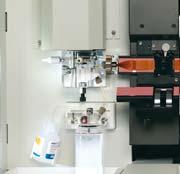
In the early 1990s, the centre’s biotechnology unit was set up within the chemistry department, and competencies in genetics, molecular biology, genomics and applied biotechnology grew rapidly. This led to the creation of the Genetics and Molecular Biology (BGM) Department in 2005. The department’s 45 researchers, fellows and technicians work in three research units.
Genomics and Bioinformatics (GBI) unit
With important competencies in various aspects of genetic research, the Genomics and Bioinformatics (GBI) unit currently has two important genomics projects in progress. The unit has reconstructed the 19 chromosomes of the grapevine genome and the 17 chromosomes of the apple genome, and has built several dense molecular maps. The physical map of the grapevine genome was reproduced by assembling over 50,000 BAC clones. The complete genome sequence, assembled and annotated, is associated with genetic maps and is available on the IASMA web site (http://genomics. research.iasma.it/iasma).
The annotated grapevine genome has also been deposited in international gene banks and was published in the journal PLoSONE in December 2007. A similar undertaking is in progress for the apple genome and is scheduled for completion in early 2008. Transcriptional profiling of differentially expressed genes dur-
ing ripening, and biotic and abiotic stress are further objects of study by the unit. Software for genetic and genomic tasks, as well as for database management and data mining, are also being developed.
Molecular Genetics (GM) unit
The Molecular Genetics (GM) unit concentrates on translating basic knowledge of the genomes of grape, apple and soft fruits — Trentino’s most important crops — into useful tools for breeding.
Development of molecular maps
44 Annual Report IASMA Research Centre 2007
and markers is an essential part of the unit’s molecular breeding programme. In addition, molecular markers are being implemented for the characterisation and certification of plant varieties and species.
The unit is also involved in correlating markers and phenotypic traits, with particular attention focussed on QTLs and monogenic traits related to pathogen resistance for Rubus, Vaccinum, and Fragraria; quality traits such as aroma compounds, polyphenols and secondary metabolites in grape and apple; flower and seed development in grape.
Cellular and Molecular Biology (BCM) unit
The Cellular and Molecular Biology (BCM) unit is dedicated to gene isolation and the characterisation of gene function. The unit employs various functional genomic tools, including PCR select, differential display, AFLP-TP and differential library screening to isolate the genes involved in response to apple and grape pathogen attack. Cell culture of grape is also used for testing elicitor induction which mimics pathogens.

The kinetic responses of the cell are monitored biochemically and at the gene expression level. Since the early 1990s, the unit has also carried out grapevine transformation work.
Recent developments
The department has recently turned its attention to public perception of genetically modified organisms (GMOs). The BCM and GM units have together set up a GMO detection laboratory for food and feed to cover both research and service needs.
Another joint project, titled “translational genomics in apple and grape”, is aimed at the definition of gene function, monogenic traits and QTL position on maps as well as allelic variants. Interdisciplinary approaches are essential for the success of such programmes and, in this respect, the IASMA Research Centre is ideally placed. The centre can now expand on the basis of having sequenced two genomes and has the capacity to investigate other genomes such as those of pathogens or soft fruits. It is also engaged in the resequencing of different varieties and species of grapevine and apple. This is a 5-year programme, exploiting basic apple and grape genome research in order to create applied research tools for biotechnology and breeding purposes. It will be funded and developed jointly by this department and the Agricultural Resources departments, both playing major roles, and with the additional participation of the Agrifood Quality and Plant Protection departments.

45 Annual Report IASMA Research Centre 2007 PART 2 | DEPARTMENTS | GENETICS AND MOLECULAR BIOLOGY DEPARTMENT
Grapevine resistance to pathogens: a genomic overview
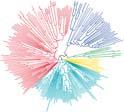 Giulia Malacarne
Flavia Moreira Michele Perazzolli
Giulia Malacarne
Flavia Moreira Michele Perazzolli
Grapevine (Vitis vinifera
L.) is the most widely grown fruit crop with an annual production of more than 67 million tons, while its derivatives have a large and expanding world-wide market. However, grapevine cultivars are susceptible to many pathogens, either by direct infection of the berries themselves or through the reduction of plant vigour, both of which reduce fruit quality and yield. Disease control is currently carried out by intensive use of pesticides, with an undesirable environmental impact. To reduce excessive use of phytochemicals in the vineyard, alternative strategies have been explored. Many longstanding breeding programmes have been established in the past aimed at combining V. vinifera fruit quality traits with resistance traits brought in by other Vitis species. This has, however, proved to be a difficult task, due to the quantitative nature of resistance determination, the long generation time, and the high heterozygosity and inbreeding depression of grapevines. The recent discovery of the Pinot Noir genome sequence represents an important new resource in tackling the problem and provides us with the possibility of defining the genomic regions responsible for resistance traits and of identifying the candidate genes underlying the known resistance Quantitative Trait Loci (QTLs).
Looking for Resistance genes in the Pinot Noir genome

Plants have the capacity to recognise and reject pathogens at various stages and they respond to infection using a two-branched innate immune system. The first branch recognises and responds to molecules common to many classes of microbes while the second responds to pathogen-specific virulence factors through the gene-to-gene pathway. This patovar-specific recognition mechanism is peculiar to cultivated plants displaying dominant resistance genes which mediate the signal transduction cascade leading to deployment of the defence mechanism. The majority of these resistance proteins contain a nucleotide binding site (NBS) and a leucine-rich repeat domain (LRR). The LRR domain recognises specifically the pathogen effector trough via an antibody-like interaction, whereas the NBS domain acting as a molecular switch transduces the signal to the downstream signalling network. Based on resistance domain analyses, we found that the Pinot Noir genome contains 341 resistance genes, a number comparable to other sequenced plant species, such as Arabidopsis (207) and poplar
(398). Phylogenetic analysis of grapevine resistance genes reveals 5 major clades (Figure 1) corresponding to 5 different families, identified by their different domain compositions. These resistance genes are preferentially located on LGs 5, 7, 9, 12, 13, 18 and 19 and they are associated in clusters and superclusters, as previously reported (Figure 2). Members of the same cluster generally belong to the same phylogenetic clade, suggesting tandem gene duplication as the main mechanism for gene clustering. When clusters are, instead, composed of genes of different clades, ectopic recombination or chromosomal recombination may occur.
Using the genome for molecular breeding
Disease resistance genes represent a significant portion of the grapevine genome. In spite of this, many grape cultivars, including Pinot Noir, are susceptible to several pathogens, which may be due to defective pathogen recognition. Resistance genes are undergoing diversifying pathogen-stimulated selection and allelic variability in resistance domains has been associated with resistant and susceptible cultivars. This suggests that in grapevine resistance alleles have not
46 Annual Report IASMA Research Centre 2007
Figure 1 - Phylogenetic analysis of Pinot Noir resistance genes. The phylogenetic clades correspond closely to the classification based on protein domains: TIR-NBS-LRR in blue; CC-NBSLRRa in green; CC-NBS-LRRb in yellow; NBS-LRR in cyan; CC-NBS-LRR in red
co-evolved in the presence of its pathogens. However, since resistance syntenic regions have been observed in several Vitis species, information about the resistance gene loci positioned on the Pinot Noir genome can be of great interest in defining the candidate genes responsible for resistant phenotypes in resistance hybrids. To investigate this, we compared the position of the resistance genes on the Pinot Noir genome with the QTLs for downy mildew resist-



Figure 2 - Pinot Noir LGs on which a large number of resistance gene clusters were found. Resistance genes according to phylogenetic analysis are represented by coloured dots, and molecular markers of the genetic map (http://genomics.research.iasma.it) are shown on the left together with the interval in cM between the two closest markers in each gene cluster. The localisation of published (red) downy mildew QTLs and those identified at IASMA (black) is also presented on the left in correspondence with the closest molecular markers
ance. The QTL experiments at IASMA were based on two hybrid grape progenies obtained from the cross ‘Moscato bianco’ x V. riparia and one from the cross ‘VRH3082 1-42’ (V. rotundifolia x V. vinifera) x ‘Sk77 5/3’ (V. amurensis x V. vinifera), segregating for downy mildew resistance. Interestingly, QTLs localised in LGs 1, 6, 9 and 13 are actually in correspondence with clusters of resistance genes positioned on the Pinot Noir genome (Figure 2), consistent with previous reports. Interestingly, the major QTL for downy mildew resistance identified in the grape hybrid ‘Regent’ was also found to co-localise with a resistance gene cluster in the distal part of LG 18. Precise knowledge of the position of resistance genes is hence of great value in order to isolate candidate genes responsible for traits of interest.
Conclusions
The grape genome sequence now opens up the opportunity to establish a new breeding plan for this crop. The resistance gene clusters identified here can be associated with QTLs affecting disease resistance in grape varieties or their tolerance behaviour. The large and underexploited reservoir of resistance genes uncovered by the genome sequence could be easily moved in clusters across wild and cultivated genomes by selective adoption of appropriate molecular markers. This would then prevent the occurrence of undesirable traits inherited from the wild parental lines which are used as a resistance source in traditional breeding, and alsothe loss of alleles which are important for berry quality.
47 Annual Report IASMA Research Centre 2007 PART 2 | DEPARTMENTS | GENETICS AND MOLECULAR BIOLOGY DEPARTMENT
A B
Figure 3 (A - B) - Sporulating grapevine leaves infected with Plasmopara viticola
Towards a ‘marker free’ transgenic grapevine: comparison of different strategies
Lucia Martinelli
Lorenza Dalla Costa
“Clean” strategies for exogenous gene transfer into grapevine



In grapevine, the gene transfer technique is based mainly on in vitro co-culture of plant tissues with Agrobacterium tumefaciens carrying the gene to be transferred (Martinelli & Mandolino, 1994, Theor. Appl. Genetics 88:621-628). An efficient regeneration protocol is essential. Besides, an effective discrimination between the cells that have inserted the foreign gene and those that haven’t is crucial. The latter have to be removed from the cultures, usually as a result of their ability, conferred by an exogenous marker gene, to survive in a medium to which an otherwise toxic antibiotic has been added. Thus, marker genes – which usually confer resistance to antibiotics - are typically associated to the gene of interest
during its transfer to the plant. Given that marker genes have the exclusive function of helping the gene transfer process, their presence in transgenic plants may become undesirable. Moreover, their use is becoming one of the more controversial and less socially accepted issues of transgenic plant production, and antibiotic-resistance genes will in the future be banned (regulation 2001/18/CE).
Our research is aimed at assessing a more suitable approach for exogenous gene transfer into grapevine plants based on “clean” tools, i.e. the elimination of antibiotic-resistant genes and the use of alternative marker genes. Our study is part of a research project supported by the Autonomous Province of Trento (EcoGenEtic. Com) aimed at setting up innovative and safer methodologies for gene transfer into grapevine.
Gene transfer into grapevine
Gene transfer was performed during co-cultures of grape embryogenic calli with the Agrobacterium tumefaciens strain LBA4404. Cefotaxime was added to the culture medium after a two-day co-culture to prevent further Agrobacterium contamination.
The initial concentration of 300 mg/l was gradually reduced to 50 mg/l during the following subcultures. When the neomycin phosphotransferase gene (nptII) was present in the construct, kanamycin was added to the medium one month after the Agrobacterium co-cultures. Its initial concentration of 50 mg/l was gradually increased to 150 mg/l during the embryogenic callus subcultures. Embryo conversion into plantlets and micropropagation were induced on an antibiotic-free medium.
Embryo subcultures and plantlet regeneration and micropropagation were performed as described in Martinelli et al. (2001, Vitis 40 :111-115).
48 Annual Report IASMA Research Centre 2007
Ilaria Vaccari
Valentino Poletti
A B
Fig. 1 - Shoot expressing the GFP gene after induction with the 17-β-estradiol: (A) bright field, (B) dark field, GFP1 filter
Marker gene removal
To eliminate the marker genes after the insertion of the target gene, we exploited the self-excision strategy based on site-specific recombination. Embryogenic calli of V. vinifera ‘Brachetto’ were co-cultured with Agrobacterium carrying the chemically-inducible site-specific cre/loxP pX6 vector with the gene for the Green Fluorescent Protein (GFP) and the gene for the nemicin phosfphotransferase (NPTII) as marker gene (kindly provided by The Rockefeller University of New York, Prof. Nam-Hai Chua, Zuo et al., Nature Biotechnology, 2001, 19: 157-161). A second construct was applied, where the GFP gene was replaced with a conserved coat protein sequence of the Grapevine Virus A (GVA) in sense and antisense orientation, coding for a hairpin RNA (pX6-pKcpGVA, Turturo et al., 2003, Proc. 14th ICVG Conference, Locorotondo, Italy, 12-17 Sept.). In both constructs, the expression of the cre recombinase was regulated by the 17-β-estradiol.
Putatively transgenic cultures were selected on kanamycin, and individual somatic embryos were isolated and converted into plantlets. Southern Blot and Real-time PCR analyses proved transgene integration. Several tests for optimizing the induction with β-estradiol for removal of the marker gene were performed on a genetically modified line produced with the pX6-pKcpGVA construct. The hormone was applied on buds induced to plant elongation. The Real-time PCR was employed to quantify the nptII gene removal. Applications of 10 μMβ-estradiol for 1 month produced 40 % of nptII removal. No significant differences were noticed when a concentration of 20 μM was used, nor when the hormone was added in the solid medium rather than poured in a liquid phase on the buds.
The success of nptII gene removal seems to vary along the plant since maximum efficiency was detected in the roots, quantifiably decreasing in samples collected from the root to the apical parts of the plants.
Alternative marker genes
The use of marker genes that make cells able to metabolise specific carbon sources - such as mannose as an alternative to sucrose (Posytech, Sygenta licence) - produced controversial results in grapes (Kieffer et al., 2004 Vitis 43:35-39).
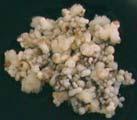

Preliminary assays were necessary to verify the effect of mannose on our grape cultures during the most crucial phases from somatic embryogenesis to plant recovery. Embryogenic calli of ‘Brachetto’, ‘Chardonnay’ and ‘110 Richter’ were grown and subcultured monthly on media added with mannose or sucrose or free of the carbohydrate source. In the calli cultured on mannose no clear evidence of a lethal effect was noted even after an extensive culture time (14 months). As a consequence, estimation of the effect was difficult and relied more on the operator’s subjective evaluation than on objective evidence. No growth and a gradual death was observed in the carbohydrate-free media. Embryo conversion into plantlets was also effected by mannose, with the exception of ‘110 Richter’.
Conclusions
Our results show that additional work is needed on grapevine before applying these two “clean” strategies for gene transfer. The use of the phosphomannose isomerase gene proved to be unsuitable since remarkably long times are required for discriminating transgenic from non-transgenic tissues and a possible genotype effect was noted; in addition, the cost of mannose is extremely high compared to the cheap sucrose that is usually added to the culture media.
A further relevant attribute of the “clean” technique is related to the option of limiting the genetic material transferred to a plant to the strictly required traits. For this reason, the Cre/loxP system would seem to be more suitable since the insertion of the marker gene allows an effective selection method to be taken advantage of, while its subsequent removal eliminates the undesired genetic material that was inserted during the gene transfer process. For this reason, our work continues, aimed at improving induction of the exogene removal.
49 Annual Report IASMA Research Centre 2007 PART 2 | DEPARTMENTS | GENETICS AND MOLECULAR BIOLOGY DEPARTMENT
A B
Fig. 2 – Effect of mannose (A) on the embryogenic callus of ‘Brachetto’ compared with the control with sucrose (B) after 12-month cultures
QTL mapping of volatile compounds in apples detected by PTR-MS
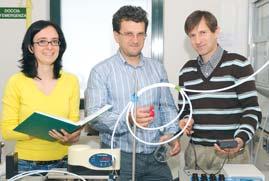 Elena Zini Franco Biasioli
Elena Zini Franco Biasioli
Matteo Komjanc
Volatile Organic Compounds (VOCs) play an important role in research on fruits and more generally on agro-industrial products because they have a direct bearing on perceived sensory quality. They also provide a non-invasive and rapid tool for the monitoring of many metabolic and physiological processes which may be induced by, for example, ripening, storage and conditions brought about by stress, including wounding or plant-insect interaction. Proton Transfer Reaction-Mass Spectrometry (PTR-MS) is a fast and direct tool for the on-line detection of a wide variety of VOCs. It is based on an original implementation of soft chemical ionisation by proton transfer from protonated water and provides an absolute estimation of concentration with a detection limit of only a few parts per trillion.
FEM-IASMA has a well-established record in research on PTR-MS applications in food science and technology and has, in particular, demonstrated that it is possible to identify the cultivar of single whole strawberry fruits (Granitto et al., Sensors and actuators B: Chemical, 2007, 121(2): 378-385) and that information embedded within PTR-MS data can be
linked to gene expression (Carbone et al., Molecular breeding, 2006, 18(2): 127-142). On the basis of the latter developments, we decided to investigate if PTR-MS fingerprinting of VOCs emitted by ripe apples can be used to identify putative quantitative trait loci (QTLs) linked to distinct levels of particular VOCs.
In a preliminary study, apple fruits were picked from each of 57 genotypes of the progeny ‘Fiesta’ X ‘Discovery’ at Cadenazzo, Ticino (Switzerland).

PTR-MS analyses were carried out at FEM-IASMA on 2 apples collected from the same plant of each genotype. Measurement consisted in the direct sampling for 4 minutes of the volatile mixture formed in the headspace of a whole apple closed in a glass vessel at room temperature.
Spectra from a mass/charge ratio from 20 up to 240 were examined (Zini et al., Euphytica, 2005, 145: 269-279). QTL analyses of the ANOVA estimates of the traits for each genotype were carried out on an intensity of 220 PTR-MS peaks using the software Map®QTL 4.0 to combine phenotypic and genetic marker data.
We showed that it is possible to find quantitative trait loci (QTLs) related to PTR-MS characterisation of the headspace composition of single whole apple fruits indicating the presence of a link between molecular characterisation and information from PTRMS data. In particular, qualitative comparison of overall PTR-MS spectra indicates a good level of agreement between data from fruits of the same genotype (data not shown) and the presence of
polymorphic effects. QTL analysis allowed ten genomic regions associated with seven spectral intensities (m/z = 28, 43, 57, 61, 103, 115, 145) to be identified. The percentage of phenotypic variation explained by the QTLs ranged from 18% to 48% (Table 1, Figure 1). Separate QTL analyses of the two replicates provided comparable results (Zini et al., Euphytica, 2005, 145: 269-279).
The encouraging results of this first experiment led us to eval-
50 Annual Report IASMA Research Centre 2007
Figure 1 - Map location of the putative QTLs detected for m/z = 28
uate more apple fruit genotypes (105) of the same progeny described above but grown in three different locations in Switzerland (Conthey, Cadenazzo, Wädenswil).

PTR-MS and QTL analyses were carried out as in the previous experiment and, although data are still under analysis, we can confirm QTLs for 4 of the 10 genomic regions previously detected. QTL mapping was consistently confirmed for all three different environments and in one location we identified the same QTLs in both years (Table 1). QTLs for m/z = 28 (Figure 2) and m/z = 43, 57 and 61 were significant in all three environments only for genomic regions localized in LG 2 and LG 15 respectively. Fragment masses 43, 57 and 61 were mapped in
the same positions and in heterozygous individuals we found the expected linear relationship for esters (e.g. m/z = 43 and m/z = 61, Figure 3). Segregation of the phenotypic traits related to the fragments considered is evident. This result applies to the first experiment reported (one location), but was confirmed in all environments after one year. The markers in LG2 for m/z = 43 and 61 may, therefore, be considered as markers for the presence of esters and, in particular, acetates. The other genomic regions (m/z = 103, 115 and 145) were confirmed only for the Cadenazzo progeny, as found in the previous experiment, indicating that the phenotypic effects of these QTLs were sensitive to the environment in which they were evaluated.
Table 1 - Putative QTLs detected for PTR-MS spectral features (m/z) Asterisks (*) indicate QTLs confirmed in the three different environments investigated after one year
The work described here is an initial attempt to associate the variability of VOC emission, directly measured by PTR-MS, with the genome and has, in fact, resulted in the identification of associated QTLs. A future step will involve an assessment of associating VOCs with sensory and physiochemical traits with the aim of identifying quality traits using a simple and fast method of measurement, such as PTR-MS, and of identifying linked molecular markers,
allowing for fruit characteristics on young juvenile seedlings to be predicted.
This work was carried out in collaboration with Prof. Cesare Gessler (ETH, Zurigo), Prof. Tilmann D. Märk (Innsbruck University), Dr. Flavia Gasperi and Dr. Eugenio Aprea (FEM).
This work was awarded ‘best poster presentation’ at the XLVIII SIGA (Società Italiana Genetica Agraria) Annual Congress.
Figure 2 - Correlation between intensity of the signal at m/z = 28 and allelic composition of marker CH02d11 in LG 15. Genotypes presenting the allele ‘b’ with homozygous status show higher intensities
Figure 3 - Signal at m/z = 61 versus the signal at m/z = 43. Solid points (●) refer to individuals homozygous for the 158 bp allele from SSR locus CH02F06, while the open points (o) refer to heterozygous individuals. Crosses (+) refers to samples without QTL data
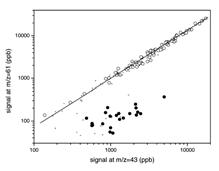
51 Annual Report IASMA Research Centre 2007
Linkage Parental Position LOD score LOD score m/z group mapa cM for the first for second Explanation dataset dataset 28 15* F 51 6.4 7.7 48% 15* D 11.6 3.5 4.1 28% 43 2* F 0 2.9 2.6 20% 2* D 2.9 3.4 2.9 24% 9 F 14.3 2.9 2.6 20% 14 D 6.1 3 2.6 24% 43* 2* F 0 3.7 3.9 26% 2* D 2.9 5.5 4.3 33% 4 F 7.9 2.6 2.7 18% 57 2* F 0 4.6 3.6 27% 2* D 2.9 3.1 3.1 22% 61 2* F 0 3.8 3.9 26% 2* D 2.9 5.2 5.3 35% 9 F 14.3 2.7 2.6 23% 14 D 6.1 2.8 2.9 25% 103 14 F 15.1 3.6 2.7 25% 1b D 10.3 2.5 2.4 18% 3 D 0 2.7 2.6 23% 115 1b D 10.3 4.1 2.8 24% 145 4 F 7.9 2.8 2.7 20% a F=Fiesta, D=Discovery
Marker assisted selection of seedlings resistant to Apple Proliferation (AP)
Claudia Bisognin
A breeding programme was started 6 years ago within the Project SMAP to obtain AP-resistant apple rootstocks suitable for modern fruit growing. 20 combinations used M. sieboldii and its hybrids as donors of the resistance trait.
Despite different degrees of apomixis and polyploidy, 3300 individuals were bred from these genotypes, although not all were genuine hybrids. 1240 sexually derived seedlings were identified, using a rapid test based on DNA markers, and graft-inoculated with Ca. Phytoplasma mali; seedlings with a molecular profile identical to the maternal parent, considered derived through apomixis, were discarded. Symptoms were recorded every year and a qRT-PCR assay quantified phytoplasmas in the roots. Results show the resistance trait is inherited by the progeny. Agronomic evaluation is to follow.
Fig.1 - Recombinant progeny seedlings graftinoculated with Ca. Phytoplasma mali. They are kept in the nursery for two years then transplanted in the field to evaluate the phenotype

Bioinformatic platform for grape and apple

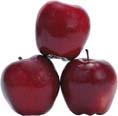 Paolo Fontana, Alessandro Cestaro
Paolo Fontana, Alessandro Cestaro
Our bioinformatic programme consists mainly in mining and analysing the data provided by the grape and apple sequencing projects. To extract information from these genomes we developed a software platform that integrates data from gene prediction with those from functional annotation.
Once the genome sequences become available they are immediately processed using different gene predictors and the results are clustered on the basis of their accordance. The annotation process of the predicted genes is based mainly on knowledge discovery in databases, exploiting Gene Ontology and identi-
fying the protein domains and metabolic pathways to which a gene belongs. We thus obtain a complete picture of localisation, function and the biological process in which a given protein is involved. This information is made available to biologists who use it to plan and guide their laboratory experiments.
52 Annual Report IASMA Research Centre 2007 In brief PART 2 | DEPARTMENTS | GENETICS AND MOLECULAR BIOLOGY DEPARTMENT
Molecular dissection of the grapevine defence reaction against Armillaria mellea
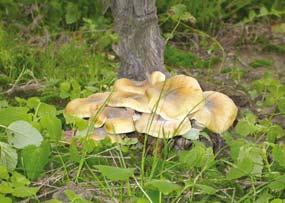 Michele Perazzolli, Federica Bampi, Anna Maria Ciccotti, Ilaria Pertot, Claudio Moser
Michele Perazzolli, Federica Bampi, Anna Maria Ciccotti, Ilaria Pertot, Claudio Moser
The fungus Armillaria mellea is the main causal agent of grapevine root rot in Trentino and other wine producing areas. A. mellea infection causes a decline in vigour followed by plant death. Since young grapevines in infected soil do not show A. mellea symptoms during the first 2-3 years, the activation of resistance mechanisms was investigated. A library of genes induced in young roots of the rootstock Kober 5BB 24 hours after fungal treatment revealed the presence of defence
genes such as thaumatins and protease inhibitors. Gene expression experiments confirmed their rapid upregulation in young roots during A. mellea challenge. In order to characterise the role of these genes, the corresponding recombinant proteins were expressed and purified. Functional assays demonstrated that one of them displays antibacterial properties and reduces the A. mellea growth, suggesting its involvement in protection mechanisms.
Development of a strategy for detailed molecular characterisation of genetically modified grapevines
 Lucia Martinelli, Lorenza Dalla Costa, Ilaria Vaccari, Valentino Poletti
Lucia Martinelli, Lorenza Dalla Costa, Ilaria Vaccari, Valentino Poletti
A strategy for evaluating exogene copy number was developed on Vitis vinifera cv. Brachetto plantlets expressing neomycin phosphotransferase (nptII) exogene obtained with embryogenic calli and Agrobacterium co-cultures. The nced2 (9-cis-epoxycarotenoid dioxygenase) and chi (chalcone isomerase) genes were found to be valuable reference endogenes for Real-time PCR assays. Standard curves were built with ad hoc duplo-target plasmids carrying sequences of reference endogenous and exogenous genes, simulating an ideal genetically modified plant homozygous for a foreign gene inserted at a known copy number. Two duplo-target plasmids were equally valuable (p-nptII/nced2 and p-nptII/chi), both containing a sequence of the nptII exogene alternatively linked to one of the two endogene sequences. Using our method, combination of Southern Blot and Real-time PCR assays gave interesting information on copy number integration.
53 Annual Report IASMA Research Centre 2007
The functional genomics of grape berry quality
Stefania Pilati, Antonio Dal Rì, Pamela Gatto
We have recently completed characterization of the Pinot Noir berry transcriptome during ripening using the Affymetrix Vitis chip.
A set of 1,861 genes appeared to be modulated and 8% of them were annotated as transcription factors, supporting the hypothesis of strict transcriptional control. Ethylene influence was investigated by measuring its accumulation during ripening and the gene expression levels of putatively related genes. Physical interactions between ethylene responsive transcription factors and their targets is inferred by a bioinformatic/molecular integrated approach based on gene co-expression and promoter analyses. Phenolics, responsible for berry colour and taste, have a notable effect on wine quality. Transcriptional and structural analyses of the phenolics’ biosynthetic genes revealed the presence of a complex organization in gene families and a marked interaction with specific ripening metabolisms.
Identification of grape microRNAs and their target genes

Azzedine Si-Ammour
MicroRNAs (miRNAs) are tiny RNAs of about 21 nucleotides in length. They trigger RNA cleavage of cognate mRNAs in a sequence-specific manner. Using sequences of the plant model Arabidopsis thaliana miRNA as a reference, we identified 143 miRNAs in the grapevine genome representing 28 families. These miRNAs mainly target transcription factors involved in leaf and flower development, as well as key factors in resistance against biotic and abiotic stress. Furthermore, genes that encode RNA-dependent DNA polymerases

54 Annual Report IASMA Research Centre 2007 PART 2 | DEPARTMENTS | GENETICS AND MOLECULAR BIOLOGY DEPARTMENT
The apple and grapevine translational genomics programme
Silvio Salvi
The Translational Genomics programme was established in 2007 as part of FEM and started out by recruiting new researchers with different expertises in plant molecular biology and breeding. The aim of the programme is to understand the genetic control of agronomically important traits taking the information generated within the recently completed apple and grapevine genome sequencing initiatives as a point of departure. Priority will be given to the identification of genes controlling tree habitus, flower and fruit develop-
ment, fruit quality and resistance to pathogens (e.g. fire blight and scab). The programme also plans to develop platforms for apple and grape functional genomics based on innovative technologies (gene transfer, RNA interference and TILLING) and bioinformatics.
Ultimately, we aim to improve the efficiency of FEM’s marker-assisted breeding in grape and apple and to valorise cultivars of the Trentino area by assembling and characterizing germplasm collections.
are potentially targeted by two grape miRNA families, a phenomenon not reported in other plant species.
Experimental work by the translational genomics team is in progress to validate miRNA-mediated regulation of the predicted target genes. We have also identified several proteins involved in miRNA biogenesis in the grape genome. A better understanding of post-transcriptional regulation mechanisms in grape will be useful in designing RNA interference technologies for agriculture.

55 Annual Report IASMA Research Centre 2007 PART 2 | DEPARTMENTS | GENETICS AND MOLECULAR BIOLOGY DEPARTMENT
Facilities and Equipment
TheGenetics and Molecular Biology department has all the necessary instrumental platforms to conduct molecular research on grape and apple biology.
Structural genomics platform

The structural genomics platform is composed of a tissue liophyliser, an automatic DNA extractor, a Perkin Elmer Multiprobe IIX expanded automatic liquid handler, an automatic TECAN platform, six ABI 9700 termocyclers of 96 and 384 wells, four Applied Biosystem DNA Sequencers (one ABI 310 with a single capillary, two ABI 3100 with 16 capillaries and one ABI 3730xl with 96 capillaries). These instruments are commonly used for DNA sequencing projects, molecular marker and genetic map development, and marker screening and genotyping. The platform was set up for the grape and apple sequencing projects and will be expanded next year by the addition of a second ABI 3730xl with 96 capillaries and a high throughput sequencing system such as 454 Life Science or an ABI SOLID system.
Functional genomics platform
The functional genomics platform is composed of four sterile benches for cell and tissue culture (where gene function-transgenic assays are carried out in
grape, tobacco and Arabidopsis), three real-time thermocyclers (one ABI 7000, one iCycler iQ Thermocycler (Biorad) for gene expression assays, one Amersham Pharmacia Typhoon 9210 plus phosphoimager for DNA analysis), and one radioisotope laboratory. The functional genomics unit specialises in automatic RNA extraction from grape and apple tissues for gene expression analysis of single genes as well as the entire transcriptome (Affimetrix and Combimatrix assays). An additional eight thermocyclers are distributed throughout the 800 square metres of recently equipped molecular biology laboratories. A fluorescent stereomicroscope (Leica MZ16FA) was recently set up for non-invasive GFP reporter gene detection, adding GUS and NPTII transient and stable transformation analysis to the department’s capabilities. A growth chamber area completes the facilities of the functional genomics unit. In 2008, 250 square meters of greenhouses and three additional growth chambers will increase the amount of stable transformation assays in grape, apple or model systems.
Bioinformatics platform
The core prerequisite of any structural and functional genomics assay is a strong bioinformatics platform. The bioinformatics unit runs a terabyte-sized server and a large client PC network. This unit manages the grapevine apple genome data bank which provides data through a Web interface and through a dedicated private virtual network. The data bank provides an overview of the genomes and their functional fractions by integrating genetic maps, physical maps, genomes and transcriptome assays. Bioinformatic expertise includes semi-automatic genome annotation using novel algorithms based on gene ontology.
56 Annual Report IASMA Research Centre 2007
PART 2 | DEPARTMENTS | GENETICS AND MOLECULAR BIOLOGY DEPARTMENT
Themission of the Natural Resources Department is to advance ecological knowledge for the purposes of understanding, managing and conserving biological resources for their natural, aesthetic, recreational and economic values. This task is accomplished utilising multi-disciplinary approaches which comprise both classic ecological procedures and advanced methodologies, including modern genetic analyses, molecular chemistry, information technology and geomatics. Considerable importance is given to communication of knowledge relevant to conservation and management to young researchers undertaking PhD studies. Research issues initiated in 2007 include studies on the ecology of inland waters and forests, Agrometeorology/Climatology and Aerobiology, and renewable energy.
NATURAL RESOURCES DEPARTMENT
Nico Salmaso*

Limnology
The Limnology and Fish Research unit carries out studies on the ecology of lakes and rivers, long-term research on selected sites and genetic studies on freshwater species. Within this context, studies are being conducted on the trophic evolution of lake ecosystems in the Province of Trentino, and include: long-term research on the physical, chemical and biological characteristics of Lake Garda (which has recently been included in the International Long Term Ecological Research (ILTER) network); limnological investigations for the restoration and rehabilitation of certain Trentino reservoirs; detailed research on the mechanisms controlling the development and seasonality of potamoplankton in large rivers. Further studies are being carried out on the autoecology and biogeography of planktonic taxa (dinoflagellates and rotifers) in small lakes, and on the application and development of biological and functional indices in freshwater ecosystems based on the study of epilithic and epiphitic diatoms and phytoplankton. Ichthyological research focuses on aspects of genetic diversity and restoration ecology. In particular, specific studies have examined the sustainable management of marble trout (Salmo trutta marmoratus) aimed at its conservation in the Adige basin through both genetic and ecological characterisations. Further applied investigations are being carried out on a selection of highly productive strains of rainbow trout and on the monitoring of fish in lakes and rivers.
Forest Ecology and Physiology
This research group carries out investigations on forest physiology and genetics, biodiversity conservation, and the effects of climate changes on forest ecosystems (including anthropogenic pressures) through the Integrated Monitoring Program, which is part of the International Long Term Ecological Research (ILTER) network and the national CONECOFOR project. The principal work carried out in recent years includes studies on the incidence, epidemiology and biological control of root-rot fungi in conifers, Chestnut canker and Black pine and Alder decline. Also underway are investigations on the bioethology, ecology and biological control of phytophagous species, and the taxonomic identification and biodiversity monitoring of Orthoptera and Macromycetes communities with the goal of identifying bioindicators of environmental changes. Further activities have included detailed examination of the genetic variability of Norway spruce in the Alps in relation to its ecological conservation, high stability and quality timber yield. In addition, a multi-disciplinary project concerning the ecologi-
* Gianni Zorzi (until July 2007) Nico Salmaso (from August 2007)
57 Annual Report IASMA Research Centre 2007
PART 2 | DEPARTMENTS | NATURAL RESOURCES DEPARTMENT
cal evaluation of Italian cypress in the pre-alpine landscape is aimed at developing the sustainable introduction of cypress, its potential diffusion to vocational areas and its exploitation in landscape amenity. Extension activity has also been carried out for local and national institutions. Several articles on the above-mentioned activities have been published in scientific, technical and popular journals (www.iasma.it/ UploadDocs/2960_2007.pdf).
Agrometeorology, Climatology and Aerobiology
The Agrometeorology, Climatology and Aerobiology unit carries out studies of agrometeorology, micro-scale climatology and aerobiology. The unit’s agrometeorology researchers have recently concluded a project studying frost dynamics and climate in alpine areas (the most suitable forecasting, alarm and protection techniques have been established). Further investigations have dealt with the possibility of using purified waste water in Trentino for irrigation purposes. A dissemination project has promoted the diffusion of knowledge on global climate change to the agricultural world. The research group is also involved in: service and monitoring activities, including maintenance of a network of stations to monitor agrometeorology and alpine ecosystems; testing innovative irrigation technologies aimed at optimising the use of water resources; pre-processing of meteorological data for infection modelling; application of geomatic techniques for territory analysis of meteorological data, and, more generally, of data concerning agrometeorological issues (water balance, meteorological downscaling, high-resolution climatology, etc.); local climatology investigation and the consequences of climate change on the environment and on the local agricultural system; improvement of weather forecast techniques for agricultural use; phenological surveys and modelling of crop and forest species.
Recent activities in the field of aerobiology include:
the collection of information on atmospheric pollen content for diagnosis and prevention of respiratory allergopathy; monitoring of the effects of air pollutants, using different bio-monitors such as lichens and pollen; testing innovative methods for bioaerosol identification.
Biomass and Renewable Energy
Study of the biological processes underlying the energy output of different biomasses and the development and implementation of related technologies is the main focus of this research group. One of the most interesting processes, anaerobic digestion (AD), is being studied from both microbiological and technological points of view. In particular, the quality of the output material and its possible uses are being investigated, and new systems to increase the amount of energy produced (power and thermal) are being tested and introduced. Integrated management systems, based on AD, for the treatment of animal waste (husbandry) in mountain areas with a high level of tourism (odour reduction, soil and water protection, energy recovery) have been specifically defined. Regarding wood biomass from forests and agriculture, attention is mainly focussed on collection systems, efficient use of energy by direct combustion, and new technologies such as gasification; environmental implications and related costs are also studied. Laboratory facilities have allowed for the development of modern parameters with which to assess compost stability (static and dynamic respiration index), and for the identification and measurement of environmental impact through application of new techniques such as olfactometry and electronic noses. A laboratory scale tool for advanced research on the anaerobic digestion process is being devised, and a pilot plant (AD) is being integrated with the existing composting plant. Other activities concern the mechanicalbiological treatment of solid waste before landfill disposal and technical support to local authorities and/or private companies in the sector.
58 Annual Report IASMA Research Centre 2007
PART 2 | DEPARTMENTS | NATURAL RESOURCES DEPARTMENT
Theanalysis of airborne pollen is time-consuming and requires considerable effort in terms of scientific skills. The methodology currently used (Norma UNI 11108) is based on morphologically microscopic identification of sampled particles (Faegri, Knut and Iversen, 1989). The difficulties associated with this method
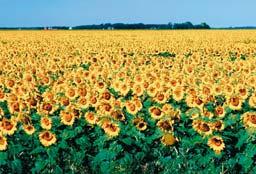
make it hard to establish a sampling network able to guarantee spatially-detailed pollen information. It is essential to know the actual pollen concentrations in order to more efficiently communicate the potential risk to the allergic population. In Trentino, aerobiological monitoring has been carried out since 1989 at
the Istituto Agrario di San Michele all’Adige – Fondazione Edmund Mach (IASMA). Our research is aimed at finding a more rapid and semi-automatic method for aerobiological sample analysis and increasing the number of sampling sites, in order to take into account the wide variability in the vegetation of this region.
A new methodological approach
The IASMA aerobiology research unit has, since 2006, been involved in co-ordinating a research project entitled CARPOL, which was established with the aim of finding suitable innovative techniques to solve the above-mentioned problems. The project is divided into two independent lines of research: bio-molecular and spectroscopic. In recent years, bio-molecular tests based on amplification of DNA regions, associated to real-time PCR and array hybridisation, have been used as diagnostic tools in several fields (Gachon et al. 2004). In fact, many DNA Barcode projects have been developed, aimed at rapid identification of different animal and vegetal species and to determine their phylogenetic links utilising short DNA sequences as bar codes (Kress et al. 2005; Chase et al. 2005). Bio-molecular research within the current project is aimed at exploiting these new technologies, detecting and amplifying specific DNA tracts by PCR reaction for each pollen taxon, and associating genetic material quantification by specific probes (real-time PCR). The objective is to apply real-time PCR to pollen specimens, determine sampled taxa and quantify their DNA content. At the same time we plan to develop a system for converting DNA quantity to pollen count. Fourier Transformed Infra Red Spectroscopy (FT-IR)
Elena Gottardini Sara Longhi Antonella Cristofori Fabiana Cristofolini

59 Annual Report IASMA Research Centre 2007
Allergenic pollens: new techniques for identification and quantification
was recently applied to the study of pollen by Pappas et al. (2003); it allows several cellular components, such as lipids, peptides, proteins, nucleic acids, sugars and many metabolites, to be surveyed contemporaneously, thus acquiring information on each compound and on its respective rates. The main objective of spectroscopic research is to characterise FT-IR spectra for known pollen samples and to build a reference spectra library. FT-IR analysis on unknown samples and comparison with spectra library should allow pollen samples to be identified.

The CARPOL project, financed by the Fondazione Caritro, involves several research units: the Aerobiology and Molecular Genetics Unit of the IASMA Research Centre, the Microsystems Division of Fondazione Bruno Kessler - in association with the University of Verona – and the Materials Engineering and Industrial Technologies Unit of the University of Trento.
Vegetal species selection

Selection of the group of plants to study within the project was made on the basis of their presence in local flora and their allergic relevance. Each species was collected from three different localities, with the aim of assuring that any genetic differences which may exist among different populations were properly represented.
Pollen samples were collected between January and September 2007, following single species flowering times; leaf samples were collected at the same time for bio-molecular analysis.
Protocol setting for pollen DNA extraction and quantification of allergenic species
The first step in the bio-molecular approach was in-silico research for taxa-specific DNA regions, developed by analysing sequences stored in on-line data banks (NCBI). Primer couples and probes were then designed on selected sequences with the purpose of applying real-time PCR. In the laboratory, DNA from the leaves was extracted to preliminary test primers and probes. The successive pollen DNA extraction required an ad hoc protocol to be set up. Amplifying specific DNA sequences allowed some allergenic species to be identified (Fig. 1) and quantification of some of them was verified quite rapidly. In addition, the possibility of applying these analyses to airborne pollen samples was tested and proved positive.
Concluding remarks
The evaluation carried out at the end of the first year of the project signals the potential of the bio-molecular approach for developing a rapid and reliable method for characterising and quantifying aero-dispersed pollen. The spectroscopy line of research, while achieving good results for pollen grain identification, is limited in its application potential due to its very time-consuming spectra acquisition and analysis.
60 Annual Report IASMA Research Centre 2007
PART 2 | DEPARTMENTS | NATURAL RESOURCES DEPARTMENT
Fig. 1 - Amplification of extracted DNA - primer designed on Corylus
Fig. 2 - Example of FT-IR spectroscopy on pure samples in KBr
Theprogressive effects of global warming over time may create in the future suitable conditions for a northward shift of the cypress cultivation area. This slender conifer, admired and praised by great poets, has already started its expansion into new areas, among them the Rotaliana plain, the Valsugana lake region and the lower Val di Non in Trentino. A similar situation is found around the big alpine lakes, as well as in several other pre-alpine regions.
In order to protect, exploit and potentiate the diffusion of this tree in northern Italy, the FEM-IASMA established a research project in 2003, financed by the Autonomous Province of Trento, which results were recently presented at a workshop in San Michele all’Adige (www.ismaa.it/sperimentazione_ context.jsp?ID_LINK=2430&area=6). The project, entitled ECOCYPRE, is officially supported by twenty municipalities in Trentino and South Tyrol and by all the northern Italian Plant Health Services. The research has been carried out by the Forest Ecology and Physiology Unit of FEM in collaboration with the Dept. of Economy of the University of Trento, the Plant Protection Institute of CNR in Florence
Nicola La Porta

and the Dept. of Environmental Agronomy and Plant Production of the University of Padua.
The ECOCYPRE project is aimed at finding a realistic solution to the increasing needs of the floristic and landscape characterisation of Trentino, a region with a particular high level of tourism and leisure land use. In this context, cypress is one of the major tree species that characterises the territory’s landscape. Cypress canker (Seiridium cardinale) is a serious disease that appeared for the first time in Europe in 1944. It caused severe damage in Trentino, as well as the rest of Italy, and for a long time prevented the planting of this species for forestry and, especially, ornamental use. Cypress is naturally present in Trentino at three different sites: Lake Garda, the Valley of the Lakes, and along the lower Adige Valley. In addition, the species is spreads scattered along roads and in parks and gardens in the main cities of Trentino and South Tyrol: Rovereto, Trento, Bolzano and Merano. The tree is an old presence in the landscapes of northern Italy where suitable micro-climatic conditions prevail, as confirmed by the finding of ancient trees, in some cases more that one thousand years old.
The main aim of the project is to study the potential of cypress cultivation at the northern edge of the range of this species, under conditions of progressive climate change which may favour the spread northward of this Mediterranean conifer. Several factors will create a favourable environment for the expansion of cypress cultivation in Trentino: the ongoing general phenomenon of “global warming” and
the rapid decline of the Austrian pine, an introduced tree species that has been until now the only conifer tree in the sunniest and warmest parts of the region. Moreover, the success of 30 years of Italian and European research on cypress breeding has provided several reliable canker-resistant cypress clones. All these contingent factors have encouraged us to carry out this project for the protection and exploitation of
61 Annual Report IASMA Research Centre 2007 PART 2 | DEPARTMENTS | NATURAL RESOURCES DEPARTMENT
Ecological assessment and sustainable management of cypress in the landscape
this tree species in suitable areas of Trentino as well as the whole adapted areas of northern Italy, in order to improve the landscape and render it more attractive to tourism.
With the aim of maintaining and protecting the existing cypress population and to increase the spread of the species in suitable environments in the region, the project’s research was focussed on the following key issues:
1. inventory and phytosanitary assessment of cypresses present in the whole Trentino district, including surveying, mapping and tabulation of the main dendrological parameters of the present trees;

2. characterisation of genetic variability among the local populations of cypress and fungus compared with other population of northern and central Italy and natural areas around
the Mediterranean basin. The aim was to provide new insights into the possible role of human and evolutionary history in shaping cypress populations and to deduce the origin of the Italian populations;
3. identification and characterisation of 24 and 36 specific genes associated respectively to cold-tolerance and cankerresistance in cypress by means of two gene expression analyses;
4. field trials in Trentino of 4000 canker-resistant plants, selected in previous programmes from Tuscany, to select for cold-tolerance and adaptability to environmental conditions in Trentino;
5. field trials in Tuscany, after vegetative propagation, of the
150 best selected cold tolerant clones from the Trentino region to assess their potential canker resistance;
6. exploration of the ecological interactions between cypress and its fungal pathogens and insect vectors at the northern boundary of its range, where it is expanding because of climate change. The aim was to study host attractiveness for the insect vectors and identify natural antagonists for use in biological control;
7. economic assessment of the landscape and amenity function of cypress in Trentino in order to develop an analytical tool with which to evaluate the importance and eco-sustainability of the local cypress and its potential spread.
The results of our research findings on the abovementioned issues, up to 2007, have been published in 38 scientific, technical and popular papers in national and international journals. Of these, 15 have been published or accepted by peer-reviewed ISI journals (www.iasma.it/istituto_context.jsp?ID_ LINK =232&area=6). In addition, project members have participated in specific scientific congresses and meetings and have held practical courses for local nursery and garden managers and other endusers. Three PhDs, three Masters degrees and one specialisation Masters degree have been carried out under the project’s auspices, and seven pluri-annual fellowships have been granted to postgraduates.
62 Annual Report IASMA Research Centre 2007
PART 2 | DEPARTMENTS | NATURAL RESOURCES DEPARTMENT
Introduction
Composting is a biological process widely used for the recovery of waste biomass. It consists in the degradation and transformation of fresh organic matter into a stabilised, mature and humified product which is used in agriculture to put humus and nutrients into the soil. Compost maturity is specifically related to plant growth potential or phytotoxicity, while stability is generally associated with compost microbial activity. The natural decomposition of organic matter in the environment takes place slowly and gradually over time without evident biochemical reactions. On the other hand, the process of composting on an industrial scale needs to be strict controlled and products characterised in order to verify their quality and phytocompatibility before soil application. The analytical parameters usually adopted do not provide enough information on compost stability. In too many cases they fall within the limits of the law even though the aspect and behaviour of the product reveals it to be still under transformation (high fermentescibility, mass temperature, odour emissions) with consequent pollution inside and, especially, outside the plant. Unstable composts can sustain high microbial activity; they may, therefore, become anaerobic during storage and transport, enhance pathogen regrowth and develop unpleasant odours and phytotoxic compounds such as low chain organic acids. When used in growing media or applied to soil, unstable composts may also immobilise nitrogen and reduce its availability to plants. These facts justify the adoption of biological tests which provide more useful information about the intensity of activities caused by microrganisms living in the mass. Respirometric techniques are widely known to be indicators of stability and are hence well-suited to this purpose.
Methods and results
The microrganisms responsible for the composting process use the organic substrate as their main source of energy and nutrients, thus consuming O2 and producing CO2 as a result of respiration activity. The presence of easily biodegradable components as sugars, proteins and carbohydrates, causes intensive metabolism (high respiration rate) which coincides with the first thermophilic phase (55-65°C). The reactions slow down when cellulose, hemi-cellulose, pectins and lignin are broken down. This happens in the second phase, known as mesophilic (40-50°C), which brings the mass to maturation. Measurement of the biodegradability level is therefore an important index of the evolution of product stability. Stability affects the potential for microbial activity in composts and consequently the potential for odour generated by the product.
Use of respirometric tests to assess the biological stability of biomass
 Silvia Silvestri Luca Grandi
Silvia Silvestri Luca Grandi
The respiration test is useful in characterising the product in both its final and unfinished states; in recent years it has been mainly used to test materials at the end of the first thermophilic phase. The transfer of organics to the curing section, in fact, often takes place in the open air without a forced aeration system and it is necessary to know the biological status of the mass in order to avoid adverse environmental impact, especially odours. Another useful application is related to assessment of the degree of biostabilisation attained by mechanical biological treatment (MBT) on unselected waste before landfill disposal.
Many laboratories have made use of specific equipment and methods in order to apply respirometry to composts. In Italy two different techniques are used: the static system, which measures the rate of the oxygen consumed by a sample in a closed ves-

63 Annual Report IASMA Research Centre 2007
Fig. 1
sel without aeration at a fixed temperature (usually 20°C) and the dynamic system, where aeration of the reactor occurs without any temperature control thus avoiding possible underestimation of biological activity due to lack of oxygen. The final output value can vary depending on many aspects, for example, the sample quantity, its moisture level, the trial temperature and its constancy, and the modality of sample storing. The respiration index (RI) is defined as the hourly mean oxygen consumption in the 24 hours of maximum biological activity.
At the BMER unit’s biomass laboratory different types of tools are available for the assessment of biomass stability, including both static and dynamic respirometers (Fig. 1 and Fig. 2). These have been used in the study of the composting process (Fig. 3 and Fig. 4) and in technical support activities in the
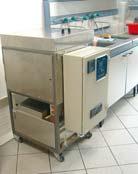
operating plants. A new analytic methodology and a new dynamic respirometer are the main results of a collaborative project with the University of Trento (Department of Civil and Environmental Engineering) and the Service for the Composting Observatory of the Environmental Agency of the Veneto Region (ARPAV). The common goal was the necessity for improving and standardising the respirometric test method in order to obtain similar results from analysis of the same samples carried out with different instruments and by different laboratories. Comparison between two static and one dynamic respirometers (more than 450 analyses) showed that under the same trial conditions output values in terms of respiration activity expressed as a respiration index, RI, are very similar. It is possible, therefore, despite the technical limitations of the static systems compared with the dynamic systems highlighted here, to reduce the differences and to obtain comparable results through the adoption of a specific procedure and the same conditions. The next step was to develop the new tool: it works at a controlled temperature and in an O2 range maintained between 20.9% and 18.5%. The prototype of the new instrument, tested by the BMER unit, proved to be easy to use and very effective in compost analysis. In light of this, the prototype is currently under development and improvement with the final objective of obtaining a commercial product.
Conclusions and future trends
Extensive experimentation with respirometric methods and techniques and definition of the parameters determining the final result have contributed to the realisation of a new analytical method and a new tool. Other possible applications of interest relate to estimation of the biological activity of contaminated soils during bioremediation treatments.

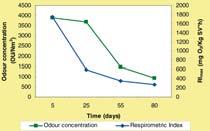
64 Annual Report IASMA Research Centre 2007 PART 2 | DEPARTMENTS | NATURAL RESOURCES DEPARTMENT
Fig. 4 - Behaviour of the parameters OU and RI during the composting process
Fig. 3 - Evolution of the respirometric index of an organic substrate under composting
Fig. 2
Lake Canzolino is a small (surface area = 0.7 km2), mid-altitude (450 m a.s.l.) lake located in SE Trentino. Although it is a dimictic lake, the spring water circulation period is very short, due to its wind-sheltered position, while summer stratification is pronounced and extends to late October. Hydraulic retention time of the lake is particularly long (ca. 5 years), due to scarce water availability in the catchment area.
Since the late XIX century, Lake Canzolino has been quite important for bathing and angling. However, like many lakes in Italy and the world, it is currently suffering from anthropogenic eutrophication, a human-driven nutrientenrichment of lake water, which triggers phytoplankton growth. Enhanced algal biomass decreases water transparency and often results in oxygen depletion of the deep lake layers, due to decom-
position of sedimented dead algal biomass. In extremely eutrophicated lakes oxygen depletion can become so great that it causes massive fish death.
Lake Canzolino was already defined as eutrophic in the 1970s, the increase phosphorus (P) and nitrogen (N) mainly due to the inflow of nutrient-rich urban waste waters. Sewage diversion instigated in the mid 1980s produced no clear improvement in trophic status due to several non-point nutrient sources (e.g. agricultural run-off). High nutrient levels were also maintained by the lake’s long retention time and by the release, under anoxic conditions, of P previously accumulated in the sediments (= internal load). A second measure consisted in the diversion of water from a stream outside the catchment area into the lake to counteract its low hydrological dynamic. However, the high
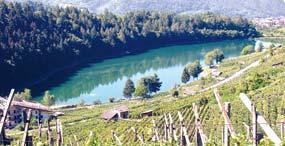
nutrient concentration of the diverted water hindered significant improvement in lake water quality. In 1994 an hypolimnetic aerator (LIMNO) was installed to raise the oxygen content of the hypolimnion, thus contrasting the P internal load. Despite improvement in water oxygenation, the decrease in P release was insufficient to significantly improve the trophic status of the lake, so that at present its use for tourism remains highly compromised.
Monica Tolotti Adriano Boscaini

In 2005, the Environment Department of the Autonomous Province of Trento funded a research project on Lake Canzolino with the aim of improving knowledge of its physical and chemical dynamics and its biodiversity and ecology, also by studying lesserknown communities such as littoral macrophytes, and phyto- and zoobenthos; defining reference conditions and restoration targets according to EU Water Framework Directive No. 60/2000; identifying realistic restoration strategies.
Since reduction of the external pollution input is essential for successful and long-term control of the negative effects of lake eutrophication, the principal nutrient sources were identified and quantified.
Nutrient release from lake sediments was estimated in the laboratory by incubating sediment cores under dark and cool lake-like conditions. The extent of the euphotic zone (the water layer where light intensity is sufficient to sustain photosynthesis) was
65 Annual Report IASMA Research Centre 2007
The ecology and experimental restoration of Lake Canzolino
Light microscope micrographs of phytoplankton (a-d) and zooplankton



(e-f) species:
(a) Cryptomonas obovata;
(b) Cyclotella radiosa;
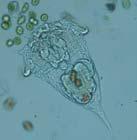

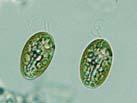
(c) Pediastrum simplex var. echinulatum;
(d) Lagerheimia ciliata;
(e) Synchaeta sp.;
(f) Polyarthra sp.
determined based on quantum irradiance depth profiles. Water temperature was continuously recorded with a thermistor chain to investigate seasonal thermal dynamics, particularly thermocline migrations during stratified periods. Trophic condition was determined based on nutrient concentrations, light climate, oxygen saturation, phytoplankton composition and biomass, and species composition of littoral diatoms.
The results confirmed previous knowledge of the physical and chemical conditions of Lake Canzolino as well as its eutrophic condition. Preliminary sedi-
ment analyses revealed eutrophic status as a relatively ancient condition, likely going back to early XIX century. The phytoplankton assemblages were dominated by non-motile green algae, accompanied by planktonic diatoms and cryptophytes, while cladocerans and copepods dominated the zooplankton. Though regularly present in the lake, potentially toxic cyanobacteria do not produce blooms. Abundance, diversity and distribution of the planktonic assemblages are characteristic of temperate, dimictic lakes with high productivity and pronounced thermal stratification.
Restoration measures
The proposed restoration measures could improve the trophic condition of Lake Canzolino by reducing both nutrient input from the catchment and the level of P already present in the lake.
Hypolimnion injection of nutrients
During thermal stratification, the thermocline represents an efficient barrier against diffusion of dissolved nutrients. Therefore, in 2008 a nutrient-rich inlet will be injected into the dark hypolimnion, where no algal growth can occur. An already existing hypolimnetic withdrawal will export excess nutrients.
Retention pond
The self-depuration capability of the stream diverted from outside the lake catchment is sufficient to retain nutrients from non-collected waste waters and agricultural activities during dry periods, while during intense precipitation nutrients are released from the stream bottom and transported to Lake Canzolino. This important, though discontinuous, nutrient input could be reduced by the construction of a retention pond upstream of the diversion point.
In 2008 the nutrient retention capacity of the wetland upstream of Lake Canzolino will be enhanced by plantumation of Phragmites australis and construction of a sand filter.
Flushing
The nutrient concentration of the lake could be reduced by dilution, using an additional nutrient-poor water source, which, while reducing the water retention time of the lake, could enhance nutrient export from both the epilimnion and the hypolimnion of the lake (via hypolimnetic withdrawal) and flush algae out of the lake faster than they can reproduce.
P-precipitation
Laboratory experiments were performed to identify optimal operating conditions and evaluate the effects on lake pH of hypothetic addition of Ca(OH)2 to the water of Lake Canzolino, which could be carried out to obtain stable co-precipitation of phosphorus and calcium carbonate.
Annual Report IASMA Research Centre 2007
PART 2 | DEPARTMENTS | NATURAL RESOURCES DEPARTMENT
a b
c d e f
Sustainable management of marble trout (S. t. marmoratus) in the Adige river basin: genetic, phenotypic and ecological characterisation aimed at conservation
Francesca Baraldi, Fernando Lunelli, Andrea Gandolfi
The main danger to the survival of Salmo trutta marmoratus comes from massive and repeated S. trutta m. fario stocking practices, putting at risk the marble trout’s genetic integrity, and increasing food competition and pathology diffusion. Anthropic alteration of water courses, excessive water exploitation and high fishing pressure are also factors that negatively affect the
Using tobacco plants to analyse ozone levels and their effects on vegetation



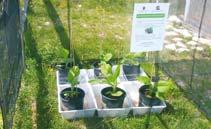

Elena
Gottardini
In summer 2007, in the province of Trento, a bio-monitoring study was carried out on tropospheric ozone, an air pollutant with high oxidative potential and very damaging to the vegetation. The study was implemented by exposing tobacco plants (Nicotiana tabacum L. cv. Bel-W3), well-known to be sensitive to the presence of ozone (Fig. 1). The results revealed the presence of ozone levels high enough to cause visible damage to sensitive vegetation; a relation between ozone concentrations - measured by diffusive samplers and automatic gauges – and the seriousness of leaf injury was demonstrated (Fig. 2). Our findings highlight the necessity of extending integrated monitoring of the pollutant over a wider area and of verifying the presence of ozone-induced injuries on natural vegetation.
survival of the taxon.
The aims of the study are:
1) to find the residual components of native marble trout populations along the entire Adige basin; 2) to restore, in quantitative and qualitative terms, such populations; 3) to identify and protect suitable environments, in particular those frequented during the reproductive stages, and to support selfmaintaining populations.
67 Annual Report IASMA Research Centre 2007 PART 2 | DEPARTMENTS | NATURAL RESOURCES DEPARTMENT
In brief
Fig. 1Fig. 2
Integrated research on the improvement of commercial fishery production in Trentino in terms of yield of the proceeded products of the species Oncorhyncus mykiss (Rainbow trout)
Fernando Lunelli, Filippo Faccenda

The aim of this project is to study the biotic and abiotic factors which influence the rainbow trout’s productive yield in the province of Trentino, thus providing breeders with a scientific contribution to the improvement of production in their fishery plants.
The project is divided into three phases: the first is dedicated to studying the present yields of the rainbow trout within the framework of a food industry; the second is to compare 5 different strains of trout, having selected the most suitable ones for rearing which will be then monitored in a performance test in fishery or controlled conditions: the third phase will be directed at analysing the data obtained and giving guidelines to breeders, aimed at improving productivity in their fish farms.
Long-Term Ecological Research on Lake Garda
Nico Salmaso
Project PlanAdige: river plankton as a tool to investigate the ecological quality and management of Adige waters
Andrea Zignin, Barbara Centis and Nico Salmaso
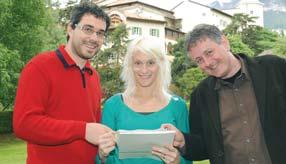
The PlanAdige project, which is promoted by the river Adige Basin Authority, is aimed at deepening knowledge of the ecological mechanisms that characterise one of the most important Italian rivers. The research, involving collaboration between several Environmental Agencies, is focussed on five piedmont stations located in the provinces of Bolzano, Trento, Verona and Rovigo. More precisely, the project’s objectives are to i) find the most significant variables affecting overall development of the algal biomass and seasonal selection of the main potamoplanktonic groups; ii) assess forecasting models of algal biomass development; iii) evaluate the quality of the waters through the formulation and application of indices based on the composition and relative quantities of benthic and pelagic microalgae; iv) identify the toxic potential linked to the development of cyanobacteria, especially in relation to the use of water in the plain zone for drinking.
During the last fifteen years, extensive limnological research has been carried out in the large and deep Lake Garda. The data were collected at monthly intervals according to scientific monitoring criteria, and represent one of the longest data sets obtained from an Alpine lake. In light of this research, Lake Garda has recently been added to the group of sites included in the International Long Term Ecological Research (I-LTER) network. In the context of the I-LTER, our research is essential in understanding the functioning of deep lakes and the way they respond to anthropic pressures and to climate constraints at different time scales.
The consistency of the data collected and verification of their level of generalization are tested by comparing them with data gathered by the different research groups studying other deep Southern Alpine lakes.
68 Annual Report IASMA Research Centre 2007 PART 2 | DEPARTMENTS | NATURAL RESOURCES DEPARTMENT
The department has facilities and equipment for conducting research on forest ecology and biology, limnology and fisheries, biomass and renewable energy, as well as agro-meteorology, climatology and aerobiology.
Forest ecology and physiology
This unit has all the classical dendrological instruments, including a Haga Ipsometer, a Clinometer, a Bitterlich Relascope Optical distance meter, telemeters, binoculars, Pressler’s increment borers, an Incremental Hammer and dendrometric callipers.
Laboratory work is supported by optical microscopes, stereo microscopes, sterile laminar flux cabinets, thermostats and incubators for microbiological cultures.
Tree stability tools include a Resistograph and a Picus Sonic Tomograph.
Molecular laboratory facilities include a Gradient thermocycler, a Gradient multiple robotisable thermocycler, microcentrifuges, a fluorimeter, horizontal and vertical electrophoretic chambers, a Phytotrone for tissue and plant growth, as well as freezers and refrigerators.
Facilities and Equipment
Limnology and fish
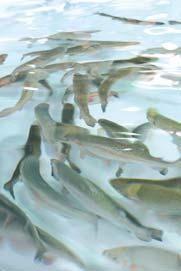
The limnological field facilities of the limnological research group include 2 rubber dinghies, 2 multi-probe sondes, a FlowTracker Handheld ADV Sonntek, an underwater Quantum sensor LI-192 SA, a Kajak corer and an Eckman dredge for sediment sampling. The unit also has several laboratories. These include the hydrobiology and microscopy laboratory, equipped for analyses of basic limnological variables (photosynthetic pigments, dry weight, dissolved oxygen, water turbidity, macrophytes) and of phytoplankton, picoplankton and periphyton samples (microscopes, invertoscopes, fluorescent microscopy, image analysis). The analytical and environmental chemistry laboratory is equipped for analysis of the major ions and nutrients (phosphorus, nitrogen and silica) by means of spectrophotometry and ion chromatography.
The genetics laboratory has the principal analytical tools, i.e. PCR, horizontal and vertical electrophoresis, sequencing (capillar electrophoresis), and software for data analysis. Finally, the research unit’s resources include a vast pisciculture equipped for the breeding and reproduction of several fish-stocks.
Biomass and renewable energy
The biomass laboratory is equipped with three dynamic respirometers for assessing the biological stability of samples collected during composting and after the mechanical biological pre-treatment of residual solid waste. An olfactometer ECOMA (mod.TO7) and an electronic nose
are used to monitor odour release and the environmental impact of different waste treatment plants. Respirometric tests and air analyses follow standardised methodologies. A complete pilot-scale composting plant is available, consisting of all the sections present in a full-scale treatment facility: a waste pre-treatment area, an intensive bio-tunnel phase with air treatment using a biofilter, a curing section and a compost sieving area.
Agrometeorology, climatology and aerobiology
The meteorological centre manages a network of 80 real-time meteorological stations spread over the main agricultural and forest areas of the Province of Trentino. Data are collected by a three-tiered information system consisting of a database server, an application server and a Web server.
The electronic meteorology laboratory is equipped with calibration instruments for temperature, radiation and moisture sensors, oscilloscopes, function generators and precision digital multimeters. Other meteorological instruments include: a disdrometer, sonic anemometers, an IR video camera, a TDR reflectometer, a data logger for temperature and humidity, multichannel data loggers, and other sensors. The aerobiology sector has a set of five automatic pollen samplers, and the geomatics sector is equipped with four workstations, an A0 plotter and precision GPS devices.
69 Annual Report IASMA Research Centre 2007 PART 2 | DEPARTMENTS | NATURAL RESOURCES DEPARTMENT
Claudio Ioriatti

Thedepartment’s mission is to provide support and improved control strategies for integrated plant protection based on new knowledge and new technologies. Most of our work is dedicated to apple, grape and soft fruits, the main crops of the Province of Trento. The department handles a range of services from plantdisease diagnostics to pesticide registration, as well as research on sustainable crop protection strategies and the introduction of new technologies to farmers and industry.
Our plant diagnostic services include insect identification, nematode analysis, and fungal and bacterial disease diagnosis. Foliar and root diseases caused by fungi, bacteria, viruses and nematodes can be difficult to identify in the field and often require laboratory confirmation through sophisticated instrumental analyses (PCR, DAPI and ELISA). Prompt identification of the etiological agent contributes to improving the efficacy of the control measures suggested by the Extension Service, and also
helps in identifying introduced diseases and pests.
The department provides research and technical services to assist the agrochemical industry in registering pesticide compounds for agricultural application. In particular, we conduct a wide range of laboratory and field studies that support pesticide registration under Italian and European legislation. All studies are conducted in full compliance with good experimental practices (GEPs), and in conformity with European Plant Protection Organisation (EPPO) guidelines.
This allows a vital link between researchers and Extension Service consultants to be maintained. The department promotes research which enhances the sustainability of fruit production and is thus beneficial to the region. We are dedicated to discovering and accessing knowledge that contributes to safe food production, the maintenance of environmental quality and the preservation of natural resources and ecological systems.
The research areas we are currently focusing on are detailed below.
Pesticide side effects on beneficial organisms
The implementation of integrated pest management (IPM) relies heavily on knowledge of the effects of pesticides on important natural enemies present in the crop. As a consequence, the assessment of pesticide side effects on natural enemies, such as predatory mites, is important in selecting IPM-compatible products.
Innovative semiochemicals and biocontrol agents for pest and disease control
Mating disruption, as currently applied to insects, is the practice of continuously dispensing synthetic sex attractants onto a crop for extended periods of time in order to suppress pest reproduction by interfering with mate finding. This pest management strategy is particularly promising in the management of moths and other pests that rely on long-distance chemical communication.
70 Annual Report IASMA Research Centre 2007
PART 2 | DEPARTMENTS | PLANT PROTECTION DEPARTMENT PLANT
PROTECTION DEPARTMENT
The Trentino region is recognised as a pioneer in Italy in the application of behavioural modification strategies for pest control in both apple and grape. Improvements to this pest control tool may be made through the study of volatile metabolites in plants that guide insect herbivores to their host plant for oviposition. These chemicals are of interest from an ecological and evolutionary perspective.

Co-occurrence of volatile plant compounds has been shown to play a role in host plant shifts and is probably also at work in sympatric speciation. Information about the chemical signal which attracts gravid females is essential in plant breeding for insect resistance and can also be used directly to improve insect monitoring and control.
Pesticide resistance in apple pests

Over the last 20 years, the department has developed integrated pest management programmes for conventional apple orchards in Trentino. The approach is based on the use of a restricted number of selective insecticides for controlling key pests. The programme is now threatened by the development of insecticide resistance in codling moth Cydia pomonella. Early detection of insecticide-resistant populations is of paramount importance in implementing effective integrated resistance management programmes. We are conducting studies on the interrelations between the resistance spectrum and resistance mechanisms.
The aim is to set up an efficient method for assessing insecticide resistance risk and for designing resistance management programmes for field use.
Apple proliferation disease: short-term control strategies and resistant rootstock breeding
Apple proliferation disease, a serious affliction of apple, was first reported in Trentino in the early 1950s. However, a serious epidemic broke out only in the late 1990s. The disease led to important economic losses due to undersized fruits with poor taste.
A specific phytoplasma, the Candidatus Phytoplasma mali, is associated with the disease. Non-cultured, phloem-restricted phytoplasmas are transmitted by man through grafting, and latently infect planting material. The phytoplasmas are spread naturally by psyllid vectors and two Cacopsylla species, C. picta and C. melanoneura, which have been identified as Candidatus Phytoplasma mali vectors in northern Italy and in Germany.
As no curative treatments are available, control of the insect vectors is the most promising short-term way to prevent further spread of the disease. To develop efficient control strategies, it was necessary to identify the vectors in Trentino, study their biology and understand their transmission parameters. We are also seeking a more durable solution through an ongoing breeding programme to develop resistant plant material.
71 Annual Report IASMA Research Centre 2007 PART 2 | DEPARTMENTS | PLANT PROTECTION DEPARTMENT
Communication mediated by Semiovibrationals and Semiochemicals in Scaphoideus titanus, vector of grapevine Flavescence


dorée
Valerio Mazzoni
Gianfranco Anfora
Claudio Ioriatti
The American grapevine leafhopper, Scaphoideus titanus Ball (Hemiptera Cicadellidae), was accidentally introduced into Europe at the end of the 1950s. Since then, the species has become widespread in vine growing areas of Central-Southern Europe. The leafhopper causes major damage to the host plant, not by direct feeding activity, but by transmitting the phytoplasma of Flavescence dorée, Candidatus Phytoplasma vitis, a yellow grapevine disease that is quarantined in the European Union. Chemical treatments are imposed in vineyards where the vector and the disease co-exist. Efficient control depends primarily on the timing of the treatment, which is based on monitoring the presence of nymphs in the vineyards by direct field-sampling.
Despite the significant economic implications of S. titanus, intra- and inter-specific communication has not been sufficiently studied until now. In particular, mating communication and olfactory sensitivity, as well as the role of plant volatiles in the host selection, have never been investigated before. Such knowledge is fundamental for developing sustainable management strategies for vector control based on communication disruption. We are thus directing our efforts towards two main objectives:
a) providing essential information on the reproductive behaviour of S. titanus, with emphasis on vibrational intraspecific communication; b) ascertaining the involvement of olfactory cues in recognition and orientation of the host plant.
Intraspecific communication (mating) mediated by Semiovibrationals
Our results show that mate recognition and location in S. titanus is mediated by vibrational signals that run through plant tissues with dominant frequencies below 900 Hz (Mazzoni et al., 2008, Bull. Ent. Res.: submitted).
Signals are recorded by means of a laser vibrometer. Two emission types characterise the male repertoire: the calling signal (MCS) and the courtship phrase (MCrP). MCS is the signal emitted by a male while looking for a female over the grapevine vegetation. It is part of the typical leafhopper “call and fly” strategy. In S. titanus, the male, after emitting a series of MCSs, jumps from one leaf to another and repeats the sequence, possibly until a receptive female is found. MCrP is a sequence of regularly repeated sound elements.
Unlike the MCS, it is made only after the male is aware of the presence of a female nearby and, consequently, it represents
a short range means of communication on which the courtship strategy is based. MCS consists of a series of pulses (MP1) that are associated with slow dorsoventral movements of the abdomen. MCrP is composed of four sections characterised by different specific features.
During the first three sections the male keeps a stationary position on the leaf and performs the courtship song by alternating MP1s with stronger pulses (MP2).
In section 4, however, the male moves in search of the female while making very rapid abdominal shaking movements. This section always ends with a strong single pulse, similar to an MP2, associated with a powerful body
72 Annual Report IASMA Research Centre 2007
shake and a wing-flicking movement.
The female emits simple pulses in response to the male’s MCS and MCrP pulses, thus constituting a mating duet (MD) with the suitor. Females are always static during the MD and never initiate the communication. The peak in sexual activity occurs at twilight and in the early night period. Our observations of S. titanus also indicate the existence of complex male-male interactions, including disruption of an existing duet by masking the MCrP with a specific “male disturbance noise” (MDN) and satellite behaviour (e.g. eavesdropping - silent males approach a duetting female). Our results indicate that these rivalry tactics can be successful in preventing the male that initiated the duet copulating with the female. In conclusion, the male-female duet appears to be essential for successful localisation of the female and subsequent copulation.
It is, however, vulnerable and easily disrupted by alternative tactics, such as masking. Preliminary tests with artificial mating disruption clearly showed that the playing back of vibrational signals (especially of MDN) was effective in disrupting the MD. Further experiments should provide the means to develop effective and low environmental-impact control of these insects.
Interspecific communication (host plant) mediated by Semiochemicals
We investigated the involvement of olfactory cues in recognition and orientation of S. titanus nymphs in the search of a host plant (Mazzoni et al., 2008, J. Econ. Entomol.: submitted). We tested the attractiveness of grapevine tissue with behavioural bioassays in a Y-shaped olfactometer and electroantennographic responses (EAG) to volatile extracts from a grapevine rootstock. In addition, we examined the external morphology of antennae in order to detect the presence of potential olfactory sensilla. S. titanus was shown to respond to compounds emitted by the grapevine tissue tested. Behavioural tests with Y-olfactometer indicated grapevine tissue to be highly attractive to the nymphs and support the initial results showing that olfaction may play a role in interspecific communication between S. titanus and its host plant. The ability of the leafhopper to perceive host plant volatiles was also confirmed by the EAG studies, performed for the first time on this species, and by observation with a scansion electron microscope. Further studies are needed to verify if single or blended active compounds may be applied in future pest control strategies. In fact, in the case of S. titanus, because of the lack of efficient physical and chemical attractants to nymphs, the only monitoring method currently used is direct field sampling, which requires trained technicians and is time-consuming. For this reason, development of a suitable semiochemical-based tool for insect monitoring would be extremely useful.


73 Annual Report IASMA Research Centre 2007 PART 2 | DEPARTMENTS | PLANT PROTECTION DEPARTMENT
Trichoderma atroviride SC1: a new, patented fungal strain for biocontrol of plant diseases


 Ilaria Pertot
Ilaria Pertot
Trichoderma is a cosmopolitan genus, which can colonize soil, rhizosphere and phyllosphere, certain species of which are frequently found on decaying wood and vegetable material. Several strains are economically important producers of industrial enzymes and some are also used as biocontrol agents (BCAs) against numerous plant pathogens. Quite a few Trichoderma strains have been developed for use as commercial biocontrol products for field and greenhouse crops and several biofungicides based on micro-organisms have already been patented.
Trichoderma atroviride SC1 was recently patented as a biocontrol agent for the suppression of the spread of fungal diseases on aerial parts of plants and on roots. Three treatment methods have also been developed.
The SC1 strain of Trichoderma atroviride showed a greater ability to suppress several fungal diseases in plants and is easily cultivable on several media; it adapts to a wide range of environmental conditions and survives for a long time in soil and in the phyllosphere. All these characteristics make Trichoderma atroviride SC1 a valuable antagonist against fungal plant pathogens.
T. atroviride SC1 is a mesophilic fungus, like most Trichoderma spp., and is therefore suitable for use in normal plant growth conditions. The maximum temperature for T. atroviride SC1 survival is lower than human body temperature, a good indication that this fungus is not pathogenic to humans. The pH tolerance levels of T. atroviride SC1 fall within the usual range for Trichoderma
strains. The a w tolerance range of T. atroviride SC1 is ≤ 0.910, which corresponds to the high relative humidity conditions preferred by most fungal plant pathogens. Monitoring the fate and behaviour of a micro-organism released into the environment is of utmost importance. Registration of a specific biocontrol agent (BCA) as a pesticide in Europe requires risk-assessment based on the
persistence and multiplication of the BCA in the environment, as well as evaluation of potential contamination (viable and non-viable BCA residues) of foodstuffs. These legal requirements necessitate the use of monitoring methods that can accurately identify the released strain, distinguish it from the native microbial community and track its population dynamic over time. A
74 Annual Report IASMA Research Centre 2007 PART 2 | DEPARTMENTS | PLANT PROTECTION DEPARTMENT
Figure 1 - Effect of Trichoderma atroviride SC1 on the severity of powdery mildew infection of artificially inoculated cucumber (upper) and courgette (lower) and comparison with untreated and suphur-treated plants and a biocontrol reference (Trichoderma harzianum T39). Columns with the same letter are not significantly different according to Tukey’s HSD (P≤0.05)
molecular approach (Real Time PCR) was developed to track and quantify T. atroviride SC1 in the environment.
T. atroviride SC1 can survive for a long time on the phyllosphere and in soil. This characteristic is regarded as positive for a biocontrol agent.
We demonstrated that T. atroviride SC1 can suppress the development of powdery mildews, tracheomycoses (Esca disease) and fruit and root rot. This biocontrol agent can be applied to plants, to the leaves of plants, to wounds made during cutting or to the soil to suppress the development of fungal disease in the plant.
T. atroviride SC1 can control powdery mildew (Podosphaera xanthii) on horticultural crops, such as cucumbers and courgettes, to the same degree as sulphur, which is one of the most widely used fungicides and has therefore been included as a standard (Figure 1). A commercial biocontrol agent (Trichoderma harzianum T39, Trichodex) was included for comparison.
T. atroviride SC1 can control the three main pathogens of Esca disease in in vitro experiments. Control against Phaeomoniella chlamydospora, Phaeoacremonium aleophilum and Fomitiporia mediterranea is highly efficacious compared with another biocontrol agent (Bacillus subtilis F77) and has a success rate close to 100 % (Figure 2).


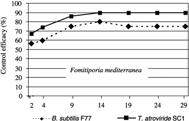

Armillaria mellea and A. gallica are the major causal agents of root rot in several crops. In Trentino, Armillaria root rot is an important root disease of grapevine. No control agents against Armillaria spp. are known at the moment. T. atroviride SC1
is effective against both these pathogens: it reduced their growth and eventually kills them. This was demonstrated with the two pathogens grown on pieces of wood under controlled experimental conditions. T. atroviride SC1 is also able to prevent infections in plants. In the case of strawberry plants, it significantly reduces the disease caused by A. mellea and A. gallica (Figure 3). A commercial biocontrol agent (Trichodex) was used as a standard for comparison.
T. atroviride SC1 can be grown in several common laboratory media such as potato dextrose agar (PDA), nutrient agar (NA), etc. For biocontrol it can be applied according to three methods:
1. inoculated and grown in nutrient broth, under continuous shake, with an optimal growing temperature between 20 and 25°C, for at least 48 h;
2. grown in sterilised boiled rice for 21 days at 25°C. An inoculum dose of 1 x 106 cfu.g-1 soil should be used. T. atroviride SC1 can be applied directly as rice or the rice can be washed in water with or without the addition of other spray adjuvants (wetting agents, emulsifiers, etc.);
3. grown on pieces of bark with or without preventive treatment with nutrient media (PDA, NA, etc.) or nutrient substances containing carbon and nitrogen sources. Barks are inoculated with T. atroviride SC1 then incubated until colonisation. Inoculated barks can be used as amenders at any time during the cultivation of plants, to provide control of existing soilborne pathogens or to prevent new infections.
75 Annual Report IASMA Research Centre 2007
Figure 3 - Percentage of Armillaria mellea and A. gallica infected (dead) strawberry plants after soil treatment (method 2) with Trichoderma atroviride SC1 compared to untreated plants. Values are percentages calculated on 10 replicates (plants)
Figure 2 - Efficacy of Trichoderma atroviride SC1 on growth of the three major causal agents of Esca Disease (Phaeomoniella chlamydospora, Phaeoacremonium aleophilum, Fomitiporia mediterranea). The control efficacy was calculated according to the formula: [(C-T)/C]x100, where C is growth of the pathogen without the treatment and T is growth with the Trichoderma atroviride SC1 treatment
Effect of different strains of Candidatus Phytoplasma mali on susceptible and resistant Malus genotypes inoculated by in vitro grafting
Anna Maria Ciccotti
In vitro culture techniques were used to study the effect of two different strains of Candidatus Phytoplasma mali on susceptible cultivars of Malus domestica and on apomictic, resistant genotypes derived from M. sieboldii Inoculation was done by in vitro grafting. Significant differences in the quality of the grafts, the transmission rates and the survival rates of infected plants were observed between the two strains. All infected apomictic genotypes had lower phytoplasma concentrations, as determined by quantitative PCR, than the susceptible controls for both strains. A highly significant difference between the strains was
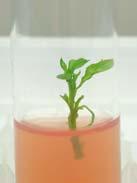
found for phytoplasma concentration, especially in the susceptible genotypes. In contrast to the susceptible genotypes, the resistant ones did not show apple proliferation-specific symptoms or growth reduction compared to healthy controls. These results
were confirmed after transferring infected and healthy in vitro plants ex vitro. Thus, the in vitro system is an interesting new tool to study differences in virulence of phytoplasma strains and susceptibility or resistance of the host plant.

Transmission of Candidatus Phytoplasma mali by root bridges under natural and experimental conditions
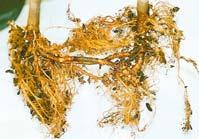
Luisa Mattedi, Anna Maria Ciccotti, Pierluigi Bianchedi, Paola Bragagna, Marco Deromedi, Mauro Filippi, Flavia Forno, Federico Pedrazzoli
For the first time, it has been possible to demonstrate experimental transmission of Candidatus Phytoplasma mali by root bridges in a trial conducted under insectproof conditions using 30 groups of two apple seedlings potted together. In 2003, one seedling of each group was inoculated by grafting with Ca. P. mali. Four years after inoculation, 7 out of a remaining 24 healthy test plants (29%) showed typical apple proliferation (AP) symptoms and were tested positive for Ca. P. mali by specific PCR. In all cases, root bridges between inoculum plant and receptor plant were detected. Natural transmission by root bridges was studied in a 10 year old apple orchard by treating cut, AP-infected trees with the herbicide glyphosate in autumn 2005. In spring 2006, neighbouring trees showed not only herbicide symptoms, indicating root bridges, but also typical AP symptoms, indicating phytoplasma transmission. Ca. P. mali was detected by specific PCR in 57% of trees with herbicide symptoms.
76 Annual Report IASMA Research Centre 2007 In brief PART 2 | DEPARTMENTS | PLANT PROTECTION DEPARTMENT
Characterisation of induced systemic resistance to downy mildew in grapevine
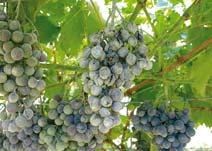 Michele Perazzolli, Chiara Pellegrini, Claudio Moser, Ilaria Pertot
Michele Perazzolli, Chiara Pellegrini, Claudio Moser, Ilaria Pertot
Plants possess various defence mechanisms to protect themselves against pathogens. Selected strains of non-pathogenic micro-organisms are able to reduce disease through activation of a plant defence mechanism known as induced systemic resistance (ISR).
The ISR extends in whole plant a disease protection against numerous pathogens. Several microorganisms and chemical inducers have been examined in various plant-pathogen systems. However, the cellular mechanisms of ISR activation have not

yet been identified and limited information is available on ISR in grapevine.
The activation of systemic resistance to downy mildew disease in grapevine by treatment with the non-pathogenic fungus Trichoderma harzianum T39 is demonstrated in this study. The main objective is the molecular characterisation of the mechanisms involved in grapevine ISR using transcriptomic and proteomic approaches.
Are phytophagous insects using volatile cues as an indicator for resource quality?
Marco Tasin, Carmela Sicher, Ilaria Pertot
Knowledge of the ecological role of volatile metabolites released by the host-plant and used by insects to locate a suitable oviposition site forms the basis of the development of innovative methods for safe control of economically relevant pests. In locating the oviposition site (grape) the grapevine moth (Lobesia botrana) is sensitive to the interaction of a combination of oviposition stimuli between the host-plant and the resident microflora. A pathogen of the berries (Botrytis cinerea) acts as a repellent for the insects while some grape-born yeasts either act as an attractant, are neutral or are repellent. We hypothesised that the insect uses the odour produced by the grape and its microflora as a reliable signal of food resource quality for the offspring.

A field unit for automatic monitoring of insect behaviour
Federica Trona
Our aim is to develop a field unit for automatically recording and analysing insects’ close-range approach to an attractive source. Until now, the behavioural mechanisms involved in semiochemical-based methods, such as mating disruption, are merely conjecture due to the difficulty of designing experiments which unequivocally show the operative mechanisms. The monitoring system will contribute to the study of these mechanisms and so improve insect control technologies based on pheromones and kairomones. We chose as study models the Exosect Auto-Confusion system, an alternative to mating disruption, currently in the developmental stage, and the codling moth, Cydia pomonella (L.), the worldwide key pest of pome fruit orchards. This project is being carried out in collaboration with the Institute of Agricultural Engineering of the University of Milan.
77 Annual Report IASMA Research Centre 2007
Facilities and Equipment
The department shares its new laboratories with the SafeCrop Centre. Equipment includes current versions of instruments necessary for:
▪ Genetic analysis of plants and micro-organisms.
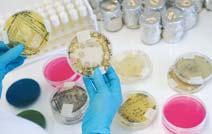
▪ Olfactory reaction analysis of living insects and antennas.
▪ Efficacy trials of plant protection agents in the laboratory and in small and large field plots.
▪ Climatic data collection at the plot level.
▪ Pest and disease diagnostics.
▪ Micro-propagation of plants.
TECAN Freedom EVO® workstation
A TECAN Freedom EVO® workstation (automated multi-channel pipeting robot) supplemented by a versatile vacuum system for automate filtration processes allows for the processing of 96-well plate from cell lyses, soil extraction or any other sample material to DNA elution in less than 3 hours. DNA samples are further processed automatically with various reagents until specific amplification in real-time PCR-cyclers and sequenced or
fragment length determined in a AB3130XL genetic analyser. Other detection tools, such as the electrophoretic apparatus, are also available.
High throughput mechanical extraction equipment and appropriate centrifuges complete the range of facilities.
Wind tunnel with flight section
The department has a custom-designed wind tunnel with a flight section of 63 x 90 x 200 cm equipped with activated charcoal filters, and a volatilisation system for test compounds consisting of a glass capillary with an elongated tip. The tip vibrates at ultrasonic frequency (about 100 kHz) by means of a piezo-ceramic disc and a motor-driven syringe. This ensures constant delivery of the solution for testing the reaction of insects to olfactory stimuli. Antennography (EAG) joined to an electroantennal detector EAD-GC allows the reaction of single antennas to specific volatile metabolites to be recorded with real-time identification of the substance in question.
The equipment is complemented by an instrument for single sensillum recording and single-cell recording with similar characteristics.
Field equipment
Field equipment includes:
▪ Motorised sprayers, from single knapsack to multi-tank airblast sprayers, ranging in size from self-driving to tractor-pulled, which allow experimental products to be applied on variously sized plots on IASMA farms. A tractor-carried tunnel spray system is employed specifically to avoid drift in row grown grapes. A laboratory and greenhouses with the requisite infection towers, sprayers and safety equipment, are available.
▪ A large number of micro-climate sensors and field data entry sta-
tions for collecting climate data at field level. The stations are interlinked with a remote communication system.
▪ Microscopes of the most advanced generation are available for classical diagnostics. The diagnostic lab also contains the equipment required for ELISA DAPI, which is also used for genetic analysis.
▪ New climatic chambers and appropriate sterile benches are available for producing plant stocks under IASMA’s trademarked SMA® label. The chambers maintain sanitised lines used in meristem culture of progeny genotypes used in breeding programmes for Apple Proliferation resistance and for new rootstock genotypes.
78 Annual Report IASMA Research Centre 2007
PART 2 | DEPARTMENTS | PLANT PROTECTION DEPARTMENT
TheCentre for the Study of Biodiversity in Trentino (CSBT) is a joint project of the Istituto Agrario of San Michele all’Adige (IASMA) and the Max Planck Institute for Plant Breeding Research of Cologne (MPIZ, Germany). The aim of the project is to carry out a long-term study of the various degrees of biological diversity in plants in order to understand the mechanisms which generate and maintain diversity in natural environments. To this end, the natural environment of Trentino has been selected as an “outdoor laboratory”, as it provides a wealth of wild plant species, habitats and eco-systems.
Despite the steady increase in the anthropical impact on natural environments in Europe during the last two centuries, alpine regions have up to now undergone more limited changes than those seen in densely populated areas in the rest of Europe. For this reason, as well as for its inherent richness of species, the Alps represent a unique opportunity for the study of biodiversity in Europe.
CENTRE FOR THE STUDY OF BIODIVERSITY IN TRENTINO
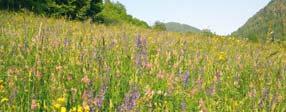 Heinz Saedler
Heinz Saedler

Modern descriptors of biodiversity
Traditionally, biodiversity has been described through surrogates, the most common of them being species richness. Despite its usefulness, this description on its own remains superficial. We are, therefore, trying to integrate traditional descriptors with more modern genetic and molecular approaches. In doing so, our analyses range from populations to species and eco-systems, using approaches that include phylogeny, ecology, population genetics, and molecular biology.
At the population level, CSBT is focusing on species the life history traits of which (annuality, limited seed dispersal, large populations, variable selfing/ outcrossing rates, etc.) are good indicators of intraspecific patterns of biodiversity. Moreover, the choice of close congeneric species within selected genera of Lamiaceae and Brassiceae has the added benefit of permitting comparison between the intraspecific and the interspecific patterns of genetic diversity as a function of different ecological determinants such as the species’ reproductive
systems and altitudinal preferences.
This baseline data can be used for modelling purposes in order to correlate environmental stresses, such as human impact or climate change, with genetic variability in natural plant populations. We are also working on identifying mutations in reproductive traits (corolla pigmentation) in natural populations, characterising them at both the ecological and the genetic levels, and identifying the mutated genes. These studies will help us understand how phenotypic variability in traits relevant for reproduction is generated and maintained in natural populations. Because corolla pigmentation is necessary for plants to attract pollinators, we have also used it as a case study for uncovering the relationship between phenotypic and genetic variability in the mutant populations.
79 Annual Report IASMA Research Centre 2007 PART 2 | SPECIALTY CENTRES | CENTRE FOR THE STUDY OF BIODIVERSITY IN TRENTINO
New technologies and methods
At the interspecific level, CSBT activity focuses on both the development of technologies and their application for comparative purposes. We have developed two kinds of tools. The first are universal molecular markers. Because they are universal, the same markers can be used on a wide array of plant species to determine the true phylogeny of the species used, or they can function as neutral reference markers when comparing genes with an adaptive value. The second types of tool are methods for amplifying orthologous sequences from many species, i.e. genomic sequences having the same functions and which originated in the ancestral species before the evolution of the derived species. Concerning the molecular markers, we have been able show that Conserved Ortholog Sets of genes (COS genes) are a valid support for phylogenetic reconstruction of closely related genes. We are currently evaluating their potential for phylogeographic and population genetic studies (see accompanying article on the subject). Concerning the isolation of orthologous sequences, we have successfully exploited microsyntenic relationships to improve the speed and efficiency of orthologs from species belonging to the same family.
Once we had defined the phylogenetic relationships within closely related species, a comparative analysis of selected adaptive traits could be carried out. To this end, we compared closely related species (congeneric) differing in adaptive traits. We isolated the genes involved in cold adaptation, viral resistance and photomorphogenesis from various species and deduced evolutive constraints and differential adaptations by comparing patterns of nucleotide variability. Building on this, we used complementation in model species to complete the dissection of the molecular basis of plant adaptation to different habitats, such as lowlands versus high-altitude alpine regions or open field versus nemoral habitats.
Applications
Ultimately, the aim of the work being carried out is to discover the molecular determinants of interspecific biologic diversity and, in light of this information, to understand how such adaptations are generated at the intraspecific level within the populations that constitute a single species. This knowledge will be applied to informed management and conservation of biodiversity, which is being increasingly recognised as an important national asset and moral responsibility.
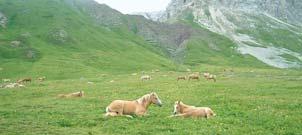
Instruments and technological platforms
We perform field data collection using hand-held tablet PCs that are specially designed to operate in environmental conditions not normally suitable for computers. The screen is designed to be readable in full sunlight; the computer casing is moisture- and water-proof; weight is reduced to a minimum to allow ease of transportation in the field; the
use of a touch-screen and standard OCR software allows the user to hand-write notes that are automatically acquired as text files and to quickly select options from pre-compiled lists. In this way data are recorded directly in digital format without the need of transcription. The computers are equipped with GIS software for direct acquisition of georeferentiated data through external GPS systems.
Facilities and instruments for high throughput DNA extraction, amplification and sequencing and for fingerprinting are shared with the Genetics and Molecular Biology department. Highly standardised, quantitative and semi-automatic scoring of AFLP fingerprinting is carried out by means of the AFLP-quantar software. Additional software developed in-house allows for automation of the repetitive tasks associated with sequence validation, reformatting and screening for homology in comparison with public databases.
80 Annual Report IASMA Research Centre 2007
PART 2 | SPECIALTY CENTRES | CENTRE FOR THE STUDY OF
IN TRENTINO
BIODIVERSITY
Introduction
Understanding how genes can determine the functioning of an organism, also known as the “genotypeto-phenotype problem” (Benfey and Mitchell-Olds, 2008, Science 320:495-7), is one of the most fundamental questions in modern biology. When applied to wild populations, it is the key to understanding how natural selection shapes organisms to enable them to adapt to their environment and ultimately evolve into new species.

Despite the importance of these issues, in the passage from the controlled experimental conditions used for model species to the uncertainties associated with natural populations, formidable hurdles
Results
Claudio Varotto
loom between the trait in question and identification of its molecular basis.
In an attempt to uncover the determinants of phenotypic variation in plant species, we screened for natural variation in corolla pigmentation of Melampyrum, a genus with a broad spectrum of life history traits and ecological ranges. By means of a candidate gene approach based on information from model organisms, we identified the mutations responsible for decreased carotenoid content in the petals of several Melampyrum sylvaticum populations. This allowed us to quantify the strength of natural selection exerted by pollinators on reproductive traits in wild plant species.
Phenotypic variation in reproductive traits in natural plant populations

Our samplings showed that phenotypic variation in corolla pigmentation in M. sylvaticum is higher than that in congeneric species (M. italicum and M. velebiticum). A total of nine M. sylvaticum populations displaying variations in the amount of carotenoids in their petals were found.
Through HPLC analyses two phenotypes, characterised by the nearly complete absence of (white mutation) or by 80% reduction in (intermediate mutation) corolla carotenoids, were identified. The increase in β-carotene observed in the intermediate mutant indicated that the β-hydroxylation step may be affected (Fig. 1). While intermediate mutants were not distinguishable from
Wild Type (WT) individuals based on morphometric analyses, white mutants significantly differed from WT by having the first bract and corolla tube reduced in size. Measurements of reproductive success indicated that while white mutants showed only slight or no decrease in reproductive fitness, intermediate mutants displayed about 40% decrease in seed production compared with WT. Measurement of selfing rates in M. sylvaticum and its close congeneric relatives, M. italicum and M. velebiticum, indicated that the increased variation of corolla pigmentation correlates with the higher selfing rates observed in M. sylvaticum Degenerate primers were used to isolate full-length cDNAs corresponding to 16 M. sylvaticum
81 Annual Report IASMA Research Centre 2007 PART 2 | SPECIALTY CENTRES | CENTRE FOR THE STUDY OF BIODIVERSITY IN TRENTINO
petal-specific carotenoid biosynthetic genes. A bulk segregant analysis was used to resequence cDNA obtained from pools of petals of individuals from three selected populations. There was no obvious association between polymorphisms in the coding regions of any of the candidates and the observed phenotypes. We therefore carried out Real Time PCR (RT-PCR) analyses to determine the variation in expression levels that may be associated
to the phenotypes. While the expression level of most of the candidate genes was unaffected in all of the populations tested, some of the genes showed significant variation. In particular, the expression level of one of the two homologs of Arabidopsis beta-carotene hydroxylase genes (BOHASE1) was consistently down-regulated in intermediate mutants in each of the three populations investigated. Promoter isolation of M. syl-
vaticum BOHASE1 confirmed the presence of different promoter rearrangements which co-segregated with the phenotype of single individuals in all the populations. This proves that:
a) The intermediate phenotype is caused by the reduced expression of BOHASE1
b) The mutation has a pleiotropic effect acting on two different reproductive traits (seed production and corolla pigmentation).
Conclusion and outlook
Life history traits are of paramount importance in determining the evolutionary rates of traits associated with reproduction in different plant species. According to our results, the higher phenotypic variation in corolla pigmentation observed in M. sylvaticum compared with other Melampyrum species is probably a consequence of differences in life history traits among the individual species.
While corolla pigmentation is under selective pressure in the outcrossing species, reduced selective pressure due to efficient selfing allows greater variation in this trait in M. sylvaticum. However, phenotypic variation in flower pigmentation is still constrained by the fact that the BOHASE1 gene responsible for the mutant phenotypes is also required for normal seed setting. Pleiotropic effects, therefore, concur to modulate the variation in corolla pigmentation and increase the frequency of white as opposed to intermediate flowering mutants.
Another relevant finding from our work is the key role played by gene expression in the generation of phenotypic variation. The modular promoter architecture may constitute a versatile method for uncoupling the involvement of single genes in multiple pathways, thus providing an efficient way of selectively suppressing gene functions that are no longer under selective pressure.
The identification of naturally occurring mutations is therefore an extremely promising means of deepening our understanding of the mechanisms of natural variation generation and maintenance in plants. With continuous progress being made in genotyping and phenotyping technologies, the “genotype-to-phenotype problem” in molecular ecology is closer to being resolved.

82 Annual Report IASMA Research Centre 2007 PART 2 | SPECIALTY CENTRES | CENTRE FOR THE STUDY OF BIODIVERSITY IN TRENTINO
Weperform field data collection using hand-held tablet PCs that are specially designed to operate in environmental conditions normally not suitable for computers.
The screen is designed to be readable in full sunlight; the computer casing is moisture- and water-proof; weight is reduced to a minimum to allow ease of transportation in the field; the use of a touch-screen and standard OCR software allows the user to hand-write notes that are automatically acquired as text files and to quickly select options from pre-compiled lists. In this way data are recorded directly in digital format without the need for transcription. The
computers are equipped with GIS software for direct acquisition of georeferentiated data through external GPS systems. Facilities and instruments for high throughput DNA extraction, amplification and sequencing and for fingerprinting are shared with the Genetics and Molecular Biology department. Highly standardised, quantitative and semi-automatic scoring of AFLP fingerprinting is carried out by means of the AFLP-quantar software. Additional software developed in-house allows for automation of the repetitive tasks associated with sequence validation, reformatting and screening for homology in comparison with public databases.
Facilities and Equipment

83 Annual Report IASMA Research Centre 2007 PART 2 | SPECIALTY CENTRES | CENTRE FOR THE STUDY OF BIODIVERSITY IN TRENTINO
SAFECROP Centre for Research and Development of Crop Protection with low environmental and consumer health impact
 Cesare Gessler
Cesare Gessler

TheSafeCrop Centre originated from a project funded by the Autonomous Province of Trento to implement innovative research on plant protection with the goal of developing sustainable agricultural methods with low environmental impact and reduced use of chemicals. It is hosted by the Istituto Agrario S. Michele all’Adige (IASMA), which is also a partner in the network together with leading European institutions (see partner list, next page). The SafeCrop Centre creates synergism in knowledgebuilding and focuses on the constraints that hamper large-scale application of low-impact technologies. It is a bridge between scientific research and the public, translating research results into products, processes and
Insect Control
Sylvie
Derridj
services. SafeCrop backs innovative projects from concept to successful application on farms and its research fills knowledge gaps and fosters innovative ideas. Research activities at SafeCrop are based on joint goals and the integration of several sciences: biology, biotechnology, information technology, sociology, economics, psychology, engineering and agronomy. Its researchers are able to spend time at appropriate qualified partner institutions, thus taking advantage of all partner facilities and knowledge.
The centre promotes high-level instruction and training of young researchers in an international and collaborative research environment. SafeCrop hosts and organises meetings and congress-
es, promotes scientific workshops and technical meetings with technicians, farmers, researchers and private companies to create networking of all the participants in the agricultural production chain. The centre also provides contract research services for customers, whether private companies or public institutions.
Research
All scientific activities are project oriented and well defined in content and time scale. SafeCrop is divided into three research units: plant pathogen control, insect control and risk assessment, and molecular tools and side effects of non-chemical control methods. The centre concentrates mainly on grapevine, apple, soft fruits and horticultural crops.
The long-term objectives of this unit are to develop effective, environmentally friendly control and monitoring techniques to replace traditional insecticides by exploiting natural insect population regulatory control factors. This includes:
▪ Identification of the biological activity of insect semiochemicals, plant volatiles and metabolites involved in host-plant selection and oviposition site selection by insects.
▪ Study of the detection mechanisms used by insects to recognise pheromones and gustatory signals involved in feeding and reproductive behaviour.
▪ Identification of parasitoids and development of mass-rearing and release techniques.
▪ Development of biological products to combat insect pests.
▪ Investigation of the impact of abiotic environmental factors on the survival and performance of bioinsecticides.
▪ Integration of chemical and biological control measures commonly used in integrated pest management.
84 Annual Report IASMA Research Centre 2007 PART 2 | SPECIALTY CENTRES | SAFECROP
Pathogen Control
Yigal
Elad
The long-term objective of the unit is to reduce chemical fungicide use on crops by implementing the use of micro-organisms, their metabolites or analogues, and their integration. Specific methods include:
▪ Selection and identification of field-condition-effective biocontrol agents (BCAs).

▪ Characterisation of the BCA activity spectrum and modes of action.
▪ Production, scale-up and formulation of potential BCAs.
▪ Evaluation of activity, consistency, survival, diffusion and constraints of BCAs applied under commercial production conditions.
▪ Integration of BCAs with other environmentally friendly methods.
Risk assessment, molecular tools and the side effects of non-chemical control methods
Ilaria Pertot
The unit’s objectives are to supply molecular tools and furnish the know-how for evaluating the long-term ecological and economical impact of BCAs. In particular, the unit is seeking to describe the fate of BCAs in agricultural ecosystems and to ascertain the extent of environmental and health risks associated with their use.
The work includes:
▪ Development of markers to trace BCAs.
▪ Monitoring the spread and colonisation of BCAs to non-target sites.
▪ Understanding plant-pathogen-BCA interactions in the field and studying the influence of the environmental on BCAs.
▪ Chemical characterisation and identification at the molecular level of the modes of action of bioactive metabolites.
▪ Risk assessment of non-chemical fungicides and insecticides.
▪ Side-effect evaluation of BCAs, insect behaviour regulators and bioactive metabolites on non-target organisms and beneficials.
▪ Evaluation of the effects of BCAs on processed agricultural products.
▪ Risk evaluation of forced pathogen evolution aimed at avoidanceing of BCA-effects.
Partners
▪ Swedish University of Agricultural Sciences, Department of Crop Science, Alnarp, Sweden, www.slu.se
▪ Federal Biological Research Centre for Agriculture and Forestry, Institute for Biological Control, Darmstadt, Germany, www.bba.de
▪ Institut National de Recherche Agronomique, Unité 1272 UPMC, INRA, INA-PG Versailles Cedex, France, www.versailles.inra.fr

▪ Swiss Federal Institute of Technology Zurich, Institute of Integrative Biology: ecology, evolution and infectious diseases, Zurich, Switzerland, www.pa.ipw.agrl.ethz.ch
▪ Agricultural Research Organization, The Volcani Center, Bet Dagan, Israel, www.agri.gov.il
Integrated Studies
The activities of the centre’s three units are integrated with socio-economic evaluations, programmes for communication and dissemination to the farming community, market analyses, information technologies and computer systems applied to agriculture, statistics and ecotoxicology.
85 Annual Report IASMA Research Centre 2007
A glimpse of the future of sustainable plant protection
Ilaria Pertot Cesare Gessler

Animportant aspect of agrarian research is the ability to predict the emergence of potential pest problems in crops. The SafeCrop Centre has studied this topic with respect to the most important crops in Trentino and has explored environmentally friendly methods of controlling potential new pests. Two significant examples are presented here.
Fire blight (Erwinia amylovora) is one of the most destructive diseases of apple and pear. In several countries, for example, Austria, Germany and Switzerland, it caused serious damage in 2000 and again in 2007. Currently, Germany and Switzerland have no alternative than to allow the use of antibiotics. However, regular and costly treatments are highly questionable as appearance of the disease is sporadic and erratic. In fact, a few years usually pass with no damage, or with no or few reports of damage, then the disease may suddenly appear causing widespread economic disaster.
Given this situation, the vast area under apple cultivation in Trentino would seem to be especially vulnerable. In 2003, a few outbreaks occurred in the Province and a costly scouting system was subsequently set up by the local advisory body. One of the most effective methods of preventing the disease from spreading into a new area is to accurately monitor orchards in order to identify symptoms promptly and destroy the infected plants.
Scouting for the disease is expensive and time consuming and needs to be focussed on sites and times of the year where symptoms of the disease would most probably appear if the pathogen were present.
Disease warning systems have been widely developed to forecast the risk of outbreak and are used in regions where Fire blight is present. SafeCrop researchers have developed a model-driven decision support system (DSS), called FireFight, designed to optimise scouting for Fire blight disease symptoms in areas where the disease has not yet established itself (Fig. 1). The DSS is based on three of the most widely utilised Fire blight forecasting algorithms.
Historical weather data analysis of Trentino has revealed the Maryblight algorithm to be the most accurate for the Province; it has also shown that there is relatively little risk during bloom, which is the most susceptible stage (there are on average 1.13 risky days per year). In 2003, 2004, and 2005 risky conditions were recorded in 37, 51, and 67%
of the Province’s weather stations, respectively. However, climate change, giving rise to higher temperatures during bloom, the occurrence of secondary bloom and favourable conditions for the disease persisting later in the season, may increase the risk of infection in the future. The DSS can assist in optimising scouting during the season and if a high risk situation is predicted during bloom farmers can apply chemical controls similar to those recommended in regions where the disease is present.

86 Annual Report IASMA Research Centre 2007 PART 2 | SPECIALTY CENTRES | SAFECROP
Figure 1 - Example of graphical visualisation of risk rankings assessed with the FireFight decision support system for each weather station on a map of the Trentino region
Given that antibiotics have several negative drawbacks and that the currently available biocontrol products are insufficiently effective, SafeCrop researchers have started to explore novel approaches to the biocontrol of E. amylovora.
Instead of screening thousands of potential biocontrol bacteria, we opted for a rational approach. It is known that bacteria communicate through chemical signals, for example by homoserine-lactone (HSL), which, once it reaches a particular concentration, informs the bacteria that it is time to switch from the saprophytic to the parasitic stage. Similarly, E. amylovora uses plant nicotinic acid (NA) to increase its population size and switch to
A second problem emerging is root rot in blueberry. The highbush blueberry has a great potential for crop increase, current consumption in Europe being, in fact, only a fraction of what it is in the USA. Because of its many health-promoting properties, SafeCrop has estimated that blueberry production will increase in the future and a change to more intensive production may raise new phytopathological problems for this crop, the most likely to appear being root rot caused by Armillaria spp. At the present time the disease has appeared in a few orchards. Genetic analysis has allowed A. mellea and A. gallica to be identified as the most frequent species, while A. cepistipes and A. sinapina have occurred only occasionally. No genotypes were shared among blueberry fields, indicating that infected plant material is not the cause of disease spread. One third of the genotypes colonising trees in the immediate vicinity of infected orchards were found on infected blueberry plants. Similarly, one third of the genotypes colonising the bark spread on blueberry rows were also identified on blueberry plants. This indicates that mulching bark and infected trees surrounding the orchards are significant sources of Armillaria spp. infection in blueberry plants. Cross infections confirmed that infected bark can be a dangerous inoculum source and can promote the development of Armillaria spp. species belonging to the genus Trichoderma were the most effective biocontrol agents both in laboratory and greenhouse trials. T.atroviride SC1, identified by SafeCrop, was found to be very effective and persistent under field conditions, and is therefore a good candidate for the control of emerging root rot disease in blueberry.
Bark pre-treated with T. atroviride SC1 could be applied in the blueberry orchards either to prevent infections in new orchards or to limit the spread of the pathogen inside orchards where it is already established.
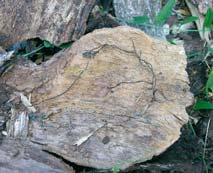
the pathogenic stage. Two strains of Pseudomonas (a common environmental bacterium) able to degrade HSL and NA were specifically selected. Under controlled conditions they were able to limit the reproduction of E. amylovora on flowers. One of these two strains is currently being tested in experimental orchards.
These experiments were possible thanks to SafeCrop’s partner BBA, which furnished the know-how for mass production, formulation and the experimental site (artificial infections with E. amylovora may only be carried out in Germany). Two tools are now available to deal with Fire blight in Trentino: a risk forecasting system and a potential biocontrol product which, with some additional research, may be an alternative to the highly controversial antibiotic (streptomycin).
87 Annual Report IASMA Research Centre 2007 PART 2 | SPECIALTY CENTRES | SAFECROP
Figure 2 – Bark used for blueberry mulching colonised by a rhizomorph of Armillaria sp.
Services and Support to Stakeholders
Our laboratories carry out basic and highly specialised analysis services, allowing IASMA to play an important role regionally, nationally, and internationally. These services support, safeguard, and develop products and processes using staff involved in research.

IASMA laboratories work to fully contextualise data, offering a deeper vision, not just a purely analytical one.
Service activities provide a means of staying in contact with fundamental issues, leading to ideas for new research and to choices in research direction. Services covering a range of agrifood fields are available to institutions and private companies.
Chemical, biochemical, and microbiological analyses
The Agrifood Quality department and its units carry out chemical, biochemical, and microbiological analyses. The most common analyses are in oenology (grapes, must, wine, grappa, and distillates).
Other common matrices are fruit (especially apples and berries), leaves, and soil. The most relevant equipment for these studies are the high resolution gas chromatograph mass spectrometer (HRGC-MS), the isotopic mass spectrometer, the nuclear magnetic resonance (NMR), the Fourier transform infrared spectrometer (FT-IR), as well as several high performance liquid chromatograph (HPLC), a high performance liquid mass chromatograph spectrometer (HPLC-MS) and inductive coupled plasma (ICP-OES/MS).
Characterisations of specific territories
The Agricultural Resources department handles studies aimed to the botanical and zoological characterisation of alpine pastures and the economic analysis of mountain farming, particularly for cost analysis of milk production.
88 Annual Report IASMA Research Centre 2007 PART 2 | ANALYTIC SERVICES
GMO detection
The Genetics and Molecular Biology department performs analysis based on the real-time PCR for detecting genetically modified organisms (GMO) in food and feed.
Phytosanitary analyses
The Plant Protection department provides phytosanitary analyses including: plant-disease diagnostic services, sanitation of plant materials, and test facilities. These analyses are possible thanks to laboratories and equipment for analysis of phytoplasm, virus, bacteria, arthropods, and
fungus carried out in greenhouses or in the field.
The department also has the equipment for studying agropharmaceuticals in the laboratory, greenhouse or field. The SafeCrop Center has greenhouses facilities and equipment for evaluating the efficacy of biocontrol agents and low environmental impact compounds.
Accreditation
The Research Centre has had SINAL accreditation since 1998.
The accreditation scheme was set up by the European Union to permit the free movement of goods and products between member states, following mutually recognised controls.
Italy’s accreditation authority, SINAL (Sistema nazionale per l’accreditamento dei laboratori), established in April 1988, assesses and exercises continuing surveillance over accredited laboratories to ensure that they comply with the standards of UNI CEI EN ISO/ IEC 17025 “General Requirements for the Competence of Testing and Calibration Laboratories” and with SINAL’s regulations. It therefore provides test users with a guarantee of the laboratories’ competence and impartiality in carrying out accredited tests.
The Research Centre has 39 accredited tests in progress in three departments (37 in the Department of AgriFood Quality; 1 in the Department of Genetics and Molecular Biology; 1 in the Department of Agricultural Resources). Of these tests, 25 are norm-based and 14 were developed internally.
An updated list of Accredited Laboratories and their accredited tests is available at www.sinal.it.

The co-ordinator of IASMA Quality Systems is Anita Dalla Serra, +39.0461.615346, anita.dallaserra@iasma.it

89 Annual Report IASMA Research Centre 2007 PART 2 | ANALYTIC SERVICES
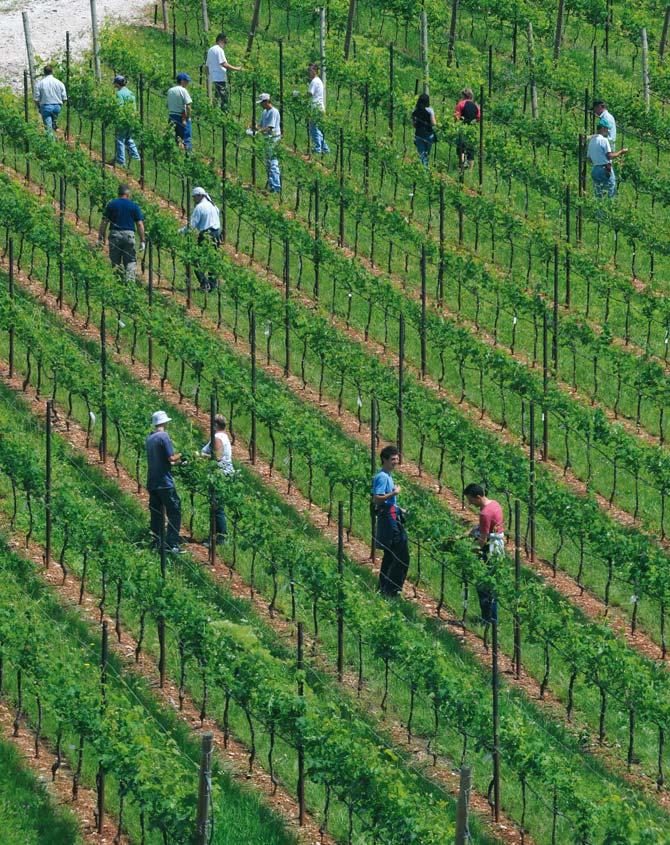
Activities
The Autonomous Province of Trento (PAT) supports the following core projects
PROJECT
Agrometereology, climatology and aerobiology
Apple genome sequencing
Biomass and renewable Energy
Food processing and technology
Food safety and traceability
Forest ecology and physiology
Genomics and bioinformatics of grape berry development
Grape crop physiology and management
Grape pest management
Innovative tree husbandry and fruit production methods
Integrated plant protection and biocontrol approaches
Limnology and fish research
COORDINATOR
Giambattista Toller
Nico Salmaso
Research Projects
DEPARTMENT
Natural Resources
Riccardo Velasco Genetics and Molecular Biology
Silvia Silvestri
Nico Salmaso
Natural Resources
Agostino Cavazza Agrifood Quality
Fulvio Mattivi
Roberto Larcher Agrifood Quality
Fulvio Mattivi
Nicola La Porta
Nico Salmaso
Natural Resources
Claudio Moser Genetics and Molecular Biology
Riccardo Velasco
Roberto Zorer
Marco Stefanini
Claudio Ioriatti
Agricultural Resources
Plant Protection
Alberto Dorigoni Agricultural Resources
Marco Stefanini
Claudio Ioriatti
Nico Salmaso
Plant Protection
Natural Resources
Umberto Malossini Agricultural Resources and selection
Management of grape germplasm banks, genetic improvement
Molecular breeding of grape
Mountain farming systems
Marco Stefanini
M. Stella Grando Genetics and Molecular Biology
Riccardo Velasco
Giorgio De Ros Agricultural Resources
Marco Stefanini
Livio Fadanelli Agricultural Resources and processing
New technologies for fruit and vegetable storage
Oenology
Plant gene expression
Quality, health and nutrition
Soft fruits protection strategies
Translational plant genomics

Other projects
The following projects are supported by various sources
PROJECT
Traceability of ovine meat
ABTM
Database of balsamic vinegars
Marco Stefanini
Giorgio Nicolini Agrifood Quality
Fulvio Mattivi
Lucia Martinelli Genetics and Molecular Biology
Riccardo Velasco
Flavia Gasperi Agrifood Quality
Fulvio Mattivi
Claudio Ioriatti Plant Protection
Silvio Salvi Genetics and Molecular Biology
Riccardo Velasco
FUNDING
COORDINATOR
Italy, Ministry for Research Federica Camin and Higher Education, MIUR-FIRS
Italy, Region Emilia Romagna Fulvio Mattivi
91 Annual Report IASMA Research Centre 2007 PART 3 | OVERVIEW | RESEARCH PROJECTS
ACCRETE
PROJECT
Agriculture and Climate Changes: how to Reduce Human Effects and Threats
FUNDING
COORDINATOR
European Union Giambattista Toller
European Union Giorgio De Ros Alpine network for sheep and goat promotion for a sustainable
ALPINET GHEEP
ArAquae
Study of Irrigation needs of crops in Trentino
ASSAGRARIA RIVA
Effect of terroir on the quality of Merlot wines
AVirVENT-STSM
Identification of avirulence/virulence genes of Venturia inaequalis
BIOMARKERS
Autonomous Province of Trento Giambattista Toller
Italy, Agraria Association Giorgio Nicolini
European Union Ilaria Pertot
Italy, Ministry for Agriculture Federica Camin
New markers for tracing organic fruits and Forestry Policies
BIOSTABILIZATION OF SOLID WASTE

Monitoring of the MBT of solid waste before landfill disposal
Blaim
Immobilized lactic bacteria
CANZOLINO
Limnological research for restoration of Lake Canzolino
CARITRO
Molecular modelling of polyphenols biosynthetic pathways and its application in gene discovery and gene modulation in living cells for pharmacogenomics purposes
CARPESCI
Autonomous Province of Trento Silvia Silvestri
Denmark, Danstar ferment Agostino Cavazza
Autonomous Province of Trento Monica Tolotti
Italy, CARITRO Foundation Riccardo Velasco
Italy, Ministry for Agriculture Francesca Ciutti
Harvesting, genetic characterisation, farming, and distribution and Forestry Policies of native salmonid fish of the alpine lakes of Italy
CARPOL
Development of innovative methods for identifying and quantifying allergenic pollens
Italy, CARITRO Foundation Elena Gottardini
Italy, Castellani company Roberto Larcher R&D convention
Castellani
CAVIT
Chemistry, technology and microbiology in winemaking
COLLI di PARMA
Improvement of the quality of Malvasia & Sauvignon Blanc DOC Wines
COST 858
Viticulture: biotic and abiotic stress, grapevine defence mechanism and grape development
COST 864
Pome fruit health
DEMARCATE
Development of molecular taxonomic markers for the psillids of agronomic interest
DOW
Laboratory and field studies on the efficacy of autoconfusion technique against Cydia pomonella
ECOCYPRE
Ecological assessment and sustainable management of cypress in the landscape of Trentino
Italy, Cavit group Giorgio Nicolini
Italy, Colli di Parma Consortium Giorgio Nicolini
European Union Stella Grando
European Union Ilaria Pertot
Autonomous Province of Trento Valeria Malagnini
Italy, DOW company Gino Angeli
Autonomous Province of Trento Nicola La Porta
92 Annual Report IASMA Research Centre 2007 PART 3 | OVERVIEW | RESEARCH PROJECTS
EcoGenEtic.Com
PROJECT
Eco- friendly genes: from scientific research to risk management, ethical issues and communication
ECOPLAN

Ecology and biogreography of two planktonic taxa in small lakes of Trentino
FUNDING
COORDINATOR
Autonomous Province of Trento Lucia Martinelli
Autonomous Province of Trento Giovanna Flaim
ENDURE European Union Ilaria Pertot
European Network for the Durable Exploitation of Crop Protection Strategies
Ever Italy, Ever company Agostino Cavazza R&D convention
FLAVONOIDI
Study of the genetic determinants of the flavonoid content in the grape berry: integration of gene expression and metabolic data
Autonomous Province of Trento Claudio Moser
Food Quality Italy, Ministry for Agricultural Fulvio Mattivi
The role of red wine and its minor components in and forest policy the prevention of chronic degenerative diseases
GAME Italy, Authority of Basin Andrea Gandolfi
Sustainable management of marble trout (S. t. marmoratus) of river Adige in the Adige basin: genetic, phenotypical and ecological characterisation for conservation purposes
GARDA Italy, Veneto Agency for the Nico Salmaso
Long term development of the physical, chemical and prevention and protection biological characteristics of Lake Garda of the environment
GeReCa Autonomous Province of Trento Marco Stefanini
Subtle characterisation of the Vitis genetic resources in the IASMA collection
GRANA PADANO
Isotope and elemental characterisation of Grana Padano cheese and relevant data bank
Italy, Grana Padano Consortium Federica Camin
GRAPEGEN06 European Union Stella Grando
Management and conservation of genetic resources
HiDRAS European Union Matteo Komjanc
High-quality disease resistant apples for sustainable agriculture
ICQ-MIPAAF Italy, Ministry for Agricultural Federica Camin
Research and investigations to upgrade the national isotopic and forest policy data bank of food and beverages
Interberry
Interdisciplinary integrated study for the improvement of the quality of berries and for the design of new products with high added value
IRRI WEB
Development of telecontrol systems for irrigation, fertilization and climatization plants in Trentino
Autonomous Province of Trento Lara Giongo
Autonomous Province of Trento Giambattista Toller
ISAGRO Italy, ISAGRO Company Gino Angeli Disorientation of vine moths
Kerry Ireland, Kerry Bioscience Giorgio Nicolini R&D convention
MESVIT
Basic and applied research for the control of grapevine esca disease
Italy, ARSIA Toscana Ilaria Pertot
93 Annual Report IASMA Research Centre 2007 PART 3 | OVERVIEW | RESEARCH PROJECTS
MIGLIORFILETTO
PROJECT
Integrated research on the improvement of Trentino commercial fishery production in terms of yield of the proceeded products of the species Oncorhyncus mykiss (Rainbow trout)
O3-NTO
Ozone in Trentino: levels and effects on vegetation
Parallelomics
FUNDING
COORDINATOR
Autonomous Province of Trento Fernando Lunelli
Autonomous Province of Trento Elena Gottardini
Italy, Ministry for Research Riccardo Velasco
Metabolomic and genomic high parallel profiling of typical and Higher Education agri-food products
PARMA
Edible, aromatic and medicinal plants of the Alps: a resource to value
PARMIPS
Autonomous Province of Trento Matteo Komjanc
Italy, Regional Park of Cedra Cristina Salvadori
Assessment of the ecological impact of the Ips typographus and Parma valleys attacks
PECC
PostDoc project PECC – Genetic and molecular analyses of Norway spruce (Picea abies Karst.): adaptative variabilità and species evolution under global change conditions
Autonomous Province of Trento Nicola La Porta
Italy, CARITRO Foundation Nicola La Porta Study on genetic expression of the forest pathosystem Picea abies/Armillaria abies/Armillaria
PICEA-ARMILLARIA
PLANADIGE
Italy, Authority of Basin Nico Salmaso
The river plankton as a tool to investigate the ecological of river Adige quality and the management of waters of the river Adige
PROALPE
Italy, Ministry for Research Luana Bontempo
Investigation of alpine terroirs for the characterisation and Higher Education, MIUR-FIRS and protection of mountain dairy products
Profiles
Analysis of genetic expression profiles during Vitis Vinifera berry ripening process by means of DNA matrixes
QTL_A
QTL characterisation of aroma in grapevine
Autonomous Province of Trento Riccardo Velasco
Autonomous Province of Trento Stella Grando
Italy, Quargentan company Roberto Larcher R&D convention
Quargentan
RAME
Italy, Ministry of agriculture Ilaria Pertot
Studies to comply with limits on copper residue with and forestry low-dosage formulations or alternatives

Ruffino
Italy, Ruffino company Giorgio Nicolini R&D convention
SA wine data bank
South Africa, ARC Stellenbosch Federica Camin Isotopes Database of southafrican wines and distilled drinks
SAMPLEVITIS
Molecular approaches for clonal characterization in grapevine
SicilBerry
Project for the improvement of the quality of berries and development of their nutritional and antioxidant potential
SICILIA_GEN
Gene-based traceability of the grape production chain in Sicily
Autonomous Province of Trento Claudio Moser
Italy, Sicilian Region Lara Giongo
Italy, Sicilian Region Stella Grando
94 Annual Report IASMA Research Centre 2007 PART 3 | OVERVIEW | RESEARCH PROJECTS
PROJECT
FUNDING
COORDINATOR
Sipcam Italy, SIPCAM company Gino Angeli
Decadienoato (DA) for controlling damages from C. pomonella L.
SMAP II Autonomous Province of Trento Wolfgang Jarausch
Apple Proliferation
Syngenta Italy, SYNGENTA Company Gino Angeli
Integrated control of the major phytophaga and pathogens of apple and grapevine
SyrTox
Mechanism of action of Pseudomonas spp. metabolites and their potentiality in biocontrol
TOBLINO-CANZOLINO
Limnological studies on Toblino and Canzolino lakes
Autonomous Province of Trento Ilaria Pertot
Autonomous Province of Trento Monica Tolotti
TRACE European Union Giorgio Nicolini
Tracing food commodities in europe
TRENTINGRANA
Quality aspects of the Grana Trentino supply chain

University of Piacenza
R&D convention
Autonomous Province of Trento Giorgio De Ros
Italy, University of Piacenza Agostino Cavazza
Italy, Veneto Agriculture Flavia Gasperi R&D convention
Veneto Agriculture
VITIS Italy, Vitis Rauscedo Scarl Fulvio Mattivi
Development and application of analytical methods in support of clonal selection
WIPS
In-process wine fermentation monitoring system: Oenological fermentation monitoring with biosensors and mathematical models
European Union Agostino Cavazza
95 Annual Report IASMA Research Centre 2007 PART 3 | OVERVIEW |
RESEARCH PROJECTS
Affiliations
SOCIETY
American Phytopathological Society (APS)
ASEV American society for enology and viticulture
Associazione Italiana Ittiologi di Acqua Dolce (AIIAD)
Centro Italiano Studi di Biologia Ambientale (CISBA)
WEBSITE PERSON
http://www.apsnet.org
http://www.asev.org
Nicola La Porta
Marco Stefanini
http://www. aiiad.it Francesca Ciutti Andrea Gandolfi
http://www.cisba.it
Francesca Ciutti Silvia Silvestri
COST Action 858, member of management committee http://www.bordeaux.inra.fr/ Stella Grando cost858/welcome.html
COST Action 858, member of management committee
http://www2.univ-poitiers.fr/cost858
Stella Grando
Fifth International Workshop on Grapevine Downy and http://www.safecrop.org Ilaria Pertot Powdery Mildew, member of the scientific committee member
Groupe Polyphenols, GP board member
http://www.groupepolyphenols.com/ Fulvio Mattivi
Integrate Pest Management Europe, Italian delegate and http://www.ipmeurope.org/ Nicola La Porta steering committee member
International Association for Plant Biotechnology (IAPB) http://www.IAPB-STL.org
Lucia Martinelli (http://www.ibba.cnr.it/APTCCB)
Stella Grando steering committee Riccardo Velasco
International Grape Genome Program-IGGP, member of http://www.vitaceae.org
International Society for Diatom Research (ISDR) http://www.isdr.org
Cristina Cappelletti
IOBC wprs Subgroup “Pome fruit arthropods”, convenors http://www.iobc-wprs.org/people/ Claudio Ioriatti index.html
Italian Association for Oceanology and Limnology (AIOL) http://www.aiol.info/home.htm
Nico Salmaso member of the board of directors and components
Giovanna Flaim
Monica Tolotti
Italian Biotechnologists Association (ANBI) http://www.biotecnologi.org/public/ Lorenza Dalla Costa portale/html/index.php
Italian Professional Order of Biologists, (Provincial Delegate) http://www.onb.it/
Italian Society for Agricultural Genetics (SIGA) http://www.siga.unina.it

Lucia Martinelli
Stella Grando
Matteo Komjanc
Lucia Martinelli
Claudio Moser
Riccardo Velasco
Italian Society for Horticulture
http://www.soihs.it
Stella Grando
Duilio Porro
Marco Stefanini
Flavia Gasperi council member
Italian Society for Sensory Science, founding member and http://www.scienzesensoriali.it
Italian Society for Plant Physiology
http://www.sifv.it Riccardo Velasco
Long Term Ecological Research, coordinator of LTER-Italy http://www.ilternet.edu/networks/ Cristina Salvadori scientific committee
Marie Curie Fellows Association
Società Italiana di Biologia Evoluzionistica (SIBE)
Società Italiana di Patologia Vegetale
Società Italiana di Selvicoltura e Ecologia Forestale (SISEF)
Societas Internationalis Limnologiae (SIL)
http://mcfa.eu/ Nicola La Porta
http://www.sibe-iseb.it/ Andrea Gandolfi
http://www.agr.unipi.it/sipav/ Giorgio Maresi
http://www.sisef.it Nicola La Porta
http://www.limnology.org
Giorgio Maresi
Giovanna Flaim
Monica Tolotti
Society for the study and development of alpine zootechnical
http://www.sozooalp.it
Walter Ventura systems (SoZooAlp)
96 Annual Report IASMA Research Centre 2007
PART 3 | OVERVIEW | AFFILIATIONS
JOURNAL
Journal of Food, Agriculture & Environment (JFAE)
Journal of Limnology
Mitteilungen Klosterneuburg
Phytopathology Informer


Rivista di Viticoltura ed Enologia
South African Journal of Oenology and Viticulture
Tree Genetics and Genomes
Vite, vino e qualità
VITIS – Journal of Grapevine research
VQ - In vite qualitas, in vino excellentia
WEBSITE PERSON
http://www.isfae.org/ Lucia Martinelli scientificjournal.php
http://www.iii.to.cnr.it/ Nico Salmaso
http://bundesamt.weinobstkloster Fulvio Mattivi neuburg.at/seiten/index.php/ Urska Vrhovsek view.84/service.true/
http://www.edagricole.it/r_22_dett.asp
Cesare Gessler
http://www.inea.it/isv/ Fulvio Mattivi RivistaViticEnol.htm
http://www.sasev.org/journal
http://www.springer.org
Lucia Martinelli
Fulvio Mattivi
Giorgio Nicolini
Riccardo Velasco
http://www.rivistedigitali.com/ Stella Grando Vite_Vino_e_Qualita/ Riccardo Velasco
http://www.bafz.de
Fulvio Mattivi
Fulvio Mattivi
Lucia Martinelli
http://www.tecnichenuove.com/ Fulvio Mattivi epages/Store.sf/?ObjectPath=/Shops/ TN/Products/VQ/SubProducts/VQ-0001
Editorial Board Participation Recognition
PRIZE
Asev best enology paper award
Award 2007
Honorary Reseach Lecture 2007
Recognition for the constant activity in the field of aerobiology
INSTITUTION
PERSON
American Society of Enology and Lorenza Conterno Viticulture
Italian Society for Agricultural
Laura Costantini Genetics SIGA
American Society of Enology and Riccardo Velasco Viticulture
Italian Association of Aerobiology
Elena Gottardini
Fabiana Cristofolini
97 Annual Report IASMA Research Centre 2007
PART 3 | OVERVIEW | EDITORIAL BOARD PARTICIPATION / RECOGNITION
PART 3 | OVERVIEW | ACADEMIC THESES AT IASMA IN 2007
Academic
Theses at IASMA in 2007
Doctoral theses
Bisognin Claudia Hohenheim
Cainelli Christian Verona
Dalla Costa Lorenza Torino
Lisjak Klemen Lubiana
Longa Claudia Maria Oliveira Pavia
Madini Alberto Padova
Malacarne Giulia Verona
Marin Floriana Trento
Obertegger Ulrike Innsbruck
Five-year theses
PERSON UNIVERSITY
Dalsant Susanna Verona
Longhi Sara Verona
Pisetta Michele Padova
Three-year theses
PERSON UNIVERSITY
Agosti Giacomo Padova
Beozzo Marco Udine
Bergamo Daniele Udine
Butterini Alberto Udine
Butterini Nicola Udine
Carli Erwin Udine-Trento-Iasma Consortium
Devigili Francesca Udine-Trento-Iasma Consortium
Galimberti Emil Alberto Udine-Trento-Iasma Consortium
Misseroni Andrea Verona
Murru Gianpiero Udine
Nessler Andrea Padova
Prandi Andrea Udine
Ress Daniele Udine
Sandri Claudio Udine
Sora Ramon Milano
Tamanini Federica Udine-Trento-Iasma Consortium
Villegas Tomas Roman Udine-Trento-Iasma Consortium
Zendri Lorenzo Udine
Genetics and Molecular Biology Stella Grando
Genetics and Molecular Biology Stella Grando
Genetics and Molecular Biology Lucia Martinelli
Agrifood Quality Urska Vrhovsek
Plant Protection Ilaria Pertot
Genetics and Molecular Biology Stella Grando
Genetics and Molecular Biology Claudio Moser
Riccardo Velasco
Genetics and Molecular Biology Lucia Martinelli
Natural Resources Giovanna Flaim
Genetics and Molecular Biology Claudio Moser
Genetics and Molecular Biology Stella Grando
Natural Resources Giorgio Maresi
Natural Resources Lucia Salvadori
Plant Protection Ilaria Pertot
Plant Protection Claudio Ioriatti
Plant Protection Ilaria Pertot
Plant Protection Ilaria Pertot
Agrifood Quality Fulvio Mattivi Elisa Poznanski

Genetics and Molecular Biology Stella Grando
Agrifood Quality Giorgio Nicolini
Flavia Gasperi
Natural Resources Nicola La Porta
Plant Protection Ilaria Pertot
Genetics and Molecular Biology Claudio Moser
Michele Perazzolli
Plant Protection Ilaria Pertot
Plant Protection Daniele Prodorutti
Plant Protection Claudio Ioriatti
Natural Resources Nicola La Porta
Agrifood Quality Fulvio Mattivi
Agrifood Quality Giorgio Nicolini
Roberto Larcher
Plant Protection Ilaria Pertot
98 Annual Report IASMA Research Centre 2007
IASMA DEPARTMENT IASMA
PERSON UNIVERSITY
ADVISOR
IASMA DEPARTMENT IASMA
ADVISOR
IASMA
DEPARTMENT IASMA ADVISOR
The results of research activities carried out at IASMA are published in scientific papers and presented at conferences and lectures for experts as well as for the general public. Below is a selection of the centre’s major research papers published in the international press (J) and in various proceedings (P). Given the international audience of this book, we have omitted publications in Italian.
Anfora G., Tasin M., Bäckman A.-C., De Cristofaro A., Lucchi A., Ioriatti C. (2007). Electrophysiological and behavioural responses of Eupoecilia ambiguella (Hübner) (Lepidoptera tortricidae) females to volatiles from grapevine. In: Biological and integrated control in a modern viticulture: Marsala, 25-27 October, 2007. (IOBC/WPRS bulletin): 1 p. (P)
Anfora G., Isidoro N., Ioriatti C. (2007). Biological interactions between the apple leaf curling midge, Dasineura mali (Kieffer), and its inquiline, Macrolabis mali Anfora. IOBC wprs Bulletin 30 (4). 69-73. (P)
Anfora G., Baldessari M., Maines R., Trona F., Reggiori F., Angeli G. (2007). Control of Cydia pomonella L. and Cydia molesta (Busck) (Lepidoptera Tortricidae) in pome-fruit orchards with Ecodian sex pheromone dispensers. Communications in Agricultural and Applied Biological Sciences 72 (3): 535-542. (J)
Anfora G., Baldessari M., Maines R., Trona F., Reggiori F., Angeli G. (2007). Control of Cydia pomonella L. and Cydia molesta (Busck) (Lepidoptera Tortricidae) in pome-fruit orchards with Ecodian sex pheromone dispensers. Proceeding of the International Symposium on Crop Protection , Ghent, 20-22 maggio 2007, 71/2, 2007. (P)
Angeli D., Maines L., Di Marino E., Mescalchin E., Pertot I. (2007). Natural occurrence of ampelomyces spp. as E. necator mycoparasite in the vineyards of Trentino province (Northern Italy) and efficacy evaluation of A. quisqualis in integrated powdery mildew management. In: Biological and integrated control in a modern viticulture: Marsala, 25-27 October, 2007. (IOBC/WPRS bulletin): 1 p. (P)
Angeli D., Maines L., Sicher C., Murru G., Butterini N., Abou Assaf H., Mamoci E., Longa C., Elad Y., Simeone V., Pertot I. (2007). Efficacy of microorganisms and nonchemical products against grapevine powdery mildew. In: Biological and integrated control in a modern viticulture: Marsala, 25-27 October, 2007. (IOBC/WPRS bulletin): 1 p. (P)

Angeli G., Anfora G., Baldessari M., Germinara G.S., Rama F., De Cristofaro A., Ioriatti C. (2007). Mating disruption of codling moth Cydia pomonella with high densities of Ecodian sex pheromone dispensers. Journal of applied entomology, 131, (5): 311-318. (J)
Angeli G., Rizzi C., Dorigoni A., Ioriatti C. (2006). Population injury levels of the apple rust mite Aculus schlechetndali (Nalepa) on Golden delicious apple fruits. IOBC wprs Bulletin 30 (4). 255-260 (P)
Aprea E., Biasioli F., Carlin S., Versini G., Märk T.D., Gasperi F. (2007). Rapid white truffle headspace analysis by proton transfer reaction mass spectrometry and comparison with solid-phase microextraction coupled with gas chromatography/mass spectrometry. Rapid communications in mass spectrometry, 21, (16): 2564-2572. (J)
Aprea E., Biasioli F., Gasperi F., Mott D., Marini F., Märk T.D. (2007). Assessment of Trentingrana cheese ageing by proton transfer reaction-mass spectrometry and chemometrics. International dairy journal, 17, (3): 226-234. (J)
Aprea E., Biasioli F., Märk T.D., Gasperi F. (2007). PTR-MS study of esters in water and water/ethanol solutions: fragmentation patterns and partition coefficients. International journal of mass spectrometry, 262, (1/2): 114-121. (J)
Aprea E., Carlin S., Versini G., Märk T. D., Gasperi F. (2007). Assessing truffle origin by PTR-MS fingerprinting and comparison with GC-MS for the headspace analysis. In: 3rd International Conference on proton transfer reaction mass spectrometry: Obergurgl, Austria, January 27-February 01 (2007) (editors A. Hansel, T.D. Märk). Innsbruck: University press. (Conference series): 132-135. ISBN: 3902571039 (P)
Arraiol A., Aguin-Pombo D., Franquinho Aguiar A. M., Freitas E., Angeli G. (2007). Evaluation of commercial pheromones lures for monitoring Cydia splendana males (Lepidoptera: Tortricidae) in chestnut of Madeira Island. Proc. II Congresso Iberico do Castanheiro 250-253 (P).
Avilla J., Cross J., Ioriatti C. (edited by) (2007). International workshop on Arthropod pest problems in pome fruit production: proceedings of the meeting at Lleida (Spain) 4-6 September, 2006. IOBC. WPRS (IOBC/WPRS bulletin 30 (4)/2007): xii, 279 p. ISBN 92-9067-199-6. (J)
Baldessari M., Maines R., Angeli G. (2007). Comparison of two methods for the agrochemical side effect evaluation on Amblyseius Andersoni (Chant) (Acari, phytoseiidae) in vineyards. In: Biological and integrated control in a modern viticulture: Marsala, 25-27 October, 2007. (IOBC/WPRS bulletin): 1 p. (P)
Baldessari M., Trona F., Angeli G. (2007). Evaluation of different insecticides and strategies against cacopsylla melanoneura (Förster) (Homoptera: Psyllidae), a vector of Apple proliferation phytoplasma. Proceeding of the International Symposium on Crop Protection, Ghent, 20-22 maggio 2007, 71/2, 2007 (P)
99 Annual Report IASMA Research Centre 2007 PART 3 | OVERVIEW | PUBLICATIONS 2007
Publications 2007
Baraldi F., Gandolfi A. (2007). Salmo trutta marmoratus in the Adige river basin: a genetic, phenotypic and ecological study aimed at its conservation. In: Sefs-5: symposium for European freshwater sciences: Palermo, July 8-13: 174. (P)
Bavaresco L., Pezzuto S., Gatto M., Mattivi F. (2007). Role of the variety and some environmental factors on grape stilbenes. Vitis, 46, (2): 57-61. (J)
Beltrami M. E., Cappelletti C., Ciutti F. (2007). A first characterization of diatoms communities from Trentino streams (Northern Italy). In: 1st Central European Diatom Meeting (1st CE-DiatoM)=21. Treffen der deutschsprachigen Diatomologen mit internationaler Beteiligung: Berlin, 23-25 March 2007 (editors W.H. Kusber, R. Jahn). Berlin: Freie Universität Berlin: 7-10.
ISBN: 978-3-921800-63-8. (P)
Beltrami M. E., Cappelletti C., Ciutti F., Ector L., Lippmann G. (2007). Didymosphenia geminata (Lyngbye) M. Schmidt occurrence and bloom observation in Trentino rivers (northern Italy). In: 30th Congress of the International Association of theoretical and applied limnology: Montréal, Québec, Canada, August 12-18, 2007: 1 p. (P)
Beltrami M. E., Cappelletti C., Ciutti F., Hoffmann L., Ector L. (2007). Distribution et développement massif de Didymosphenia geminata (Lyngbye) M. Schmidt dans la province de Trento (Nord de l’Italie). In: 26éme Colloque de l’Asociation des diatomistes de langue française: La dispersion des espčces dans un environnement changeant: effets sur les communautés de diatomées: Aveiro, Portugal, 5-8 septembre 2007. Aveiro: 20. (P)
Beltrami M. E., Ciutti F., Cappelletti C., Rott E. (2007). Epilithic diatoms assemblages of a large river in northern Italy (Adige river). In: 30th Congress of the International Association of theoretical and applied limnology: Montréal, Québec, Canada, August 12-18, 2007: 1 p. (P)
Beltrami M. E., Ector L., Ciutti F., Cappelletti C., Hoffmann L., Rott E. (2007). Assemblages des diatomées benthiques du fleuve Adige (Nord de l’Italie). In: 26éme Colloque de l’Asociation des diatomistes de langue française: La dispersion des espèces dans un environnement changeant: effets sur les communautés de diatomées: Aveiro, Portugal, 5-8 septembre 2007. Aveiro: 22. (P)
Bertamini M., Zulini L., Muthuchelian K., Nedunchezhian N. (2007). Low night temperature effects on photosynthetic performance on two grapevine genotypes. Biologia plantarum, 51, (2): 381-385. (J)

Bertamini M., Zulini L., Zorer R., Muthuchelian K., Nedunchezhian N. (2007). Photoinhibition of photosynthesis in water deficit leaves of grapevine (Vitis vinifera L.) plants. Photosynthetica, 45, (3): 426-432. (J)
Biasioli F. (2007). PTR-MS in food science and technology: a review. In: 3rd International Conference on proton transfer reaction mass spectrometry: Obergurgl, Austria, January 27-February 01 (2007) (editors A. Hansel, T.D. Märk). Innsbruck: University press. (Conference series): 110-115. ISBN: 3902571039 (P)
Bisognin C., Ciccotti A.M., Salvadori A., Moser M., Grando M.S., Jarausch W. (2007). Effect of different strains of Candidatus phytoplasma mali in susceptible and resistant Malus genotypes inculated by in vitro grafting. Bulletin of insectology, 60, (2): 205-206. (J)
Bonadei M., Balestrazzi A., Giorcelli A., Mattivi F., Carbonera D. (2007). Evaluation of the expression level of the endogenous marker poUBI gene for studies on transgene stability in bar and StSy GM poplars. Caryologia, 60, (1): 172-174. (J)
Bongi G., Eccel E., Toller G. (2007). The coherence of a novel forecast module in R language for Chardonnay harvest. In: International Workshop on Advances in Grapevine and Wine Research: Venosa, September 15-17, 2005 (editors V. Nuzzo, P. Giorio, C. Giulivo). Leuven: ISHS. (Acta Horticulturae 754): 407-412. ISBN: 9789066056206 (P)
Bontempo L., Perini M., Schlicht C., Kelly S. D., Ueckermann H., Hoogewerff J., Ye Z., Shuming Y., Rossman A. (2007). Multielement stable isotope (HCNS) and trace element characterisation of Chinese chicken. In: Traceability: perspectives from science, supply chain and the consumers: Limenas Hersonissou, Crete, 26th-27th April 2007. Athens: Agricultural University of Athens: 67 (Poster 1). (P)
Camin F., Bontempo L., Heinrich K., Horacek K., Kelly S. D., Schlicht C., Thomas F., Monahan F., Hoogewerff J., Rossman A. (2007). Multi-element (H,C,N,S) stable isotope characteristics of lamb meat from different European regions. In: Traceability: perspectives from science, supply chain and the consumers: Limenas Hersonissou, Crete, 26th-27th April 2007. Athens: Agricultural University of Athens: 92-93 (Poster 15). (P)
Camin F., Bontempo L., Heinrich K., Horacek K., Kelly S.D., Schlicht C., Thomas F., Monahan F., Hoogewerff J., Rossman A. (2007). Multi-element (H,C,N,S) stable isotope characteristics of lamb meat from different European regions. Analytical & bioanalytical chemistry, 389, (1): 309-320. (J)
Camin F., Moschella A., Miselli F., Parisi B., Versini G., Ranalli P., Bagnaresi P. (2007). Evaluation of markers for the traceability of potato tubers grown in organic vs conventional regime. Journal of the science of food and agriculture, 87, (7): 1330-1336. (J)
Camin F., Perini M., Colombari G., Versini G. (2007). Influence of diet composition on the carbon, nitrogen and oxygen stable isotope ratios of animal feed and milk. In: Simsug 2007: stable isitope mass spectrometry user group: Newcastle University, June, 20-22. Newcastle: Newcastle University: 1 p. (P)
100 Annual Report IASMA Research Centre 2007 PART 3 | OVERVIEW | PUBLICATIONS 2007
Camin F., Perini M., Versini G., Bontempo L., Schlicht C., Thomas F. (2007). Multi-element stable isotope (HCO) characterisation of olive oils. In: Traceability: perspectives from science, supply chain and the consumers: Limenas Hersonissou, Crete, 26th-27th April 2007. Athens: Agricultural University of Athens: 68-69 (Poster 2). (P)
Camin F., Versini G., Simoni M., Tonon A., Ziller L. (2007). The influence of grape varieties, altitude and cultivation practices on the H, C and O stable isotope ratios of wine. In: 3rd Internationa workshop on alcoholic beverages authentication: IWABA 2007: Stresa, 14-16 November 2007 (edited by J. Ryder, C. Guillou): 8-9. (P)
Canali R., Ambra R., Stelitano C., Mattivi F., Scaccini Cristina, Virgili F. (2007). A novel model to study the biological effects of red wine at the molecular level. British journal of nutrition, 97, (6): 1053-1058. (J)
Cantini C., Sani G., Biasioli F., Aprea E., Gasperi F. (2007). Proprietà organolettiche di oli extravergini monovarietali prodotti con diversa velocità del frangitore meccanico. In: 20° congresso della Società italiana per lo studio delle sostanze grasse: Qualità e sicurezza degli oli d’oliva: conoscenze attuali e prospettive future: Roma, 7-8 giugno 2007 SISSG: 2 p. (P)
Cartwright D.A., Troggio M., Velasco R., Gutin A. (2007). Genetic mapping in the presence of genotyping errors. Genetics, 176, (4): 2521-2527. (J)
Ciccotti A.M., Bianchedi P., Bragagna P., Deromedi M., Filippi M., Forno F., Mattedi L. (2007). Transmission of Candidatus phytoplasma mali by root bridges under natural and experimental conditions. Bulletin of insectology, 60, (2): 387-388. (J)
Consolandi C., Palmieri L., Doveri S., Maestri E., Marmiroli N., Reale S., Lee D., Baldoni L., Tosti N., Severgnini M., De Bellis G., Castiglioni B. (2007). Olive variety identification by ligation detection reaction in a universal array format. Journal of biotechnology, 129, (3): 565-574 . (J)
Costantini L., Battilana J., Emanuelli F., Moser S., Versini G., Grando M. S. (2007). QTLS and candidate genes associated with terpene content of grape berries. In: Understanding the genetic and molecular basis of quality and production traits: from traits to genes and backwards in grapevine: Logrońo, La Rioja, May 6-8th, 2007: 17. (P)
Costantini L., Grando M.S., Feingold S., Ulanovsky S., Mejía N., Hinrichsen P., Doligez A., This P., Cabezas J.A., MartinezZapater J.M. (2007). Generation of a common set of mapping markers to assist table grape breeding. American journal of enology and viticolture, 58, (1): 102-111. (J)
Dalla Serra M., Pertot I., Fogliano V., Iacobellis N.S. (2007) SyrTox project: mechanism of action of Pseudomonas spp. metabolites and their potentiality in the biocontrol Biological control of fungal and bacterial plant pathogens, IOBC/wprs Bulletin Vol. 30 (6) 187-188 (P)
Dagostin S, Gobbin D., Palmieri L., Pertot I. (2007) High-Throughput preliminary screening of microorganisms with potential activity against Plasmopara viticola by means of quantitative Real-Time Polymerase Chain Reaction Biological control of fungal and bacterial plant pathogens, IOBC/wprs Bulletin Vol. 30 (6) 365-368 (P)
Dagostin S., Formolo T., Ferrari A., Pertot I. (2007). Replacement of copper fungicide: efficacy evaluation of new organic fungicide against downy mildew. In: Biological and integrated control in a modern viticulture: Marsala, 25-27 October, 2007 (IOBC/WPRS bulletin): 1 p. (P)
Dal Cin V., Boschetti A., Dorigoni A., Ramina A. (2007). Benzylaminopurine application on two different apple cultivars (Malus domestica) displays new and unexpected fruitlet abscission features. Annals of botany, 99, (6): 1195-1202. (J)
Dal Cin V., Danesin M., Botton A., Boschetti A., Dorigoni A., Ramina A. (2007). Fruit load and elevation affect ethylene biosynthesis and action in apple fruit (Malus domestica L. Borkh) during development, maturation and ripening. Plant cell and environment, 30, (11): 1480-1485. (J)
Dalla Costa L., Martinelli L. (2007). Development of a Real-Time PCR method based on duplo target plasmids for determining an unexpected genetically modified soybean intermix with feed components. Journal of agricultural and food chemistry, 55, (4): 1264-1273. (J)
D’Ambrosio M., Eggher P., Guerriero A., Komjanc M., Zini E. (2007). Exploring chemical differences in five subpopulations of Hieracium pilosella L. by HPLC-ESI-MS/MS and comparison with genetic variability. Planta medica, 73, (12): 910 (P279). (J)
De Cristofaro A., Anfora G., Germinara G.S., Ioriatti C., Vitagliano S., Guida M., Rotundo G. (2007). Olfactory sensitivity of different populations of Cydia pomonella (L.) to sex pheromone E8E10-12:OH and kairomone ethyl (2E, 4Z)-2,4-decadienoate.
IOBC wprs Bulletin 30 (4): 125. (P)
De Cristofaro A., Vitagliano S., Anfora G., Germinara G. S., Tasin M., Lucchi A., Ioriatti C., Rotundo G. (2007). Olfactory cells responding to the main pheromone component and plant volatiles in Lobesia botrana (Den. & Schiff.): possible effects on monitoring systems. In: Biological and integrated control in a modern viticulture: Marsala, 25-27 October, 2007. (IOBC/WPRS bulletin: 1 p. (P)
Duso C., Fanti M., Pozzebon A., Angeli G. (2007). Is the predatory mite Kampimodromus aberrans a candidate for the control of phytophagous mites in European apple orchards? (J)

101 Annual Report IASMA Research Centre 2007 PART 3 | OVERVIEW | PUBLICATIONS 2007
Eccel E., Ghielmi L., Granitto P.M., Barbiero R., Grazzini F., Cesari D. (2007). Prediction of minimum temperatures in an Alpine region by linear and non-linear post-processing of meteorological models. Nonlinear processes in geophysics, 14, (3): 211-222. (J)
Endrizzi I., Gasperi F., Biasioli F., Pirretti G., Calò D. (2007). Consumer liking for juices based on berry fruit. In: 7th Pangborn sensory science symposium: Minneapolis, MN, 12-16 August 2007. Oxford: Elsevier: PC1.31. (P)
Engel K.H., Baudler R., Adam L., Rossman A., Versini G., Christoph N., Bauer-Christoph C. (2007). Assignment of the regional origin of cherry brandies by stable isotope analysis. In: Authentication of food and wine (editors S.E. Ebeler, G.R. Takeoka, P. Winterhalter). Washington, DC: American chemical society. (ACS symposium series 952): 254-272. (J)
Fedrizzi B., Magno F., Badocco D., Nicolini G., Versini G. (2007). Aging effects and grape variety dependence on the content of sulfur volatiles in wine. Journal of agricultural and food chemistry, 55, (26): 10880 – 10887. (J)
Fedrizzi B., Magno F., Moser S., Nicolini G., Versini G. (2007). Concurrent quantification of light and heavy sulphur volatiles in wine by headspace solid-phase microextraction coupled with gas chromatography/mass spectrometry. Rapid communications in mass spectrometry, 21, (5): 704-714. (J)
Fedrizzi B., Versini G., Lavagnini I., Nicolini G., Magno F. (2007). GC-MS determination of 3-mercaptohexan-1-ol and 3-mercaptohexyl acetate in wine. Analytica chimica acta, 596, (2): 291-297. (J)
Ferrarini R., Bocca E., Cavazza A. (2007). Mechanical dispersion procedures improve the rehydration of active dry yeast. Enzyme and microbial technology, 40, (5): 1251-1255. (J)
Ferrari A, Sicher C, Prodorutti D, Pertot I. (2007) Potential new applications of Shemer, a Metschnikowia fructicola based product, in post-harvest soft fruit rots control Biological control of fungal and bacterial plant pathogens, IOBC/wprs Bulletin Vol. 30 (6) 43-46 (P)
Fiamingo F, Pellegrini E., Angeli D, Lo Cantore P., Iacobellis N.S., Pertot I. (2007) First report of biocontrol activity of Pseudomonas reactans, pathogen of cultivated mushrooms, against strawberry powdery mildew in greenhouse trials Biological control of fungal and bacterial plant pathogens, IOBC/wprs Bulletin Vol. 30 (6) 33-36 (P)
Gessler C., Patocchi A. (2007). Recombinant DNA technology in apple. Advances in biochemical engineering / biotechnology, 107: 113-132. (J)

Gessler C., Pertot I., Jermini M. (2007). Black rot and downy mildew control strategies: a decision support system for small non-professional vineyard growers. In: Biological and integrated control in a modern viticulture: Marsala, 25-27 October, 2007. (IOBC/WPRS bulletin): 1 p. (P)
Gianfranceschi L., Dunemann F., Evans K., Gessler C., Guerra W., Komjanc M., Lateur M., Laurens F., Kellerhals M., Ryder C., Sansavini S., Tomala K., Van De Weg E., Zurawicz E. (2007). HiDRAS: an integrated european project adopting a pedigree based approach to investigate apple fruit quality traits. In: EUCARPIA: XII fruit section symposium: Zaragoza, September 16-20, 2007: 51-52. (P)
Gobbin D., Bleyer G., Keil S., Kassemeyer H.H., Gessler C. (2007). Evidence for sporangial dispersal leading to a single infection event and a sudden high incidence of grapevine downy mildew. Plant pathology, 56, (5): 843-847. (J)
Gobbin D., Hohl L., Conza L., Jermini M., Gessler C., Conedera M. (2007). Microsatellite-based characterization of the Castanea sativa cultivar heritage of Southern Switzerland. Genome, 50, (12): 1089-1103. (J)
Gobbin D., Jermini M., Loskill B., Pertot I., Raynal M., Gessler C. (2007). Contaminations primaires: un rôle sous-estimé. In: EUROVITI: 16éme Colloque viticole et oenologique: Montpellier, 28-29 novembre 2007. Rodilhan: Institut Français de la Vigne et du Vin: 107-111. (P)
Grando M. S., Moscatello S., Madini A., Leccese A., Stefanini M., Battistelli A. (2007). Evaluation of non-structural carbohydrate composition of wood in a mapping population of grape. In: COST action 858: Viticulture: biotic and abiotic stress. Grapevine defence mechanism and grape development: workshop Vineyard under environmental constraints. Adaptations to climate change: Lodz, Poland, October 18-20, 2007: 50. (P)
Granitto P.M., Biasioli F., Aprea E., Mott D., Furlanello C., Märk T.D., Gasperi F. (2007). Rapid and non-destructive identification of strawberry cultivars by direct PTR-MS headspace analysis and data mining techniques. Sensors and actuators B: Chemical, 121, (2): 378-385. (J)
Granitto P.M., Gasperi F., Biasioli F., Trainotti E., Furlanello C. (2007). Modern data mining tools in descriptive sensory analysis: a case study with Random forest approach. Food quality and preference, 18, (4): 681-689. (J)
Guggenberger T., De Ros G., Venerus S. (edited by) (2007). The right place: an integrated model for the suitability evaluation and potential estimation of alpine pastures for sheep and goats. Der geeignete Platz: ein integriertes Modell zur Eignungsprüfung und Potentialabschätzung alpiner Weiden für Schafe und Ziegen. Irdning: Federal Resarch and Education Centre (HBLFA) Raumberg-Gumpenstein: 186 p. ISBN 978-3902559-10-4. (J)
102 Annual Report IASMA Research Centre 2007 PART 3 | OVERVIEW | PUBLICATIONS 2007
Guzzon R., Cavazza A., Carturan G. (2007). Immobilisierung von Weinmikroorganismen in Sylice/Alginate Systeme. In: 8. Internationales Symposium Innovationen der Kellerwirtschaft: Stuttgart-Killesberg, 20.-23. April 2007: 294 (Poster n. 35). (P)
Hancock R.D., Walker P.G., Pont S.D.A., Marquis N., Vivera S., Gordon S.L., Brennan R.M., Viola R. (2007). L-Ascorbic acid accumulation in fruit of Ribes nigrum occurs by in situ biosynthesis via the L-galactose pathway. Functional plant biology, 34, (12): 1080-1091. (J)
Hansen G., Flaim G. (2007). Dinoflagellates of the Trentino province, Italy. Journal of limnology, 66, (2): 107-141. (J)
Heinrich K., Camin F., Schlicht C., Kelly S. D., Rossman A., Thomas F., Jamin E., Horacek K. (2007). Multielement (N,S) stable isotope characteristics of soil from different european regions. In: Traceability: perspectives from science, supply chain and the consumers: Limenas Hersonissou, Crete, 26th-27th April 2007. Athens: Agricultural University of Athens: 86-87 (Poster 12). (P)
Ioriatti C., Mattedi L., Mescalchin E., Varner M. (2007). 20 ańos de experiencia en la aplicación de feromonas para el control de polilla del racimo (Lobesia botrana) en vińedos del Trentino Alto Adige (Italia). In: I jornadas internacionales sobre feromonas y su uso en agricultura: Murcia, 21 y 22 de noviembre de 2006. Murcia: Consejería de agricultura y agua. (Jornadas y congresos 22): 73-79. (P)
Ioriatti C., Tasin M., Charmillot P.-J., Reyes M., Sauphanor B. (2007). Early detection of resistance to tebufenozide in field populations of Cydia pomonella L.: methods and mechanisms. Journal of applied entomology, 131, (7): 453-459. (J)
Ioriatti C., Tomasi C., Charmillot P.-J., Pasquier D., Sauphanor B., Reyes M. (2007). Susceptibility of codling moth, Cydia pomonella (L.) to tebufenozide in Trentino apple growing area: results of a regional survey. IOBC wprs Bulletin 30 (4). 31. (P
Jarausch W., Bisognin C., Schneider B., Grando M.S., Velasco R., Seemüller E. (2007). Breeding of apple rootstocks resistant to Candidatus phytoplasma mali. Bulletin of insectology, 60, (2): 299-300. (J)
Karatas H., Degirmenci D., Velasco R., Vezzulli S., Bodur C., Agaoglu S.Y. (2007). Microsatellite fingerprinting of homonymous grapevine (Vitis vinifera L.) varieties in neighboring regions of South-East Turkey. Scientia horticulturae, 114, (3): 164-169; err. corr.: v. 116 (2008), (3): 342. (J)
Kouassi A. B., Laurens F., Costa F., Tartarini S., Evans K., Fernandez F., Govan C., Boudichevskaja A., Dunemann F., Antofie A., Lateur M., Stankiewicz-Kosyl M., Soska A., Tomala K., Lewandowski M., Rutkovski K., Zueawicz E., Guerra W., Barbaro E., Mott D., Durel C. E. (2007). Estimation of genetic parameters of apple fruit quality traits using pedigreed plant material from eight european countries. In: EUCARPIA: XII fruit section symposium: Zaragoza, September 16-20, 2007: 53-54. (P)
Kremer A., Casasoli M., Berreneche T., Bodenes C., Sisco P., Kubisiak T., Scalfi M., Leonardi S., Bakker E., Buiteveld J., RomeroSeverson J., Arumuganathan K., Derory J., Scotti-Saintagne C., Roussel G., Bertocchi M.E., Lexer C., Porth I., Hebard F., Clark C., Carlson J., Plomion C., Koelewijn H.-P., Villani F. (2007). Fagaceae trees. In: Forest trees (editor C. Kole). Berlin (etc.): Springer. (Genome mapping and molecular breeding in plants 7): 161-188. (J)

Larcher R., Nicolini G., Bertoldi D. (2007). Application of differential pH technique to the determination of urea in Italian wines. Vitis, 46, (3): 148-153. (J)
Larcher R., Nicolini G., Puecher C., Bertoldi D., Moser S., Favaro G. (2007). Determination of volatile phenols in wine using high-performance liquid chromatography with a coulometric array detector. Analytica chimica acta, 582, (1): 55-60. (J)
Leister D., Varotto C. (2007). GST-PRIME: an algorithm or genome-wide primer design. In: Methods in molecular biology Totowa, NJ: Humana Press. 402: 141-158. (J)
Lombarkia N., Ioriatti C., Bourguet E., Derridj S. (2007). Effect of Madex® (granulovirus) on Cydia pomonella (L.) egg laying on two apple varieties: relationships with plant surface metabolites. IOBC wprs Bulletin 30 (4). 23 (P)
Magaraggia M., Faccenda F., Paterno F., Gandolfi A., Jori G. (2007). Treatment of microbiologically polluted aquaculture waters by a novel photochemical technique of potentially low environmental impact. In: ESP 2007: 12th congress European Society for Photobiology: programme and book of abstracts: Bath, England, 1st-6th September 2007. Bath: 84 (IL233). (P)
Malacarne G., Zulini L., Vrhovsek U., Cestaro A., Stefanini M., Mattivi F., Delledonne M., Velasco R. (2007). Metabolic and transcriptional changes in resistant and susceptible genotypes of a grapevine population segregating for the resistance to Plasmopara viticola. In: XII International congress on molecular plant-microbe interactions: Sorrento, 21-27 July, 2007: 250 (PS 10-464). (P)
Malagnini V., Pedrazzoli F., Forno F., Komjanc M., Ioriatti C. (2007). Characterization of microsatellite loci in Cacopsylla melanoneura Förster (Homoptera: Psyllidae). Molecular ecology notes, 7, (3): 495–497. (J)
Marin F., Martinelli L. (2007) EcoGenEtic.Com: an integrated research experience to translate social and scientific priorities into strategic guidelines for the management of agro-biotechnologies at human scale. III Living Knowledge Conference, Paris, Aug. 30 – Sept. 1, 2007 (P)
Maresi G., Luchi N., Pinzani P., Pazzagli M., Capretti P. (2007). Detection of Diplodia pinea in asymptomatic pine shoots and its relation to the normalized insolation index. Forest pathology, 37, (4): 272-280. (J)
103 Annual Report IASMA Research Centre 2007 PART 3 | OVERVIEW | PUBLICATIONS 2007
Martinelli L., Dalla Costa L., Vaccari I., Poletti V., Musio A., Marin, F., Autiero A. (2007) Marker Gene Removal in Grapes: an Integrated Approach. International Conference on Plant Transformation Technologies, Vienna Austria, 4-7 febbr. 2007 (P Martinelli L., Marin F. (2007) An holistic approach to face the plant gene transfer technique: from laboratory to society. Wonbit Conference: Women on Biotechnology, Scientific and Feminist approaches, Rome, Italy, June 21-23/ 2007 http://www.wonbit. net/readingroom/ (P)
Martinelli L, Dalla Costa L, Vaccari I, Poletti V (2007) Gene transfer in grapes: an overview. COST Meeting on Establishing Biological Function in Grapevine, Logrono, Spain, May 6-9, 2007 (P)
Martinelli L., Marin F. (2007) Hazard perception of exogenous gene transfer to plants in lay citizens, stakeholders and public community: analysis and communication practices. VI Latin America and the Caribbean Meetings on Agricultural Biotechnology (REDBIO) ( 22 -26 Oct. 2007, Viña del Mar, Chile ) (P)
Mattedi L., Forno F., Cainelli C., Grando M. S., Jarausch W. (2007). Transmission of Candidatus phytoplasma mali by psyllid vectors in Trentino. IOBC wprs Bulletin 30 (4). 31 (P)
Mazzoni V., Anfora G., Lucchi A., Ioriatti C. (2007). Olfactory responses of Scaphoideus titanus ball (Hemiptera cicadellidae) nymphs to grapevine volatiles. In: Biological and integrated control in a modern viticulture: Marsala, 25-27 October, 2007. (IOBC/WPRS bulletin): 1 p. (P)
Mazzoni V., Virant Doberlet M., Lucchi A. (2007). Daily “chores” of Scaphoideus titanus ball (Hemiptera cicadellidae). In: Biological and integrated control in a modern viticulture: Marsala, 25-27 October, 2007. (IOBC/WPRS bulletin): 1 p. (P)
Michelon L., Pellegrini C., Pertot I. (2007). Incidence and development of esca disease in Trentino (Northern Italy). In: Biological and integrated control in a modern viticulture: Marsala, 25-27 October, 2007. (IOBC/WPRS bulletin): 1 p. (P)
Migeon A., Malagnini V., Navajas M., Duso C. (2007). Notes on the genus Eotetranychus (Acari: Tetranychidae) in Italy and France with a redescription of Eotetranychus fraxini Reck, new record for Italy and Western Europe. Zootaxa, 1509: 51-60. (J)
Moreira F. M., Costantini L., Battilana J., Emanuelli F., Madini A., Grando M. S. (2007). Progressi nell’identificazione di associazioni rilevanti tra genotipo molecolare e fenotipo in vite. In: XXXth OIV world congress: Budapest, 10-16 June 2007: 6 p. (P)
Moser M., Sprenger C., Bisognin C., Velasco R., Jarausch W. (2007). Gene expression study in different Ca. phytoplasma maliinfected micropropagated Malus genotypes. Bulletin of insectology, 60, (2): 207-208. (J)
Musetti R., Polizotto R., Vecchione A., Borselli S., Zulini L., D’Ambrosio M., Sanitŕ di Toppi L., Pertot I. (2007). Antifungal activity of diketopiperazines extracted from Alternaria alternata against Plasmopara viticola: an ultrastructural study. Micron, 38, (6): 643-650. (J)
Negrini R., Colli L., Gandolfi A., Chegdani F., Milanesi E., Pellecchia M., Nonnis Marzano F., Grando M. S., Ajmone Marsan P. (2007). Post-glacial history of Arctic charr (Salvelinus alpinus) populations inferred by AFLP neutral markers and mtDNA analysis. In: Population genetics for animal conservation II: international workshop: programme, abstracts and addresses: Monte Bondone, Trento, Italy, September 6-8, 2007: 70. (P)
Nicolini G., Larcher R., Bertoldi D., Puecher C., Magno F. (2007). Rapid quantification of 4-ethylphenol in wine using highperformance liquid chromatography with a fluorimetric detector. Vitis, 46, (4): 202-206. (J)
Nicolini G., Larcher R., Camin F., Bontempo L., Perini M., Bertoldi D., Persano Oddo L., Versini G. (2007). Influence of botanical origin of Italian honeys on the mineral and stable isotope composition. In: Traceability: perspectives from science, supply chain and the consumers: Limenas Hersonissou, Crete, 26th-27th April 2007. Athens: Agricultural University of Athens: 130-131 (Poster 13). (P)
Obertegger U., Flaim G., Braioni M.G., Sommaruga R., Corradini F., Borsato A. (2007). Water residence time as a driving force of zooplankton structure and succession. Aquatic sciences, 69, (4): 575-583. (J)
Obertegger, U., Flaim, G. Borsato, A. (2007). Influence of water residence time on zooplankton depth distribution in a pseudokarstic alpine lake. XXV IAH Congress (International Association of Hydrogeologists) - Lisbon, Portugal - September 17-21, 2007 - Abstract Book (P).
Obertegger, U., Thaler, B., and Flaim, G. (2007). Habitat constraints of Synchaeta (Rotifera) in North Italian lakes (TrentinoSouth Tyrol). Verh. Int. Ver. Limnol 30, (2):302-306.
Obertegger, U., Thaler, B., and Flaim, G. (2007). Presence of the genus Synchaeta Ehrenberg, 1832 (Rotifera: Monogononta: Synchaetidae) in lakes of South-Tyrol
Gredleriana 7: 141 - 154
Patocchi A., Fernandez F., Evans K., Silfverberg-Dilworth E., Matasci C. L., Gobbin D., Rezzonico F., Boudichevskaja A., Dunemann F., Stankiewicz-Kosyl M., Matisse F., Soglio V., Gianfranceschi L., Durel C. E., Toller C., Cova V., Mott D., Komjanc M., Barbaro E., Costa F., Voorrips R., Yamamoto T., Gessler C., Van De Weg E. (2007). Development of a set of apple SSRS markers spanning the apple genome, genotyping of HiDRAS plant material and validation of genotypic data. In: EUCARPIA: XII fruit section symposium: Zaragoza, September 16-20, 2007: 55-56. (P)

104 Annual Report IASMA Research Centre 2007 PART 3 | OVERVIEW | PUBLICATIONS 2007
Pedrazzoli F., Gualandri V., Forno F., Mattedi L., Malagnini V., Salvadori A., Stoppa G., Ioriatti C. (2007). Acquisition capacities of the overwintering adults of the psyllid vectors of Candidatus phytoplasma mali. Bulletin of insectology, 60, (2): 195-196. (J Pellegrini E., Sicher C., Fiore A., Fogliano V., Pertot I. (2007) Efficacy of Pseudomonas syringae lipodepsipeptides in inhibiting Botrytis cinerea on strawberry fruits Biological control of fungal and bacterial plant pathogens, IOBC/wprs Bulletin Vol. 30 (6)195-198 (P)
Perazzolli M., Faccin S., Ciccotti A. M., Pertot I., Gessler C., Moser C. (2007). Characterization of the grape roots defence reaction against the fungal pathogen Armillaria mellea. In: XIII International congress on molecular plant-microbe interactions: Sorrento, July 21-27, 2007: 351 (PS 14-774). (P)
Perazzolli M., Faccin S., Ciccotti A. M., Pertot I., Gessler C., Moser C. (2007). Upregulation of PR-genes in grape during the infection of the fungal pathogen Armillaria mellea. In: Joint International Workshop on PR-proteins and induced resistance agains pathogens and insects: Doorn, The Nederlands, May 10-14, 2007: 60 (Poster 20). (P)
Perini D., Cova V., Keller-Przybylkowicz S., Stankiewicz-Kosyl M., Soglio V., Komjanc M., Gianfranceschi L. (2007 ). Development and mapping of functional molecular markers for fruit quality traits in Malus x domestica (Borkh.). In: EUCARPIA: XII fruit section symposium: Zaragoza, September 16-20, 2007: 179. (P)
Perini M., Camin F., Bontempo L., Larcher R., Bertoldi D., Nicolini G. (2007). Multi-parametric measurement by IRMS and ICP-MS for the traceability of the italian PDO olive oils. In: 3rd Intrernational symposium on Recent advances in food analysis: Prague, November 7-9, 2007: 325 (H-5). ISBN: 978-88-7080-659-3 (P)

Perini M., Camin F., Corradini F., Flaim G. (2007). Application of č180 in the interpreattion of hydrological dynamics in Alpine lakes. In: Earth: our changing planet: Proceedings of IUGG XXIV general assembly: Perugia, July 2-13, 2007 (compiled by L. Ubertini, P. Manciola, S. Casadei). Perugia: HW1001 Oral presentation 4421. (P)
Persano Oddo L., Camin F., Nicolini G., Larcher R., Bontempo L., Versini G. (2007). Application of mineral elements and stable isotopes analyses to identify geographical and botanical origin of italian honeys. In: 40th Apimondia international apicultural congress: Melbourne, September 9th-14th, 2007: 171-172 (N. 285). (P)
Pertot I., Dagostin S., Gobbin D. (2007) Mechanism of action against Plasmopara viticola of the grapevine endophytic strain of the fungus Alternaria alternata Biological control of fungal and bacterial plant pathogens, IOBC/wprs Bulletin Vol. 30 (6)189-194 (P)
Pertot I., De Luca F. (2007). Effect of Glomus mosseae BEG12, Trichoderma viride TV1 and T. harzianum T39 on plant growth of healthy and Armillaria mellea inoculated strawberry plants under greenhouse controlled conditions. In: Multitrophic interactions in soil: IOBC Workshop: program abstracts: Dijon, France, Sunday June 24th-Wednesday June 27th, 2007: 33. (P)
Pertot I., Fiamingo F., Amsalem L., Maymon M., Freeman S., Gobbin D., Elad Y. (2007). Sensitivity of two Podosphaera aphanis populations to disease control agents. Journal of plant pathology, 89, (1): 85-96. (J)
Pertot I., Fiamingo F., Elad Y. (2007). Integrating alternative control agents with chemical fungicides in strawberry powdery mildew control strategies. In: 15th International Reinhardbrunn symposium: Modern fungicides and antifungal compounds: Friedrichroda, Germany, May 6-10, 2007: abstract. (P)
Pilati S., Perazzolli M., Malossini A., Cestaro A., Demattč L., Fontana P., Dal Rí A., Viola R., Velasco R., Moser C. (2007). Genome-wide transcriptional analysis of grapevine berry ripening reveals a set of genes similary modulated during three seasons and the occurrence of an oxidative burst at veraison. BMC Genomics, 8, (428) http://dx.doi. org/10.1186/1471-2164-8-428. (J)
Pindo M., Troggio M., Cartwright D., Gutin A., Velasco R. (2007). SnplexTm genotyping system to develop a dense SNP-based genetic linkage map of grapevine (Vitis Vinifera L.). In: Plant & animal genome XV conference: San Diego, CA, January 13-17, 2007: P74 (poster). URL: http://www.intl-pag.org/15/abstracts/PAG15_P02c_74.html (P)
Poggi Pollini C., Bianchi L., Forno F., Franchini S., Giunchedi L., Gobber M., Mattedi L., Miorelli P., Pignatta D., Profaizer D., Ratti C., Reggiani N. (2007). Investigation on European stone fruit yellows in experimental apricot orchards in the province of Trento (Italy). Bulletin of insectology, 60, (2): 323-324. (J)
Policarpo M., Tomasi D., Porro D., Zorer R., Stefanini M. (2007). A rapid process to replace a variety in grapevine. In: International Workshop on Advances in Grapevine and Wine Research: Venosa, September 15-17, 2005 (editors V. Nuzzo, P. Giorio , C. Giulivo). Leuven: ISHS. (Acta Horticulturae 754): 413-420. ISBN: 9789066056206 (P)
Policarpo M., Zorer R., Porro D., Zatelli A., Bertamini M., Stefanini M. (2007). Grapevine accessions management in the IASMA collection. In: XV International symposium GESCO 2007: Porec, 20-23.06-2007. Porec: Institut za poljoprivredu i turizam. 2: 1207-1213. ISBN: 9537296008. (P)
Porro D., Dorigatti C., Zatelli A., Ramponi M., Stefanini M., Policarpo M. (2007). Partitioning of dry matter in grapevine during a season: estimation of nutrient requirements. In: XV International symposium GESCO 2007: Porec, 20-23.06-2007. Porec: Institut za poljoprivredu i turizam. 1: 403-411. ISBN: 9537296008. (P)
105 Annual Report IASMA Research Centre 2007 PART 3 | OVERVIEW | PUBLICATIONS 2007
Prodorutti D., Ferrari A., Pellegrini A., Pertot I. (2007). Efficacy of Metschnikowia fructicola (Shemer®) against post-harvest soft fruit rots in Northern Italy (Trentino). In: 6th Workshop on integrated soft fruit production: East Malling Research, Kent, 24-27 September 2007: 25. (P)
Prodorutti D., Pellegrini A., Simon S., Gafni Y., Kuflik T., Frizzi A., Pertot I. (2007). Coptimizer: a decision support system to reduct copper in organic viticulture: programme and abstract. In: Biological and intregrated control in a modern viticulture: Marsala, October 25-27, 2007: 1 p. (P)
Prodorutti D., Pellegrini A., Simon S., Gafni Y., Kuflik T., Frizzi A., Pertot I. (2007). Coptimizer: a decision support system to reduct copper in organic viticulture. In: Biological and integrated control in a modern viticulture: Marsala, 25-27 October, 2007. (IOBC/WPRS bulletin): 1 p. (P)
Prodorutti D., Pertot I., Giongo L., Gessler C. (2007). Highbush blueberry: cultivation, protection, breeding and biotechnology The European journal of plant science and biotechnology, 1, (1): 44-56. (J)
Reyes M., Franck P., Charmillot P.-J., Ioriatti C., Olivares J., Pasqualini E., Sauphanor B. (2007). Diversity of insecticide resistance mechanisms and spectrum in European populations of the codling moth, Cydia pomonella Pest management science, 63, (9): 890-902. (J)
Rezzonico F., Duffy B. (2007). The role of luxS in the fire blight pathogen Erwinia amylovora is limited to metabolism and does not involve quorum sensing. Molecular plant-microbe interactions, 20, (10): 1284-1297. (J)
Rimet F., Goma J., Cambra J., Bertuzzi E., Cantonati M., Cappelletti C., Ciutti F., Cordonier A., Coste M., Delmas F., Tison J. , Tudesque L., Vidal H., Ector L. (2007). Benthic diatoms in Western European streams with altitudes above 800 m: characterisation of the main assemblages and correspondence with ecoregions. Diatom research, 22, (1): 147-188. (J)
Rossetto M., Vanzani P., Lunelli M., Scarpa M., Mattivi F., Rigo A. (2007). Peroxyl radical trapping activity of anthocyanins and generation of free radical intermediates. Free radical research, 41, (7): 854-859. (J)
Rossi V., Gandolfi A., Baraldi F., Bellavere C., Menozzi P. (2007). Phylogenetic relationships of coexisting Heterocypris (Crustacea, Ostracoda) lineages with different reproductive modes from Lampedusa Island (Italy). Molecular phylogenetics and evolution, 44, (3): 1273-1283. (J)
Rott E., Salmaso N., Höhn E. (2007). Quality control of Utermöhl-based phytoplankton counting and biovolume estimates: an easy task or a Gordian knot? Hydrobiologia, 578, (1): 141-146. (J)
Salmaso N., Braioni M.G. (2007). Factors controlling the seasonal development and distribution of the phytoplankton community in the lowland course of a large river in Northern Italy (river Adige). Aquatic ecology, http://dx.doi.org/10.1007/ s10452-007-9135-x. (J)
Salmaso N., Morabito G., Garibaldi L., Mosello R. (2007). Trophic development of the deep lakes south of the Alps: a comparative analysis. Fundamental and applied limnology = Archiv für Hydrobiologie, 170, (3): 177-196. (J)
Salmaso N., Padisak J. (2007). Morpho-functional groups and phytoplankton development in two deep lakes (Lake Garda, Italy and Lake Stechlin, Germany). Hydrobiologia, 578, (1): 97-112. (J)
Santini A., La Porta N., Ghelardini L., Mittempergher L. (2007). Adaptation trials of interspecific elm hybrids to different environment. Euphytica, http://dx.doi.org/10.1007/s10681-007-9573-5. (J)
Schmidt S., Anfora G., Ioriatti C., Germinara G.S., Rotundo G., De Cristofaro A. (2007). Biological activity of ethyl (E,Z) -2,4-decadienoate on different tortricid species: electrophysiological responses and field tests. Environmental entomology, 36, (5): 1025-1031. (J)
Schmidt S., Tomasi C., Melandri M., Pradolesi G., Pasqualini E., Ioriatti C. (2007). Use of ethyl (E,Z)-2,4-decadienoate in the control of Cydia pomonella (L.) on apple orchards. IOBC wprs Bulletin 30 (4). 21. (P)
Sivilotti P., Zulini L., Peterlunger E., Petrussi C. (2007). Sensory properties of Cabernet Sauvignon wines as affected by rootstock and season. In: International Workshop on Advances in Grapevine and Wine Research: Venosa, September 15-17, 2005 (editors V. Nuzzo, P. Giorio, C. Giulivo). Leuven: ISHS. (Acta Horticulturae 754): 443-448. ISBN: 9789066056206 (P)
Soufflet-Freslon V., Kouassi A. B., Laurens F. M. F., Gobbin D., Patocchi A., Rezzonico F., Evans K., Fernandez F., Boudichevskaja A., Dunemann F., Stankiewicz-Kosyl M., Komjanc M., Mott D., Gianfranceschi L., Van De Weg E., Bink M., Durel C. E. (2007). Pedigree-based mapping of scrab resistence QTL in apple. In: EUCARPIA: XII fruit section symposium: Zaragoza, September 16-20, 2007: 94-95. (P)
Stefanini M., Porro D., Policarpo M., Iacono F., Colugnati G., Crespan G. (2007). Employment of stability indexes to assess interaction genotype environment (G x E) in Vitis vinifera. In: International Workshop on Advances in Grapevine and Wine Research: Venosa, September 15-17, 2005 (editors V. Nuzzo, P. Giorio, C. Giulivo). Leuven: ISHS. (Acta Horticulturae 754): 85-90. ISBN: 9789066056206 (P)

106 Annual Report IASMA Research Centre 2007 PART 3 | OVERVIEW | PUBLICATIONS 2007
Tasin M., Anfora G., Bäckman A. C., Ioriatti C., Leonardelli E., De Cristofaro A., Pozzolini E., Lucchi A. (2007). Grape volatiles drive the oviposition of the vine moth females at a close range. In: Biological and integrated control in a modern viticulture: Marsala, 25-27 October, 2007. (IOBC/WPRS bulletin): 1 p. (P)
Tasin M., Bäckman A. C., Coracini M., Casado D., Ioriatti C., Witzgall P. (2007). Synergism and redundancy in a plant volatile blend attracting grapevine moth females. Phytochemistry, 68, (2): 203-209. (J)
Tasin M., Leonardelli E., Anfora G., Ioriatti C., Lucchi A., De Cristofaro A., Pertot I. (2007). An improved oviposition bioassay for the grapevine moth. In: IOBC wprs Working Group Meeting “Pheromones and Other Semiochemicals in Integrated Production”, Alnarp-Lund, Sweden, 9-14 September 2007. IOBC/WPRS Bulletin: 1 p. (P)
Tasin M., Ryne C., Veronelli V., Bäckman A. K., Ioriatti C. (2007). Effect of flat anti-hail nets on Cydia pomonella (L.) reproductive behaviour. IOBC wprs Bulletin 30 (4). 13. (P)
Thomas F., Jamin E., Camin F., Heinrich K., Horacek K., Kelly S. D., Schlicht C., Monahan F., Hoogewerff J., Rossman A. (2007). Multi-element (C,N,O,S) stable isotope characteristics of cereals from different european regions. In: Traceability: perspectives from science, supply chain and the consumers: Limenas Hersonissou, Crete, 26th-27th April 2007. Athens: Agricultural University of Athens: 75 ( Poster 6). (P)
Tolotti M., Corradini F., Boscaini A., Calliari D. (2007). Weather-driven ecology of planktonic diatoms in Lake Tovel (Trentino, Italy). Hydrobiologia, 578, (1): 147-156. (J)
Troggio M., Malacarne G., Coppola G., Segala C., Cartwright D. A., Pindo M., Stefanini M., Mank R., Moroldo M., Morgante M., Grando M.S., Velasco R. (2007). A dense single-nucleotide polymorphism-based genetic linkage map of grapevine (Vitis vinifera L.) anchoring Pinot noir bacterial artificial chromosome contigs. Genetics, 176, (4): 2637-2650. (J)
Vaccari I., Poletti V., Martinelli L. (2007). Evaluation of phosphomannose isomerase gene as alternative to antibiotic resistance for Vitis gene transfer. In vitro cellular & developmental biology: animal, 43, (Meeting Abstract Issue): S59-S60. (P)
Van De Weg E., Jansen H., Bink M., Voorrips R., Durel C. E., Laurens F., Dunemann F., Evans K., Patocchi A., Guerra W., Komjanc M., Lateur M., Kellerhals M., Ryder C., Sansavini S., Kazimierz T., Zurawicz E., Gianfranceschi L. (2007). QTL mapping in multiple, pedigreed populations: the concept and the framework of the statistical procedures. In: EUCARPIA: XII fruit section symposium: Zaragoza, September 16-20, 2007: 57-58. (P)
Vanzo A., Cecotti R., Vrhovsek U., Torres A.M., Mattivi F., Passamonti S. (2007). The fate of trans -caftaric acid administered into the rat stomach. Journal of agricultural and food chemistry, 55, (4): 1604-1611. (J)
Vecchione A., Zulini L., Pertot I., Musetti R. (2007). Biological control of Plasmopara viticola: a multisite approach. In: International Workshop on Advances in Grapevine and Wine Research: Venosa, September 15-17, 2005 (editors V. Nuzzo, P. Giorio, C. Giulivo). Leuven: ISHS. (Acta Horticulturae 754): 361-366. ISBN: 9789066056206. (P)
Vecchione A, Dagostin S., Zulini L, Pertot I. (2007) Trichoderma harzianum T39 activity against Plasmopara viticola Biological control of fungal and bacterial plant pathogens, IOBC/wprs Bulletin Vol. 30 (6) 143-146 (P)
Velasco R., Zharkikh A., Troggio M., Cartwright D.A., Cestaro A., Pruss D., Pindo M., FitzGerald L.M., Vezzulli S., Reid J., Malacarne G., Iliev D., Coppola G., Wardell B., Micheletti D., Macalma T., Facci M., Mitchell J.T., Perazzolli M., Eldredge G., Gatto P., Oyzerski R., Moretto M., Gutin N., Stefanini M., Chen Y., Segala C., Davenport C., Demattè L., Mraz A., Battilana J., Stormo K., Costa F., Tao Q., Si-Ammour A., Harkins T., Lackey A., Perbost C., Taillon B., Stella A., Soloviev V., Fawcett J.A., Sterck L., Grando M.S., Toppo S., Moser C., Lanchbury J., Bogden R., Skolnick M., Sgaramella V., Bhatnagar S.K., Fontana P., Gutin A., Van de Peer Y., Salamini F., Viola R.. A High Quality Draft Consensus Sequence of the Genome of a Heterozygous Grapevine Variety. PLoSONE http://www.plosone.org/doi/pone.0001326 (J)

Versini G., Carlin S., Moser S. (2007). Bartlett pear esters present in Pinot blanc wines and marc distillates (grappa). In: Eauxde-vie 2007: 2čme symposium sur les eaux-de-vie traditionelles d’origine viticole=2nd symposium on traditional spirits of viticultural origin: Bordeaux, 25-27 Juin 2007: 1 p. (P)
Versini G., Orriols I., Camin F., Perini M., Barchetti P., Simoni M., Ziller L. (2007). Stable isotopes characterisation of Spanish marc distillate Orujo de Galicia. In: Eaux-de-vie 2007: 2čme symposium sur les eaux-de-vie traditionelles d’origine viticole=2nd symposium on traditional spirits of viticultural origin: Bordeaux, 25-27 Juin 2007: 1 p. (P)
Versini G., Orriols I., Camin F., Perini M., Simoni M., Ziller L. (2007). Pluriannual investigation on italian Grappa and Spanish Orujo de Galicia marc distillates by stable isotopes analysis. In: 3rd Internationa workshop on alcoholic beverages authentication: IWABA 2007: Stresa, 14-16 November 2007 (edited by J. Ryder, C. Guillou): 4. (P)
Vezzulli S., Civardi S., Ferrari F., Bavaresco L. (2007). Methyl jasmonate treatment as a trigger of resveratrol synthesis in cultivated grapevine. American journal of enology and viticulture, 58, (4): 530-533. (J)
Vitagliano S., Germinara G. S., Lingren B., Ioriatti C., Pasqualini E., Rotundo G., De Cristofaro A. (2007). Bahavioural responses of Cydia pomonella (L.) neonate larvae to a microencapsulated formulation of ethyl (2E, 4Z)-2,4-decadienoate. IOBC wprs Bulletin 30 (4). 2 (P)
107 Annual Report IASMA Research Centre 2007 PART 3 | OVERVIEW | PUBLICATIONS 2007
Vouillamoz J., Grando M. S. (2007). Généalogie des cépages: le Pinot est apprenté à la Syrah. In: XXXth OIV world congress: Budapest, 10-16 June 2007: 6 p. (P)
Vouillamoz J., Monaco A., Costantini L., Stefanini M., Scienza A., Grando M.S. (2007). The parentage of ‘Sangiovese’, the most important Italian wine grape. Vitis, 46, (1): 19-22. (J)
Vouillamoz J., Monaco A., Costantini L., Stefanini M., Scienza A., Grando M. S. (2007). La parenté du Sangiovese. In: XXXth OIV world congress: Budapest, 10-16 June 2007: 6 p. (P)
Vouillamoz J., Schneider A., Grando M.S. (2007). Microsatellite analysis of alpine grape cultivars (Vitis vinifera L.): alleged descendants of Pliny the Elder’s Raetica are genetically related. Genetic resources and crop evolution, 54, (5): 1095-1104. (J)
Zelasco S., Carbonera D., Giorcelli A., Confalonieri M., Mattivi F., Bonadei M., Gennaro M., Quattrini E., Calligari P., Picco F., Deandrea G., Balestrazzi A. (2007). Evaluation of GM poplars expressing relevant traits for herbicide tolerance, disease resistance and production of pharmaceutics: biochemical, molacular and microbiological studies on plants and detection of transgene sequences in soil. In: Biotechnology and sustainable agriculture 2006 and beyond: proceedings of the 11th IAPTC&B congress: Beijing, China, August 13-18, 2006 (edited by Z. Xu (et al.)). Dordrecht: Springer: 413-418. ISBN: 978-1-4020-6635-1. (P)
Zignin A., Salmaso N. (2007). Phytoplankton as a tool to investigate the ecological quality of river Adige (North East Italy): the project Planadige. In: Sefs-5: symposium for European freshwater sciences: Palermo, July 8-13: 272. (P)
Zini E., Biasioli F., Araghipour N., Kellerhals M., Mott D., Aprea E., Gasperi F., Märk T. D., Komjanc M., Gessler C. (2007). Proton transfer reaction-mass spectrometry analysis is a valuable tool for the identification of genomic regions related to volatile organic compounds. In: EUCARPIA: XII fruit section symposium: Zaragoza, September 16-20, 2007: 178. (P)
Zorer R., Bertoldi D., Malacarne M., Nicolini G., Larcher R., Bertamini M., Mescalchin E. (2007). Parameterization of an empirical ripening model for 11 grape varieties in Trentino (Italy). In: XV International symposium GESCO 2007: Porec-Croatia, 20.- 23.06.2007 (editor in chief B. Sladonja): 1085-1092. ISBN: 953-7296-00-8. (P)
Zulini L., Rubinigg M., Zorer R., Bertamini M. (2007). Effects of drought stress on chlorophyll fluorescence and photosynthetic pigments in grapevine leaves (Vitis vinifera cv. White riesling). In: International Workshop on Advances in Grapevine and Wine Research: Venosa, September 15-17, 2005 (editors V. Nuzzo, P. Giorio , C. Giulivo). Leuven: ISHS. (Acta Horticulturae 754): 289-294. ISBN: 9789066056206. (P)
Zulini L., Vecchione A., Antonelli L., Stefanini M. (2007). Characteristics of wine and table grapevine hybrids tested for cultivation in Trentino (Northern Italy). In: Biological and integrated control in a modern viticulture: Marsala, 25-27 October, 2007. (IOBC/WPRS bulletin): 1 p. (P)

108 Annual Report IASMA Research Centre 2007 PART 3 | OVERVIEW | PUBLICATIONS 2007
Quality Assurance
AgriFood Quality Department

109 Annual Report IASMA Research Centre 2007 PART 3 | OVERVIEW | STAFF
Head office Viola Roberto, PhD Director roberto.viola@iasma.it +39.0461.615305 Maffei Roberto Administrative responsible roberto.maffei@iasma.it +39.0461.615194 Astafan Juliette Secretary Administration Permanent Agostini Romina Administrative staff romina.agostini@iasma.it +39.0461.615370 Conter Luigi Administrative staff luigi.conter@iasma.it +39.0461.615198 Filippi Franco Administrative staff franco.filippi@iasma.it Tait Laura Administrative staff laura.tait@iasma.it +39.0461.615305 Tonazzolli Giorgio Administrative staff giorgio.tonazzolli@iasma.it +39.0461.615382 Contract Chini Sabrina Administrative staff sabrina.chini@iasma.it +39.0461.615305 Esposito Elisabetta Administrative staff elisabetta.esposito@iasma.it +39.0461.615382 Trapin Eleonora Administrative staff eleonora.trapin@iasma.it +39.0461.615370
Staff
Permanent Dalla Serra Anita Head of Quality Assurance anita.dallaserra@iasma.it +39.0461.615346
Mattivi Fulvio Head of department fulvio.mattivi@iasma.it +39.0461.615259 Gislimberti Giuliana Administrative staff giuliana.gislimberti@iasma.it +39.0461.615255 Paternoster Cristina Administrative staff cristina.paternoster@iasma.it +39.0461.615255 Permanent Cavazza Agostino Head of unit agostino.cavazza@iasma.it +39.0461.615262 Gasperi Flavia Head of unit flavia.gasperi@iasma.it +39.0461.615186 Larcher Roberto Head of unit roberto.larcher@iasma.it +39.0461.615361 Nicolini Giorgio Head of unit giorgio.nicolini@iasma.it +39.0461.615289 Biasioli Franco, PhD Researcher franco.biasioli@iasma.it +39.0461.615187 Camin Federica Researcher federica.camin@iasma.it +39.0461.615149 Poznanski Elisa Researcher elisa.poznanski@iasma.it +39.0461.615118 Ramponi Mario Researcher mario.ramponi@iasma.it +39.0461.615260 Agostini Marina Technician marina.agostini@iasma.it +39.0461.615118 Barchetti Paolo Technician paolo.barchetti@iasma.it +39.0461.615330 Busarello Silvana Technician silvana.busarello@iasma.it +39.0461.615266 Candioli Paolo Technician paolo.candioli@iasma.it +39.0461.615264 Carlin Silvia Technician silvia.carlin@iasma.it +39.0461.602140

110 Annual Report IASMA Research Centre 2007 Ceschini Andrea Technician andrea.ceschini@iasma.it +39.0461.615266 Cova Giuliano Technician giuliano.cova@iasma.it +39.0461.615124 Facchinelli Giovanna Technician giovanna.facchinelli@iasma.it +39.0461.615118 Grazzi Renato Technician renato.grazzi@iasma.it +39.0461.615297 Moser Sergio Technician sergio.moser@iasma.it +39.0461.615330 Nicolodi Tullia Technician tullia.nicolodi@iasma.it +39.0461.615266 Pancheri Ivo Technician ivo.pancheri@iasma.it +39.0461.615268 Pilati Michela Technician michela.pilati@iasma.it +39.0461.615297 Sanchez Cova Carla Technician carla.sanchez@iasma.it +39.0461.615124 Sartori Loretta Technician loretta.sartori@iasma.it +39.0461.615265 Simoni Marco Technician marco.simoni@iasma.it +39.0461.615261 Stanchina Giuseppe Technician giuseppe.stanchina@iasma.it +39.0461.615264 Stocchetti Roberto Technician roberto.stocchetti@iasma.it +39.0461.615331 Tarter Milva Technician milva.tarter@iasma.it +39.0461.615124 Tonon Agostino Technician agostino.tonon@iasma.it +39.0461.615525 Ziller Luca Technician luca.ziller@iasma.it +39.0461.615261 Calovi Stefano Support stefano.calovi@iasma.it +39.0461.615186 Crepaz Walter Support walter.crepaz@iasma.it +39.0461.615255 Rossi Sergio Support sergio.rossi@iasma.it +39.0461.615254 Zambanini Giorgio Support +39.0461.615343 Contract Bontempo Luana Researcher luana.bontempo@iasma.it +39.0461.615261 Giongo Lara Researcher lara.giongo@iasma.it +39.0461.504968 Settanni Luca Researcher luca.settanni@iasma.it +39.0461.615117 Vrhovsek Urska, PhD Researcher urska.vrhovsek@iasma.it +39.0461.615136 Aprea Eugenio, PhD Post-doc fellow eugenio.aprea@iasma.it +39.0461.615388 Conterno Lorenza, PhD Post-doc fellow lorenza.conterno@iasma.it +39.0461.615137 Faes Giorgia, PhD Post-doc fellow giorgia.faes@iasma.it Granitto Pablo, PhD Post-doc fellow pablo.granito@iasma.it +39.0461.615187 Merola Stella, PhD Post-doc fellow stella.merola@iasma.it +39.0461.504968 Palmieri Luisa, PhD Post-doc fellow luisa.palmieri@iasma.it +39.0461.504968 Bertoldi Daniela Fellow daniela.bertoldi@iasma.it +39.0461.615265 Endrizzi Isabella Fellow isabella.endrizzi@iasma.it +39.0461.615388 Franciosi Elena Fellow elena.franciosi@iasma.it +39.0461.615118 Guzzon Raffaele Fellow raffaele.guzzon@iasma.it +39.0461.615118 Perini Matteo Fellow matteo.perini@iasma.it +39.0461.615261 Pirretti Giuseppe Fellow giuseppe.pirretti@iasma.it +39.0461.615388 Saviane Alessio Fellow alessio.saviane@iasma.it +39.0461.504968 Lopez Vasquez Cristina Internship Marocchi Laura Internship Martinelli Andrea Internship Pontillo Agostino Internship PART 3 | OVERVIEW | STAFF
Agricultural Resources Department

111 Annual Report IASMA Research Centre 2007 PART 3 |
| STAFF Sartori Marco Internship Simoni Michele Internship Betta Emanuela Technician emanuela.betta@iasma.it +39.0461.615330 Bruscella Vincenzo Technician vincenzo.bruscella@iasma.it +39.0461.615261 Eccher Marco Technician marco.eccher@iasma.it +39.0461.504968 Grisenti Marcella Technician marcella.grisenti@iasma.it +39.0461.504968 Malacarne Mario Technician mario.malacarne@iasma.it +39.0461.615264 Martinatti Paolo Technician paolo.martinatti@iasma.it +39.0461.504968 Masuero Domenico Technician domenico.masuero@iasma.it +39.0461.615103 Nardin Tiziana Technician tiziana.nardin@iasma.it +39.0461.615268
Mauro Technician mauro.paolini@iasma.it +39.0461.615103 Perenzoni Daniele Technician daniele.perenzoni@iasma.it +39.0461.615103 Rinaldi Sabrina Technician sabrina.rinaldi@iasma.it Sigismondi
Technician lorena.sigismondi@iasma.it +39.0461.615265 Trainotti Debora Technician debora.trainotti@iasma.it +39.0461.615297 Uccelli Patrick Technician patrick.uccelli@iasma.it Zanon Alessandra Technician alessandra.zanon@iasma.it +39.0461.615330 Bergamo Luca Support +39.0461.615343 Iacomo Vincenzo Support Stenico Manuel Support +39.0461.615343 Zuin Nicola Support nicola.zuin@iasma.it +39.0461.615139
OVERVIEW
Paolini
Lorena
Bertamini Massimo Head of department massimo.bertamini@iasma.it +39.0461.615385 (until Dec.2007) Stefanini Marco Head of department marco.stefanini@iasma.it +39.0461.615349 (since Dec. 2007) Permanent De Ros Giorgio Head of unit giorgio.deros@iasma.it +39.0461.615247 Dorigoni Alberto Head of unit alberto.dorigoni@iasma.it +39.0461.615391 Fadanelli Livio Researcher livio.fadanelli@iasma.it +39.0461.615392 Magnago Pierluigi Researcher pierluigi.magnago@iasma.it +39.0461.615358 Malossini Umberto Researcher umberto.malossini@iasma.it +39.0461.615384 Porro Duilio Researcher duilio.porro@iasma.it +39.0461.615349
Roberto Researcher roberto.zorer@iasma.it +39.0461.615324 Zulini Luca Researcher luca.zulini@iasma.it +39.0461.615384 Dallabetta Nicola Technician nicola.dallabetta@iasma.it +39.0461.615371 Dallaserra Monica Technician monica.dallaserra@iasma.it +39.0461.615285 Dorigatti Cinzia Technician cinzia.dorigatti@iasma.it +39.0461.615385 Filippi Laura Technician laura.filippi@iasma.it +39.0461.615181 Micheli Franco Technician franco.micheli@iasma.it +39.0461.422705
Ivan Technician ivan.piffer@iasma.it +39.0461.615387
Zorer
Piffer

112 Annual Report IASMA Research Centre 2007 Tomasi Tiziano Technician tiziano.tomasi@iasma.it +39.0461.615285 Ventura Walter Technician walter.ventura@iasma.it +39.0461.615185 Bertolini Emanuele Support emanuele.bortolini@iasma.it +39.0461.615368 Brugnara Luigi Support luigi.brugnara@iasma.it +39.0461.602627 Calovi Giuliano Support giuliano.calovi@iasma.it +39.0461.615285 Caset Danilo Support danilo.caset@iasma.it +39.0461.602627 Chistè Cristian Support Malfatti Pietro Support pietro.malfatti@iasma.it +39.0461.602627 Moscon Renzo Support renzo.moscon@iasma.it +39.0461.615384 Rossi Carlo Support carlo.rossi@iasma.it +39.0461.615358 Romeri Franco Support franco.romeri@iasma.it +39.0461.602627 Contract Policarpo Michelangelo, Phd Post-doc fellow michelangelo.policarpo@iasma.it +39.0461.615349 Rubinigg Michael, PhD Post-doc fellow michael.rubinigg@iasma.it +39.0461.615324 Lezzer Paolo Fellow paolo.lezzer@iasma.it +39.0461.615391 Turri Daniela Fellow daniela.turri@iasma.it +39.0461.615182 Caset Daniele Support Caset Marisa Support +39.0461.615285 Cattani Monica Support +39.0461.615184 Chini Isaac Support +39.0461.615358 Chistè Stefano Support +39.0461.615391 Clementi Silvano Support silvano.clementi@iasma.it +39.0461.615285 Dalpiaz Ugo Support +39.0461.615391 Elaijah Joy Support +39.0461.615285 Ferrarin Sabrina Support +39.0461.615285 Filippi Raffaele Support filippi.raffaele@iasma.it +39.0461.615358 Iob Cristian Support +39.0461.615358 Jagher Area Support +39.0461.615358 Pasqualini Jonathan Support +39.0461.615358 Pasquazzo Riccardo Support +39.0461.615285 Pedron Renato Support +39.0461.615285 Ruatti Tiziano Support tiziano.ruatti@iasma.it +39.0461.615184 Turrini Lorenzo Support +39.0461.615391 Zatelli Alessandra Support alessandra.zatelli@iasma.it +39.0461.615285 Zeni Fabio Support fabio.zeni@iasma.it +39.0461.615349 Zeni Paolo Support +39.0461.615285 PART 3 | OVERVIEW | STAFF
Genetics and Molecular Biology Department
Velasco Riccardo, PhD Head of department riccardo.velasco@iasma.it
Permanent
Grando M. Stella Head of unit stella.grando@iasma.it
Martinelli Lucia, PhD Head of unit lucia.martinelli@iasma.it
Moser Claudio, PhD Head of unit claudio.moser@iasma.it
Baldi Paolo Researcher paolo.baldi@iasma.it
Fontana Paolo Researcher paolo.fontana@iasma.it
Komjanc Matteo Researcher matteo.komjanc@iasma.it
Bisognin Claudia Technologist claudia.bisognin@iasma.it
Poletti Valentino Technician valentino.poletti@iasma.it
Lona Emma Support
Contract
Costa Fabrizio, PhD Researcher fabrizio.costa@iasma.it
Goremykin Vadim, PhD Researcher vadim.goremykin@iasma.it
Malnoy Mickael, PhD Researcher mickael.malnoy@iasma.it
Salvi Silvio, PhD Researcher silvio.salvi@iasma.it
Si-Ammour Azeddine, PhD Researcher azeddine.siammour@iasma.it
Cestaro Alessandro, PhD
fellow alessandro.cestaro@iasma.it
+39.0461.615314
+39.0461.615197
+39.0461.615231
+39.0461.615314
+39.0461.615196
+39.0461.615134
+39.0461.615233
+39.0461.615399
+39.0461.615318
+39.0461.615111
+39.0461.615420
+39.0461.615536
+39.0461.615536
+39.0461.615420
Moreira Flavia M, PhD
Perazzolli Michele, PhD
Pilati Stefania, PhD
Pindo Massimo, PhD
Troggio Michela, PhD
Vezzulli Silvia, PhD
Zini Elena, PhD
michele.perazzolli@iasma.it +39.0461.615422
stefania.pilati@iasma.it +39.0461.615132
massimo.pindo@iasma.it
michela.troggio@iasma.it
+39.0461.615422
+39.0461.615132
fellow silvia.vezzulli@iasma.it +39.0461.615132
fellow elena.zini@iasma.it +39.0461.615196

Bampi Federica Fellow Federica.bampi@iasma.it +39.0461.615130
Battilana Juri Fellow juri.battilana@iasma.it
+39.0461.615399
Coller Emanuela Fellow Emanuela.coller@iasma.it +39.0461.615130
Cova Valentina Fellow valentina.cova@iasma.it +39.0461.615196
Dal Ri Antonio Fellow antonio.dalri@iasma.it
Dalla Costa Lorenza Fellow lorenza.dallacosta@iasma.it
Emanuelli Francesco Fellow francesco.emanuelli@iasma.it
Longhi Sara Fellow sara.longhi@iasma.it
Malacarne Giulia Fellow giulia.malacarne@iasma.it
Marin Floriana Fellow floriana.marin@iasma.it
Micheletti Diego Fellow diego.micheletti@iasma.it
Moretto Marco Fellow marco.moretto@iasma.it
+39.0461.615130
+39.0461.615106
+39.0461.615399
+39.0461.615379
+39.0461.615420
+39.0461.615231
+39.0461.615130
113 Annual Report IASMA Research Centre 2007 PART 3 | OVERVIEW | STAFF
Post-doc
PhD Post-doc fellow laura.costantini@iasma.it +39.0461.615399
Post-doc fellow
+39.0461.615420
Post-doc fellow giulia.malacarne@iasma.it +39.0461.615420
+39.0461.615134 Costantini Laura,
Gatto Pamela, PhD
pamela.gatto@iasma.it
Malacarne Giulia, PhD
Post-doc fellow flavia.moreira@iasma.it +39.0461.615399
Post-doc
fellow
Post-doc fellow
Post-doc
fellow
Post-doc
fellow
Post-doc
Post-doc
Natural Resources Department

114 Annual Report IASMA Research Centre 2007 PART 3 | OVERVIEW | STAFF Mott Daniela Fellow daniela.mott@iasma.it +39.0461.615196 Piatti Paolo Fellow paolo.piatti@iasma.it +39.0461.615372 Sordo Maddalena Fellow maddalena.sordo@iasma.it +39.0461.615399 Vaccari Ilaria Fellow ilaria.vaccari@iasma.it +39.0461.615107 Bianca Walber Internship David Contreras Pezoa Internship De Vigili Mauro Internship +39.0461.615130 Maria J Lopez Internship Mariane Ruzza Schuck Internship Pancher Michael Internship Pilar Gago Montana Internship Risatti Stefania Internship +39.0461.615130 Stefani Erika Internship Coppola Giuseppina Technician giuseppina.coppola@iasma.it +39.0461.615130 Zambanini Jessica Technician jessica.zambanini@iasma.it +39.0461.615372
Zorzi Gianni Head of department (until August, 2007) Salmaso Nico, PhD Head of department nico.salmaso@iasma.it +39.0461.615323 (since August, 2007) Permanent La Porta Nicola, PhD Head of unit nicola.laporta@iasma.it +39.0461.615396 Salmaso Nico, PhD Head of unit nico.salmaso@iasma.it +39.0461.615323 Silvestri Silvia Head of unit silvia.silvestri@iasma.it +39.0461.615315 Toller Giambattista Head of unit giambattista.toller@iasma.it +39.0461.615374 Cappelletti Cristina Researcher cristina.cappelletti@iasma.it +39.0461.615363 Ciutti Francesca Researcher francesca.ciutti@iasma.it +39.0461.615363 Eccel Emanuele Researcher emanuele.eccel@iasma.it +39.0461.615397 Flaim Giovanna Researcher giovanna.flaim@iasma.it +39.0461.615377 Gandolfi Andrea, PhD Researcher andrea.gandolfi@iasma.it +39.0461.615532 Gottardini Elena Researcher elena.gottardini@iasma.it +39.0461.615362 Maresi Giorgio, PhD Researcher giorgio.maresi@iasma.it +39.0461.615365 Salvadori Cristina Researcher cristina.salvadori@iasma.it +39.0461.615398 Tolotti Monica, PhD Researcher monica.tolotti@iasma.it +39.0461.615256 Lunelli Fernando Technologist fernando.lunelli@iasma.it +39.0461.615348 Biasi Alessandro Technician alessandro.biasi@iasma.it +39.0461.615376 Corradini Stefano Technician stefano.corradini@iasma.it +39.0461.615376 Cristofolini Fabiana Technician fabiana.cristofolini@iasma.it +39.0461.615362 Cristoforetti Andrea Technician andrea.cristoforetti@iasma.it +39.0461.615292 Dalsant Claudio Technician claudio.dalsant@iasma.it +39.0461.615389 Endrizzi Emanuel Technician emmanuel.endrizzi@iasma.it +39.0461.615373
Cristofori Antonella
Faccenda Filippo
Pedron Luca Researcher luca.pedron@iasma.it
Beltrami Maria Elena
Bona Daniela
Adriano
Centis Barbara Fellow barbara.centis@iasma.it +39.0461.615323
Zignin Andrea Fellow andrea.zignin@iasma.it
Plant Protection Department

Brugnara Paola
Delaiti Marco
Filippi Mauro
Forno Flavia
115 Annual Report IASMA Research Centre 2007
Technician gino.leonardi@iasma.it +39.0461.615377
Technician gino.odorizzi@iasma.it +39.0461.615311
Technician vigilio.pinamonti@iasma.it +39.0461.615377
Technician lorena.ress@iasma.it +39.0461.615394
Technician claudio.sansoni@iasma.it +39.0461.615325
Technician milva.tarter@iasma.it
Technician cristina.viola@iasma.it +39.0461.615362
Support walter.delvai@iasma.it +39.0461.615357
Support +39.0461.615355
Researcher leonardo.cerasino@iasma.it +39.0461.615531
Leonardi Gino
Odorizzi Gino
Pinamonti Vigilio
Ress Lorena
Sansoni Claudio
Tarter Milva
Viola Cristina
Delvai Walter
Tonidandel Vigilio
Contract Cerasino Leonardo, PhD
Researcher antonella.cristofori@iasma.it +39.0461.615362
Researcher filippo.faccenda@iasma.it +39.0461.615348
+39.0461.615379
Fabio Researcher fabio.zottele@iasma.it +39.0461.615395 Scalfi Marta PhD Researcher scalfi.marta@iasma.it +39.0461.615379 Obertegger Ulrike Post Doc Fellow ulrike.obertegger@iasma.it +39.0461.615377 Analetti Pamela Fellow pamela.analetti@iasma.it +39.0461.615323
Fellow francesca.baraldi@iasma.it +39.0461.615533
Zottele
Baraldi Francesca
+39.0461.615363
Fellow mariaelena.beltrami@iasma.it
Fellow
+39.0461.615383
daniela.bona@iasma.it
Boscaini
Fellow adriano.boscaini@iasma.it +39.0461.615256
+39.0461.615323
Technician nicola.merlo@iasma.it +39.0461.615363
Support luca.grandi@iasma.it +39.0461.615383 Valentini
Support +39.0461.615383
Merlo Nicola
Grandi Luca
Aldo
Head of department claudio.ioriatti
+39.0461.615514
Angeli
Head of unit
+39.0461.615222
Head of unit ilaria.pertot@iasma.it +39.0461.615515
Researcher annamaria.ciccotti@iasma.it +39.0461.615393
Researcher luisa.mattedi@iasma.it +39.0461.615319
Ioriatti Claudio
@iasma.it
Permanent
Gino
gino.angeli@iasma.it
Pertot Ilaria, PhD
Ciccotti Anna Maria
Mattedi Luisa
Technician paola.brugnara@iasma.it +39.0461.615518
Technician
+39.0461.615520
marco.delaiti@iasma.it
Technician mauro.filippi@iasma.it +39.0461.615386
Technician flavia.forno@iasma.it +39.0461.615147
Technician alberto.grassi@iasma.it +39.0461.615147
Technician romano.maines@iasma.it +39.0461.615147 PART 3 | OVERVIEW | STAFF
Grassi Alberto
Maines Romano
Centre

116 Annual Report IASMA Research Centre 2007 Rizzi Claudio Technician claudi.rizzi@iasma.it +39.0461.615517 Zasso Rosaly Technician rosaly.zasso@iasma.it +39.0461.615109 Battocletti Ivana Support vana.battocletti@iasma.it +39.0461.615520 Deromedi Marco Support marco.deromedi@iasma.it +39.0461.615290 Sofia Monica Support monica.sofia@iasma.it +39.0461.615112 Contract Jarausch Wolfgang, PhD Researcher wolfgang.jarausch@iasma.it +39.0461.615509 Baldessari Mario, PhD Post-doc fellow mario.baldessari@iasma.it +39.0461.615516 Malagnini Valeria, PhD Post-doc fellow valeria.malagnini@iasma.it +39.0461.615510 Trona Federica, PhD Post-doc fellow federica.trona@iasma.it +39.0461.615509 Bianchedi Pierluigi Fellow pierluigi.bianchedi@iasma.it Pedrazzoli Federico Fellow federico.pedrazzoli@iasma.it Prodorutti Daniele Fellow daniele.prodorutti@iasma.it +39.0461.615412 Salvadori Antonella Fellow antonella.salvadori@iasma.it Beozzo Marco Internship Butterini Alberto Internship Butterini Nicola Internship Micheloni Matteo Internship Murru Gianpiero Internship Prandi Andrea Internship Ress Daniele Internship Sandri Claudio Internship Zendri Lorenzo Internship Giuliani Graziano Technician graziano.giuliani@iasma.it +39.0461.615517 Gualandri Valeria Technician valeria.gualandri@iasma.it +39.0461.615513 Sandri Oliviero Technician oliviero.sandri@iasma.it +39.0461.615518 Tomasi Cristina Technician cristina.tomasi@iasma.it +39.0461.615290 Ferrazza Mauro Support Leonardelli Elisabetta Support elisabetta.leonardelli@iasma.it +39.0461.615510 Tolotti Gessica Support gessica.tolotti@iasma.it +39.0461.615510
for the Study of Biodiversity Saedler Heinz, PhD Head of center saedler@mpiz-koeln.mpg.de +49.2215.062101 Permanent Varotto Claudio, PhD Head of unit claudio.varotto@iasma.it +39.0461.615108 Contract Gazzani Silvia, PhD Researcher silvia.gazzani@iasma.it +39.0461.615421 Li Mingai, PhD Researcher mingai.li@iasma.it +39.0461.615108 Wunder Joerg, PhD Researcher joerg.wunder@iasma.it +39.0461.615133 Barbaro Enrico Technician enrico.barbaro@iasma.it +39.0461.615131 Scarponi Eliana Technician eliana.scarponi@iasma.it +39.0461.615131 PART 3 | OVERVIEW | STAFF
SafeCrop Centre

Gessler Cesare, PhD Head of center cesare.gessler@iasma.it
Permanent
Pertot Ilaria, PhD Head of unit ilaria.pertot@iasma.it
Contract
Derridj Sylvie, PhD Head of unit derridj@versailles.inra.fr
Elad Yigal, PhD Head of unit elady@volcani.agri.gov.il
Huber Jürg, PhD Representative partner j.huber@bba.de
Witzgall Peter, PhD Representative partner peter.witzgall@vv.slu.se
Angeli Dario PhD fellow dario.angeli@iasma.it
Ferrari Alessandro PhD fellow alessandro.ferrari@iasma.it
Giacomello Francesca PhD fellow
Moser Riccarda PhD fellow riccarda.moser@iasma.it
Paternoster Thomas PhD fellow thomas.paternoster@iasma.it
Vanblaere Thalia PhD fellow
Alaphilippe Aude, PhD Researcher aude.alaphilippe@iasma.it
Anfora Gianfranco, PhD Researcher gianfranco.anfora@iasma.it
Bäckman Anna-Carin, PhD Researcher
Bisutti Isabella Researcher isabella.bisutti@iasma.it
Gobbin Davide, PhD Researcher davide.gobbin@iasma.it
Häckermann Johanna, PhD Researcher johanna.haeckermann@ipw.agrl.ethz.ch
Jung Kerstin, PhD Researcher k.jung@bba.de
Longa Claudia Maria, PhD Researcher claudia.longa@iasma.it
Mazzoni Valerio, PhD Researcher vmazzoni@email.it
Moskovitch Robert, PhD Researcher robert.moskovitch@iasma.it
Pellegrini Elisabetta Researcher elisabetta.pellegrini@iasma.it
Perazzolli Michele, PhD Researcher michele.perazzolli@iasma.it
Privet Sophie Alice Researcher privet@versailles.inra.fr
Rezzonico Fabio, PhD Researcher fabio.rezzonico@faw.admin.ch
Savazzini Federica, PhD Researcher federica.savazzini@iasma.it
Schmidt Silvia, PhD Researcher silvia.schmidt@iasma.it
Stephan Dietrich, PhD Researcher d.stephan@bba.de
Tasin Marco, PhD Researcher marco.tasin@iasma.it
Dagostin Silvia Technologist silvia.dagostin@iasma.it
Fiamingo Federica Technologist federica.fiamingo@iasma.it
Fratton Stefano Technologist stefano.fratton@iasma.it
Frizzi Andrea Technologist andrea.frizzi@iasma.it
Michelon Lorenza Technologist lorenza.michelon@iasma.it
Mocellin Luca Technologist luca.mocellin@iasma.it
Pellegrini Alberto Technologist alberto.pellegrini@iasma.it
Tizianel Andrea Technologist andrea.tizianel@iasma.it
Bozza Elisa Technician elisa.bozza@iasma.it
+39.0461.615239
+39.0461.615515
+39.0461.615502
+39.0461.615411
+39.0461.615502
+39.0461.615148
+39.0461.615502
+39.0461.615502
+39.0461.615510
+39.0461.615143
+39.0461.615148
+39.0461.615505
+39.0461.615512
+39.0461.615422
+39.0461.615505
+39.0461.615143
+39.0461.615143
+39.0461.615411
+39.0461.615504
+39.0461.615507
+39.0461.615508
+39.0461.615512
+39.0461.615412
+39.0461.615511
+39.0461.615507
+39.0461.615142
117 Annual Report IASMA Research Centre 2007
STAFF
PART 3 | OVERVIEW |

118 Annual Report IASMA Research Centre 2007 PART 3 | OVERVIEW | STAFF Butterini Alberto Technician alberto.butterini@iasma.it Formolo Tiziano Technician tiziano.formolo@iasma.it +39.0461.615506 Maines Loris Technician loris.maines@iasma.it +39.0461.615148 Micheli Susanna Technician susanna.micheli@iasma.it +39.0461.615142 Pellegrini Chiara Technician chiara.pellegrini@iasma.it +39.0461.615511 Sicher Carmela Technician carmela.sicher@iasma.it +39.0461.615142 Valentini Franca Technician franca.valentini@iasma.it +39.0461.615368 Barbacovi Daniele Administrative staff daniele.barbacovi@iasma.it +39.0461.615239 Gramazio Tiziana Administrative staff tiziana.gramazio@iasma.it +39.0461.615508 Paternoster Genny Administrative staff genny.paternoster@iasma.it +39.0461.615239 Saracino Fiorella Administrative staff fiorella.saracino@iasma.it +39.0461.615508 Ventura Giuseppe Administrative staff giuseppe.ventura@iasma.it +39.0461.615508
GETTING TO SAN MICHELE ALL’ADIGE

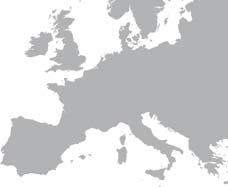

119 Annual Report IASMA Research Centre 2007
MÜNCHEN BOLZANO
TRENTO MILANO - VERONA | VENEZIA
SAN MICHELE ALL’ADIGE
ACKNOWLEDGEMENTS
Thanks to all the people who gave their time contributed material to this report, including articles, figures and data collection.
Special thanks are due to all the people who let us use their pictures for this publication. Thanks also to the FEM library for all their help and support.

121 Annual Report IASMA Research Centre 2007
The editorial staff Floriana and Lucia
Printed in July 2008


 Fondazione Edmund Mach
IASMA Research Centre
Fondazione Edmund Mach
IASMA Research Centre







 Roberto Viola
Roberto Viola
 Dr. Roberto Viola Research Centre Director
Dr. Roberto Viola Research Centre Director































 Agostino Cavazza Raffaele Guzzon
Agostino Cavazza Raffaele Guzzon


 Giorgio Nicolini
Giorgio Nicolini
 Daniela Bertoldi Roberto Larcher
Daniela Bertoldi Roberto Larcher






 Flavia Gasperi
Flavia Gasperi




























 Giulia Malacarne
Flavia Moreira Michele Perazzolli
Giulia Malacarne
Flavia Moreira Michele Perazzolli









 Elena Zini Franco Biasioli
Elena Zini Franco Biasioli





 Paolo Fontana, Alessandro Cestaro
Paolo Fontana, Alessandro Cestaro
 Michele Perazzolli, Federica Bampi, Anna Maria Ciccotti, Ilaria Pertot, Claudio Moser
Michele Perazzolli, Federica Bampi, Anna Maria Ciccotti, Ilaria Pertot, Claudio Moser
 Lucia Martinelli, Lorenza Dalla Costa, Ilaria Vaccari, Valentino Poletti
Lucia Martinelli, Lorenza Dalla Costa, Ilaria Vaccari, Valentino Poletti











 Silvia Silvestri Luca Grandi
Silvia Silvestri Luca Grandi




























 Ilaria Pertot
Ilaria Pertot







 Michele Perazzolli, Chiara Pellegrini, Claudio Moser, Ilaria Pertot
Michele Perazzolli, Chiara Pellegrini, Claudio Moser, Ilaria Pertot



 Heinz Saedler
Heinz Saedler






















